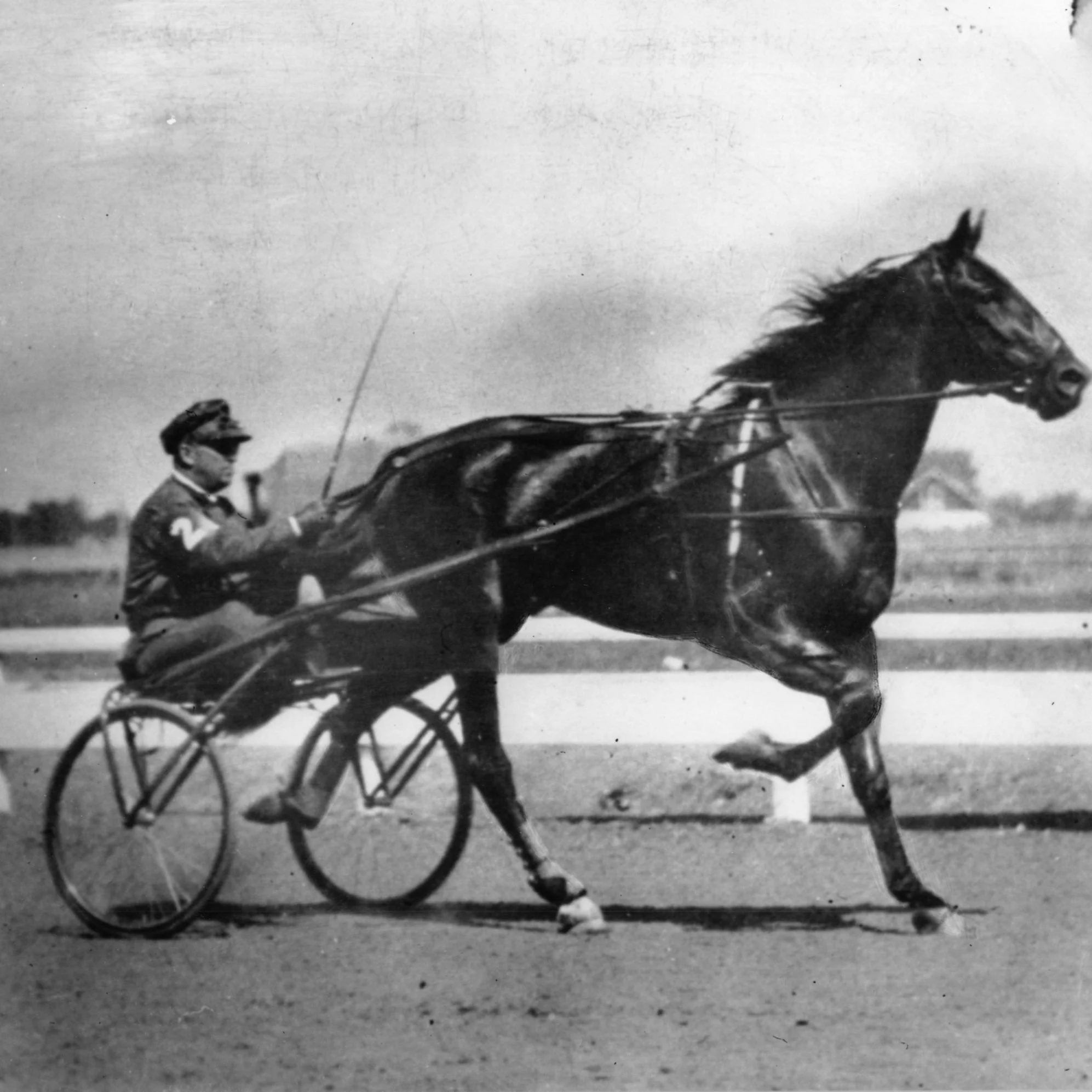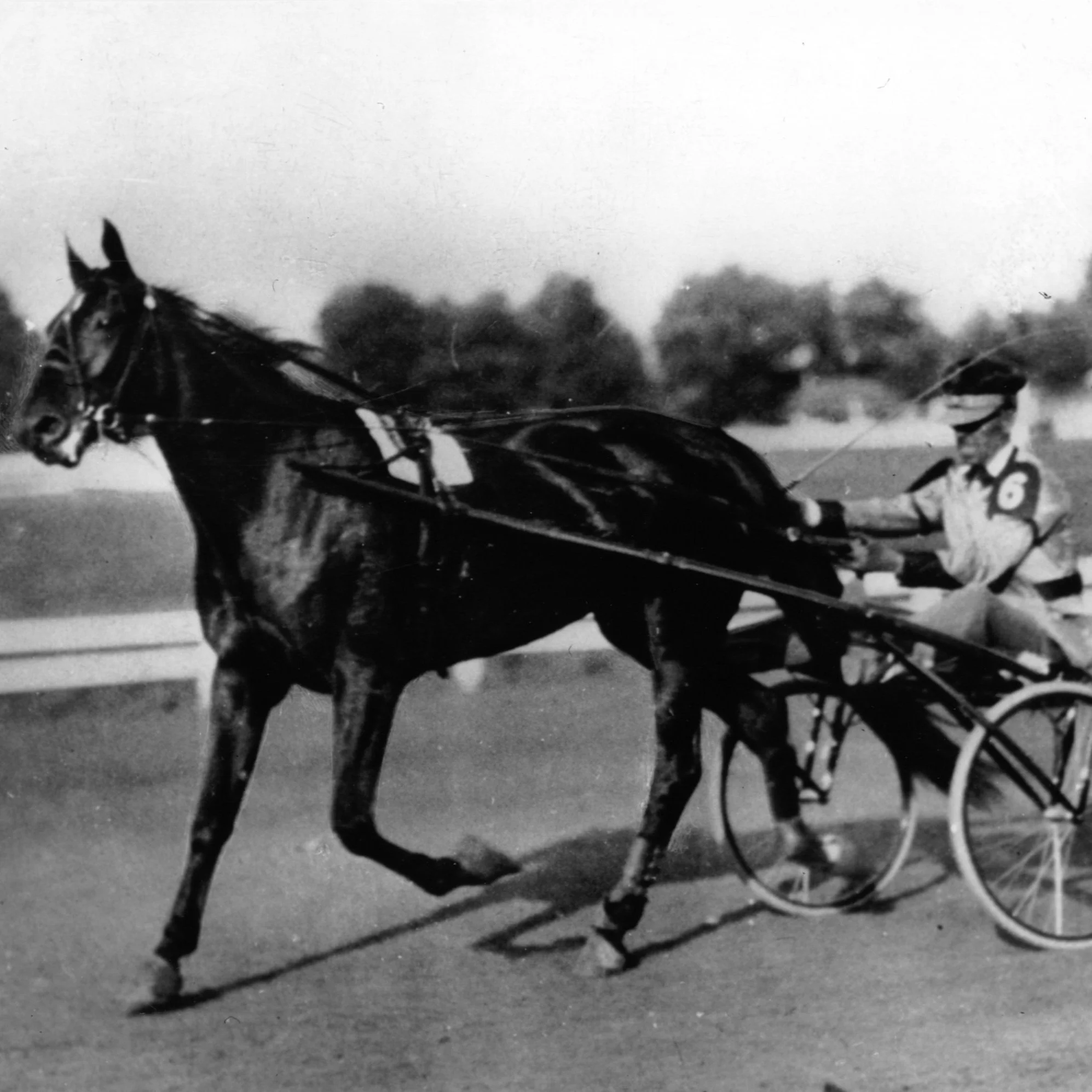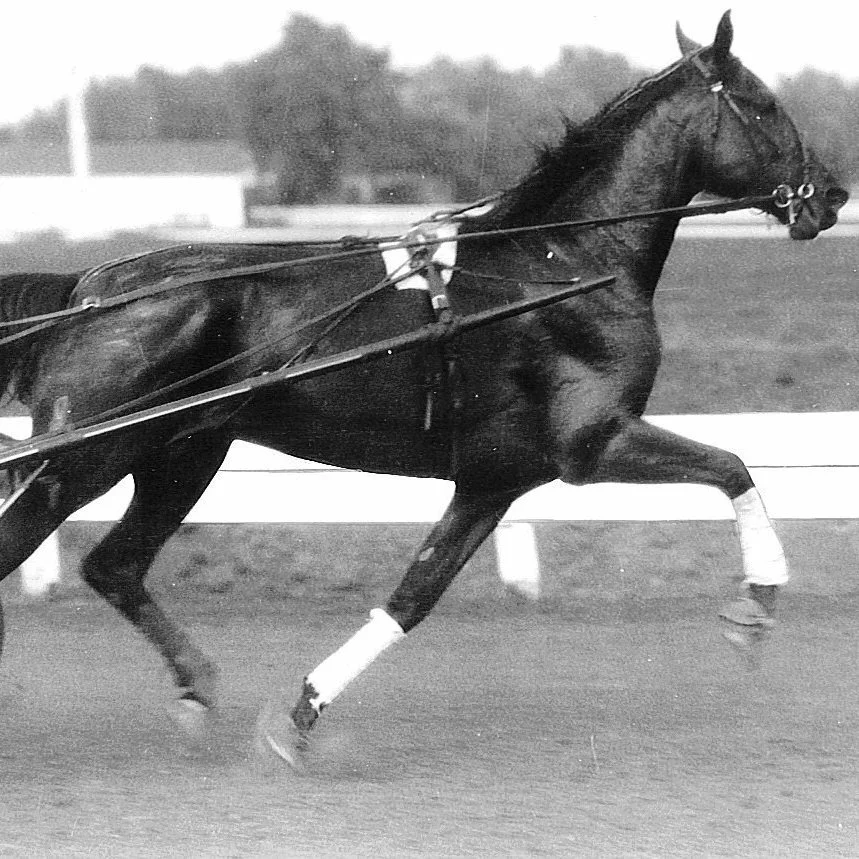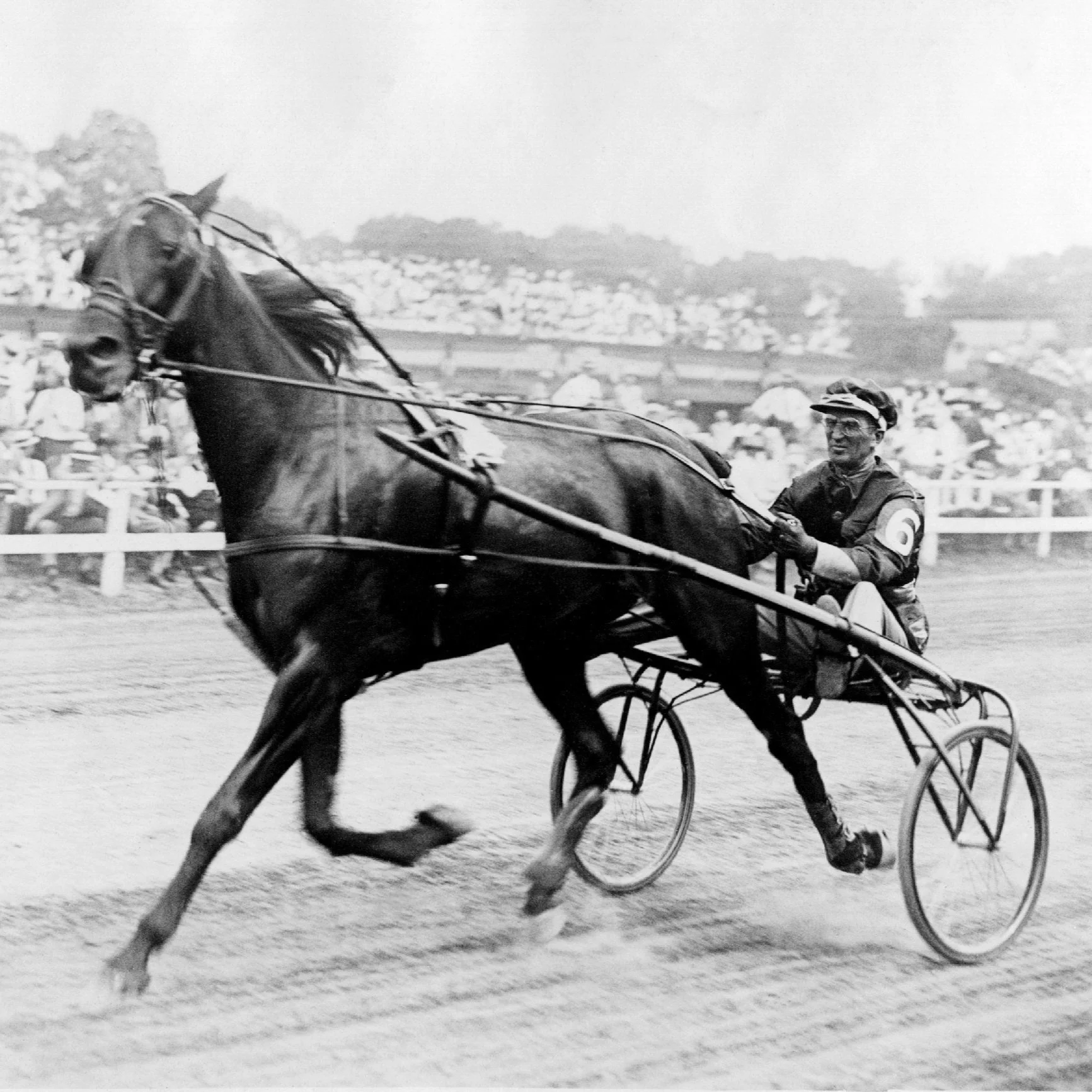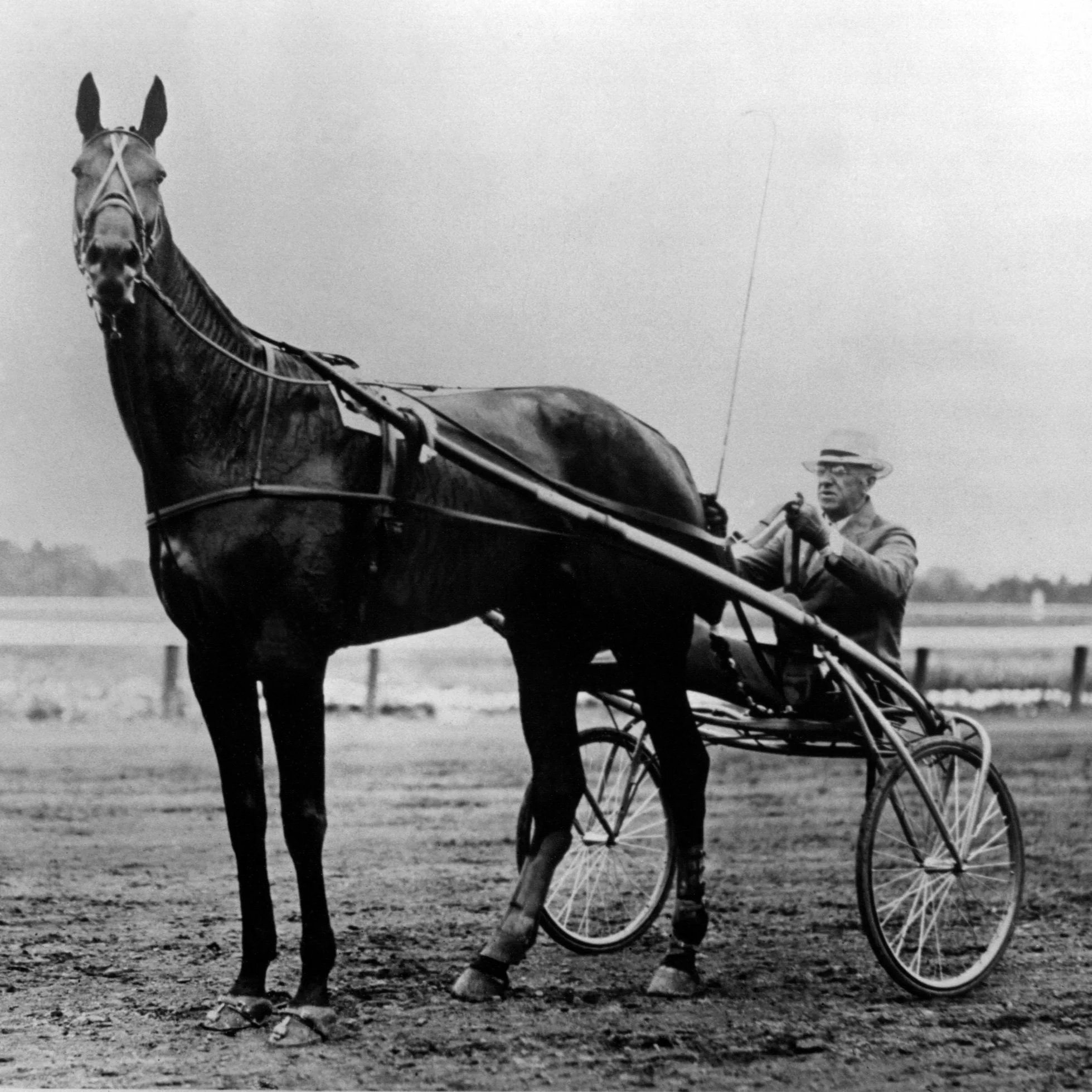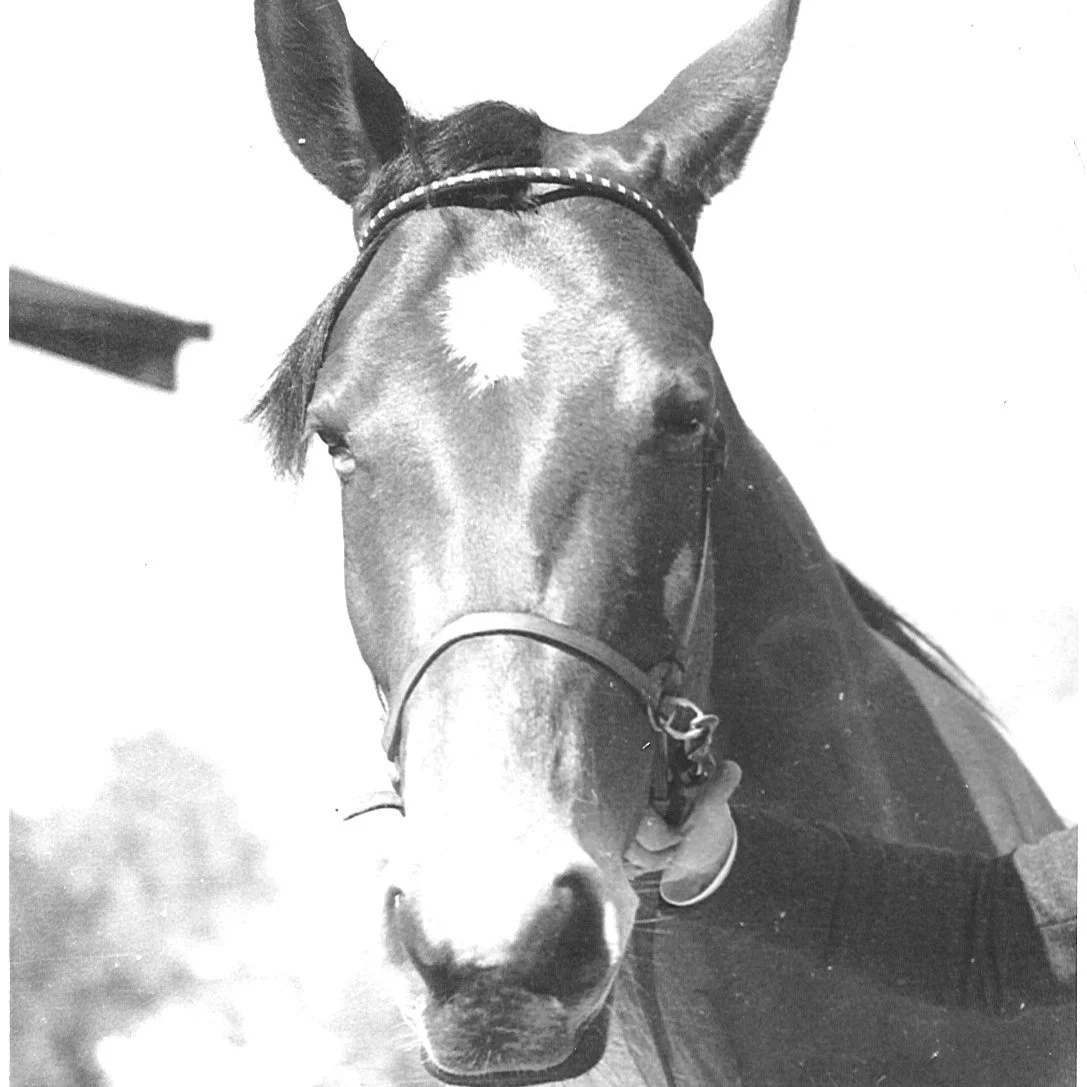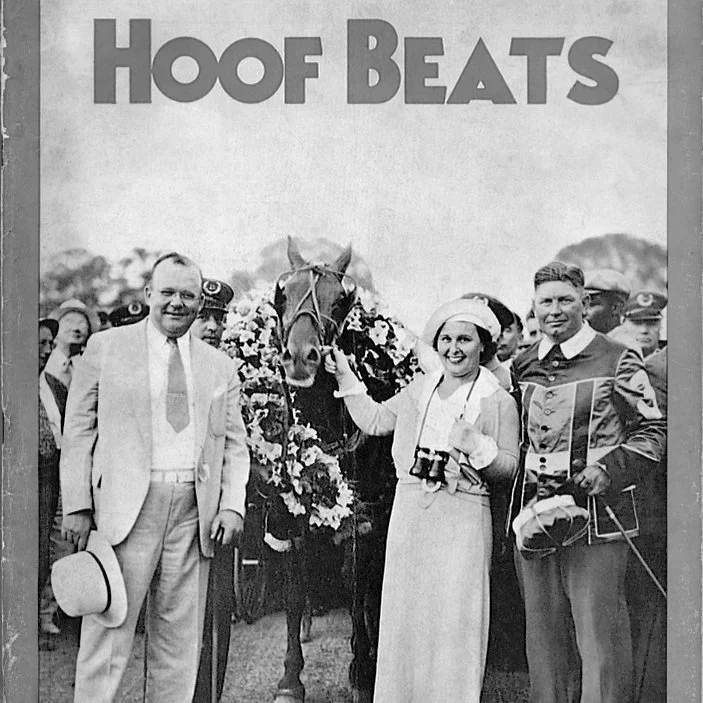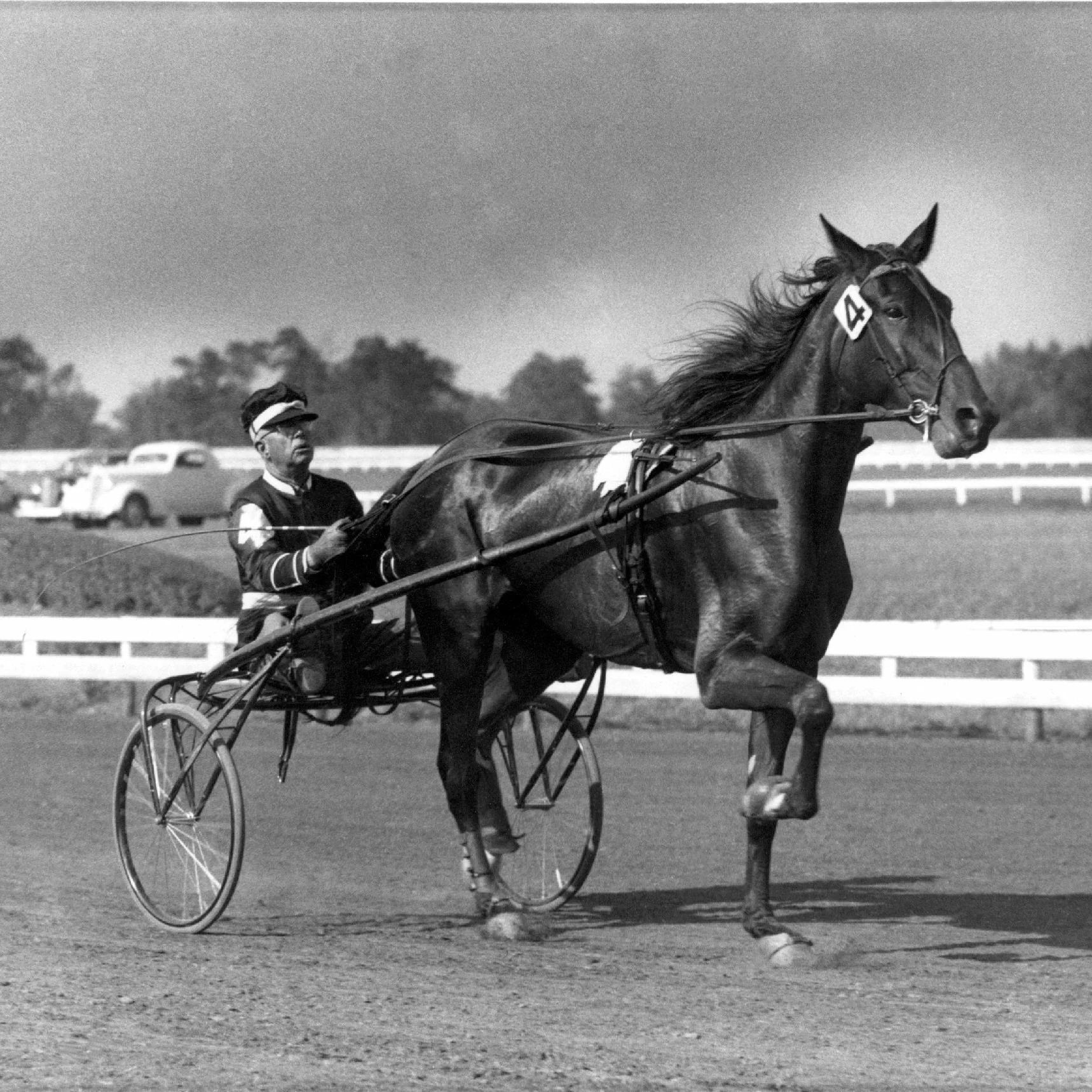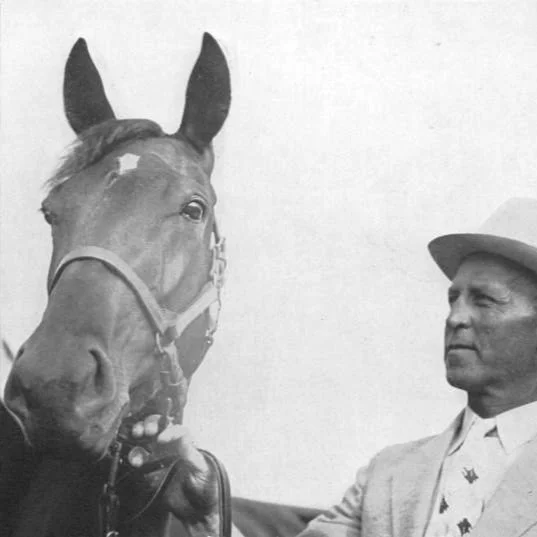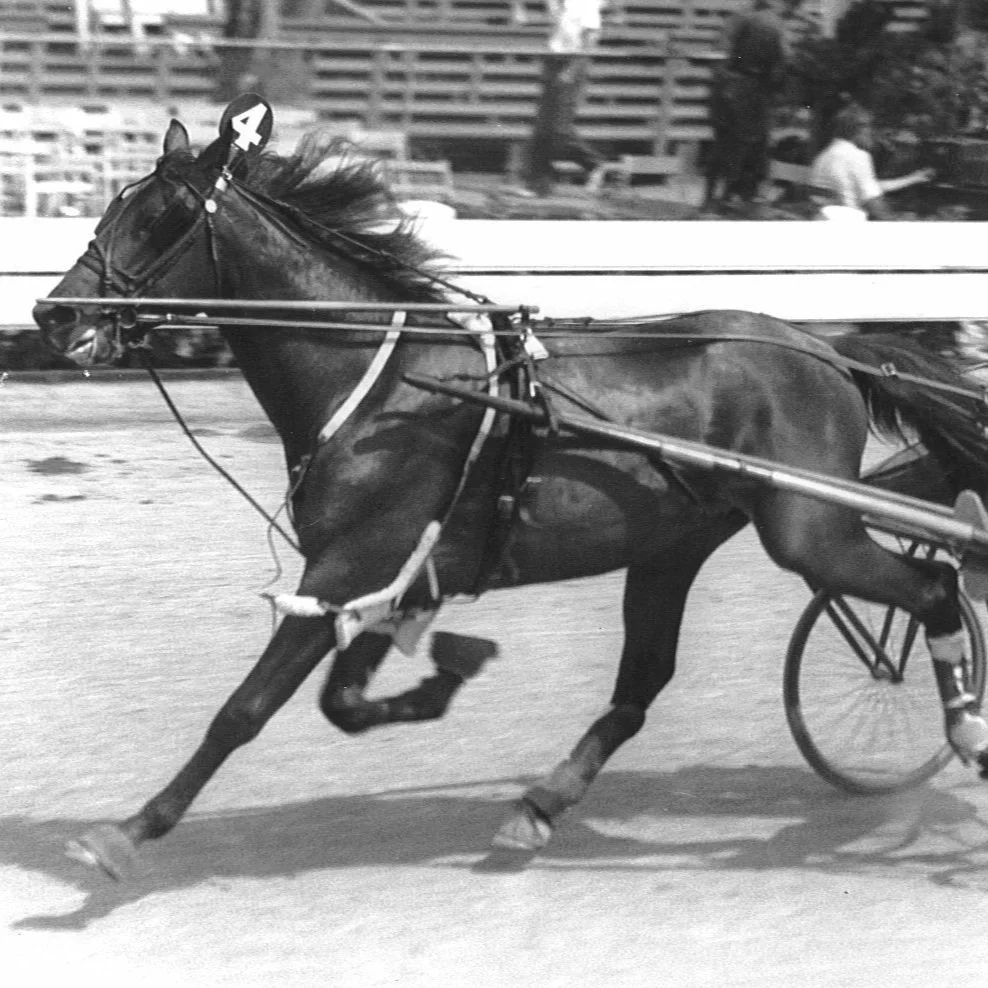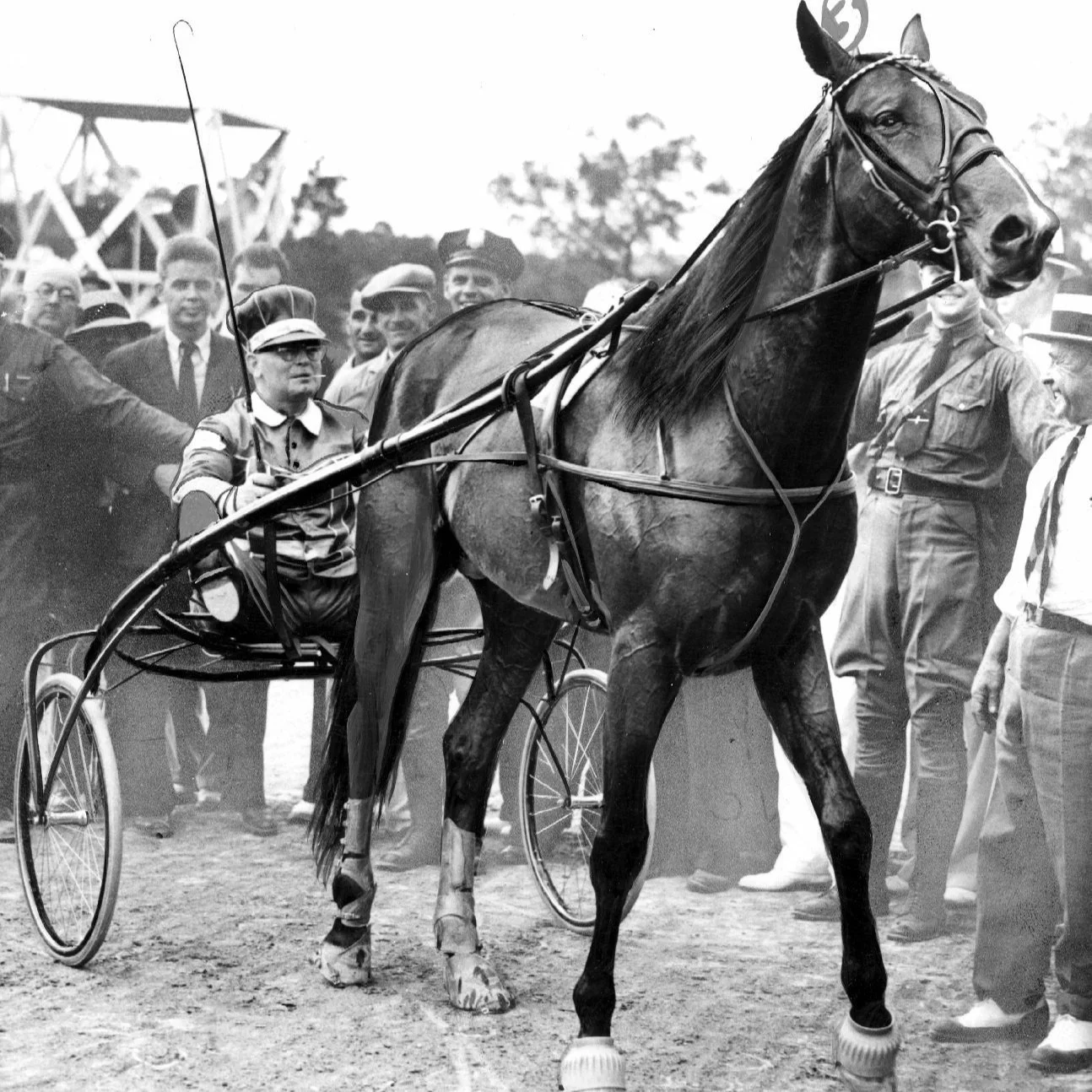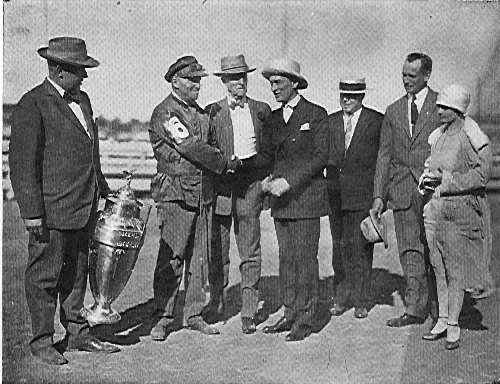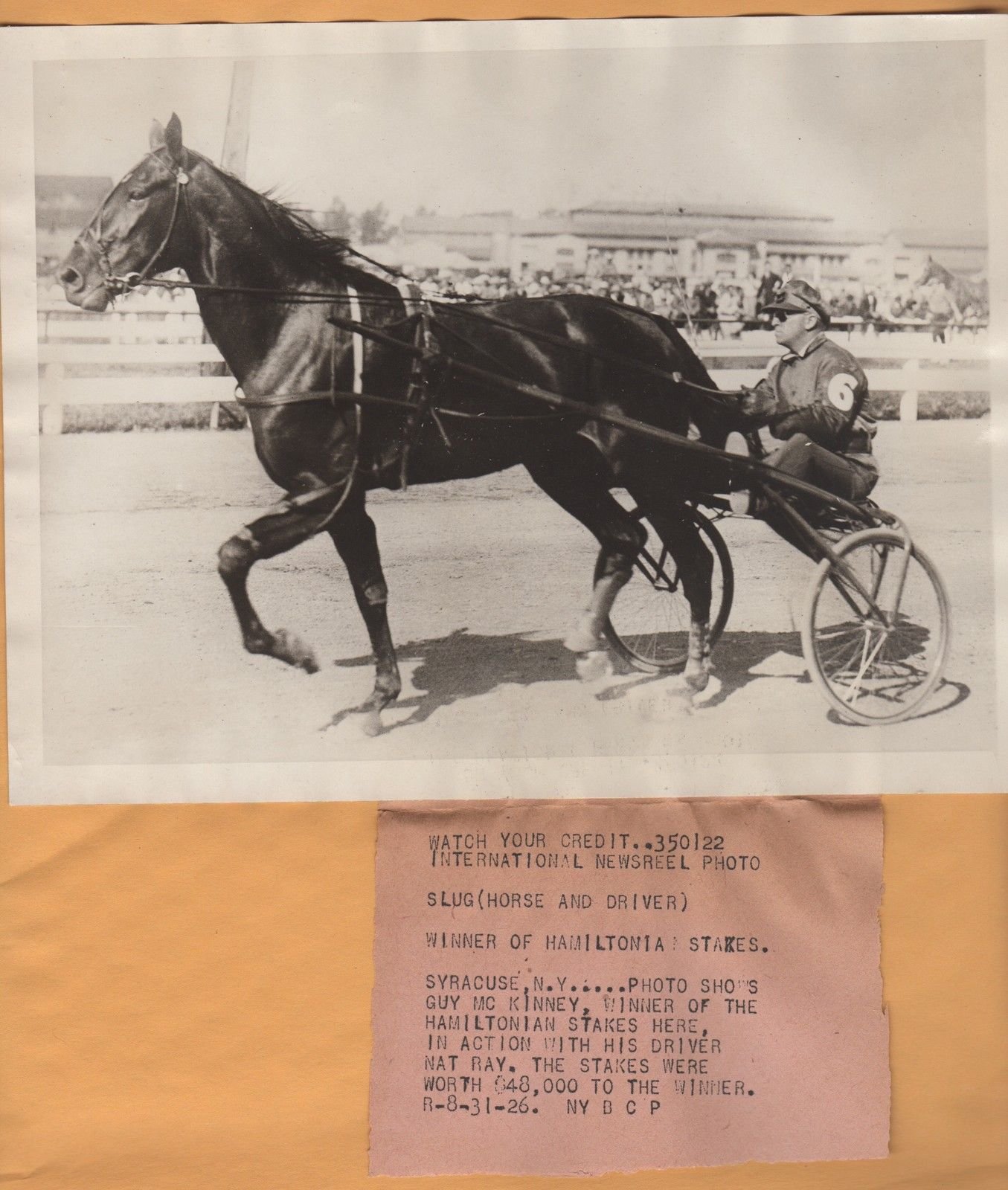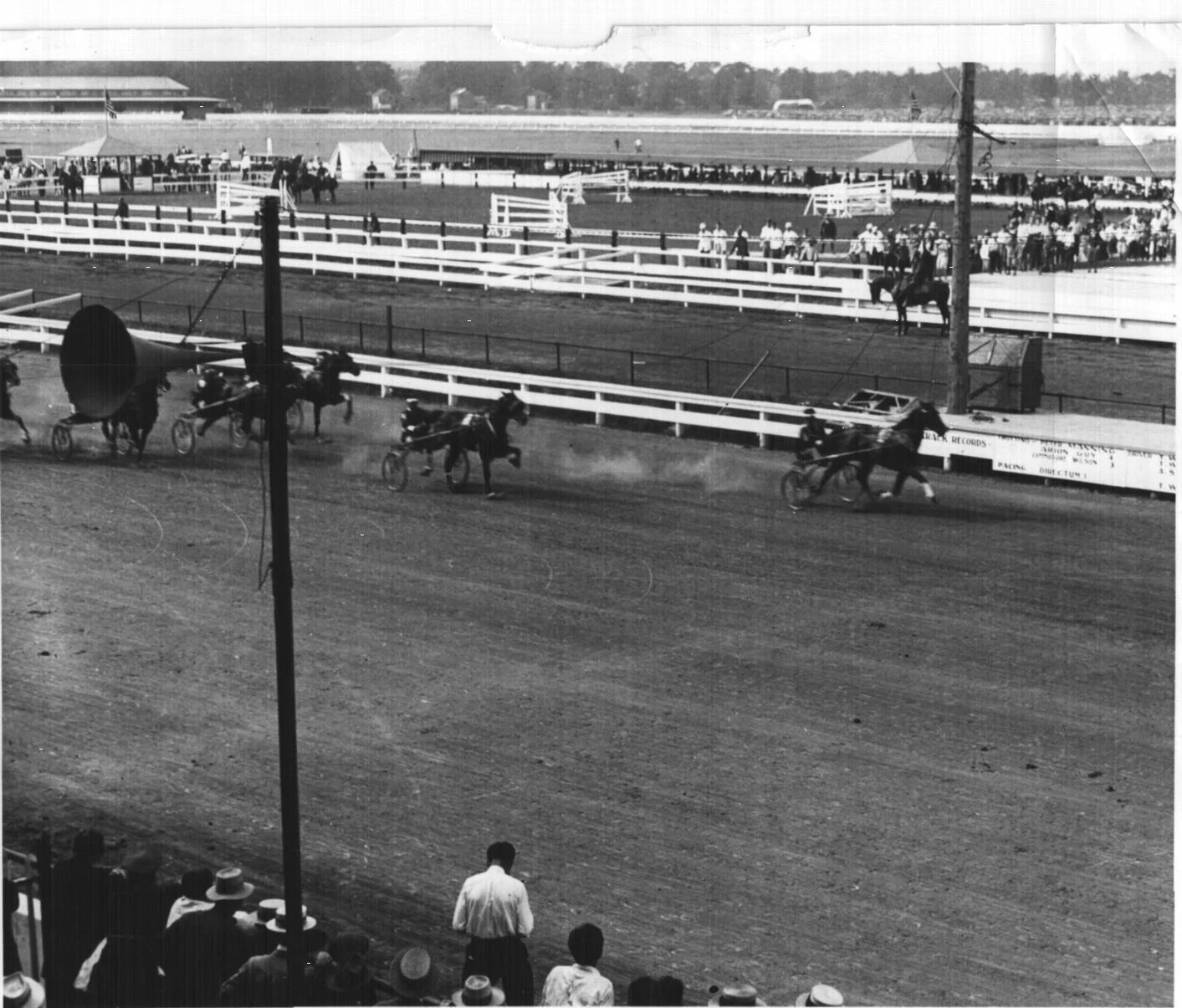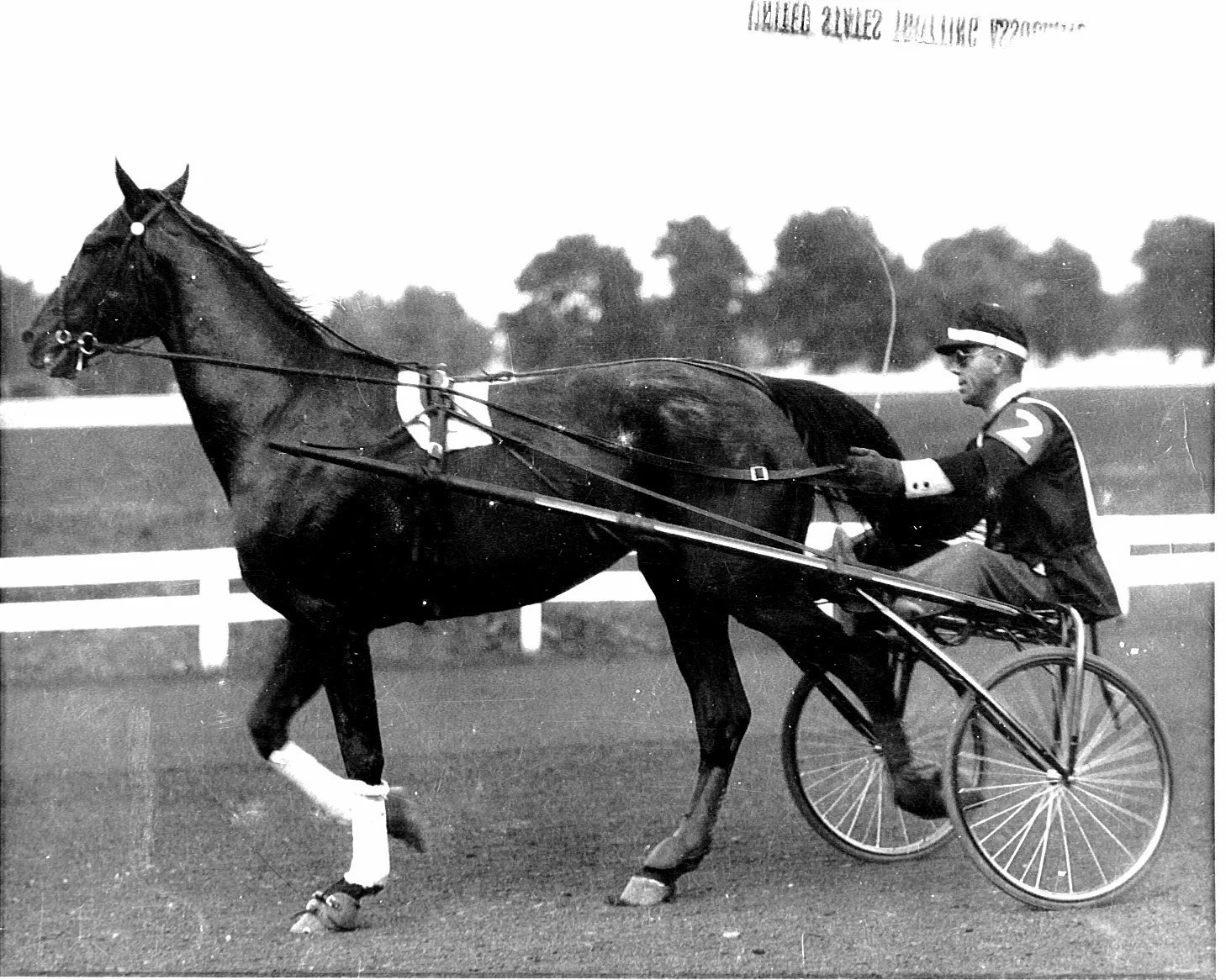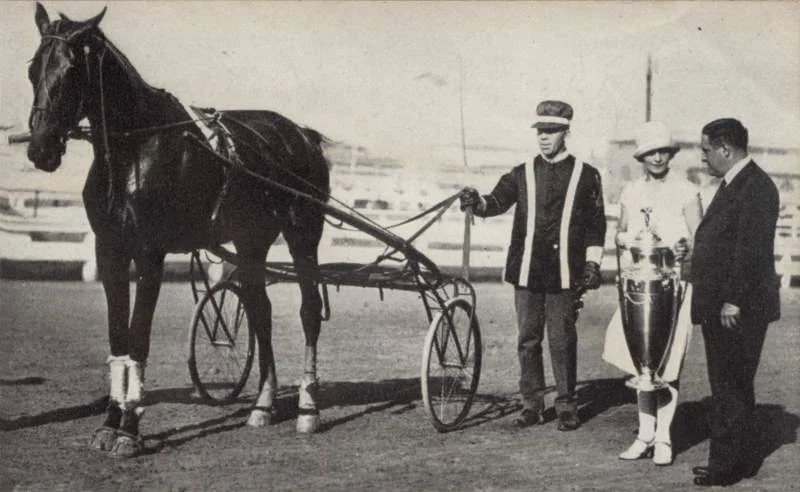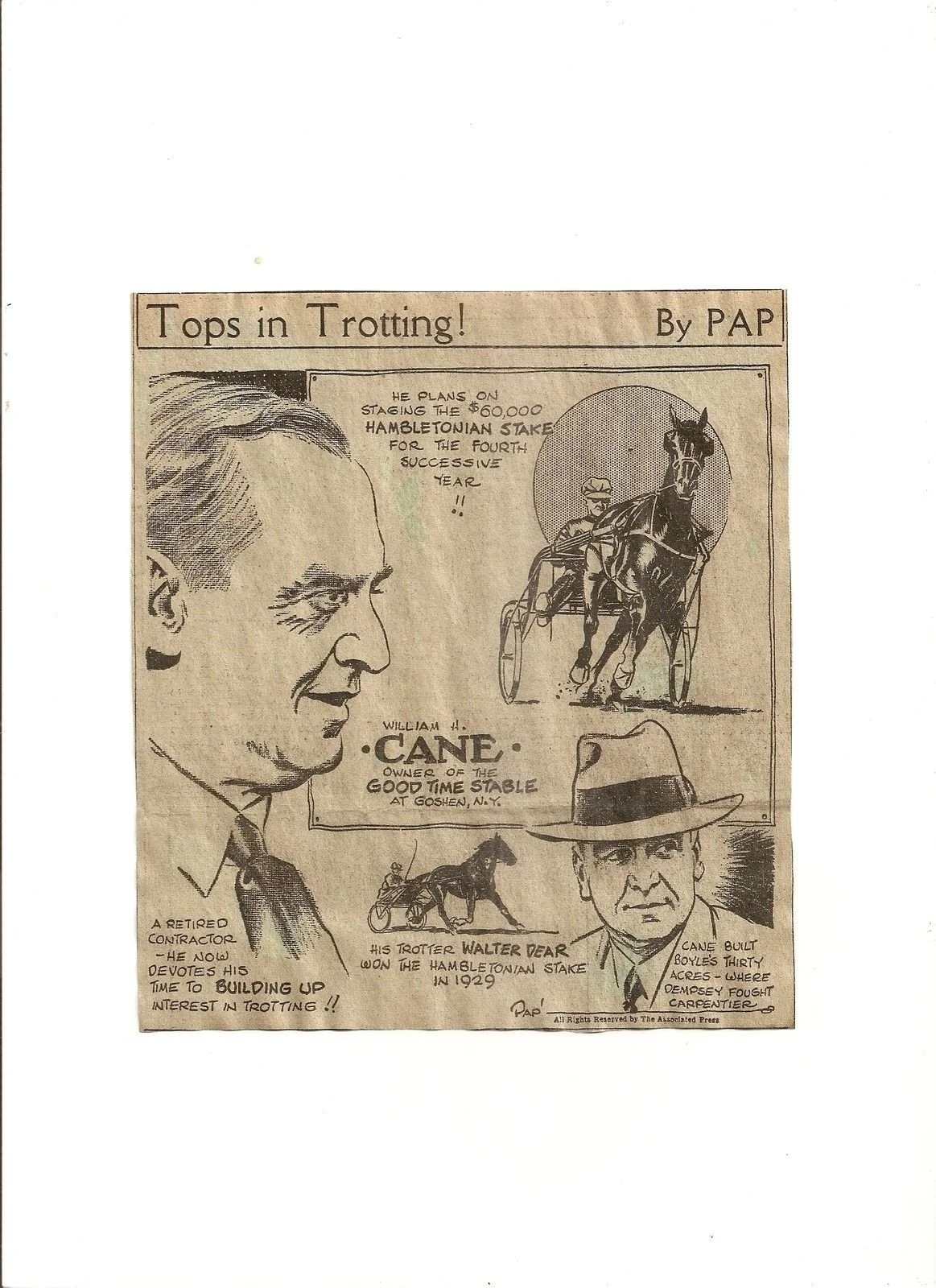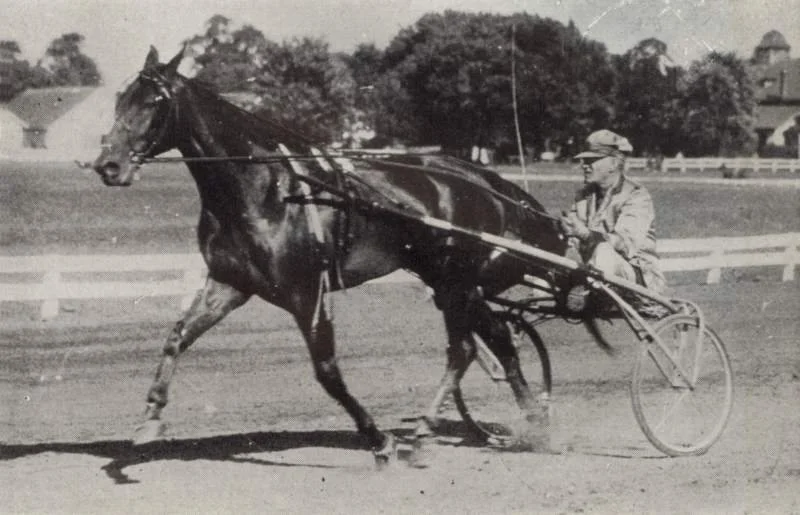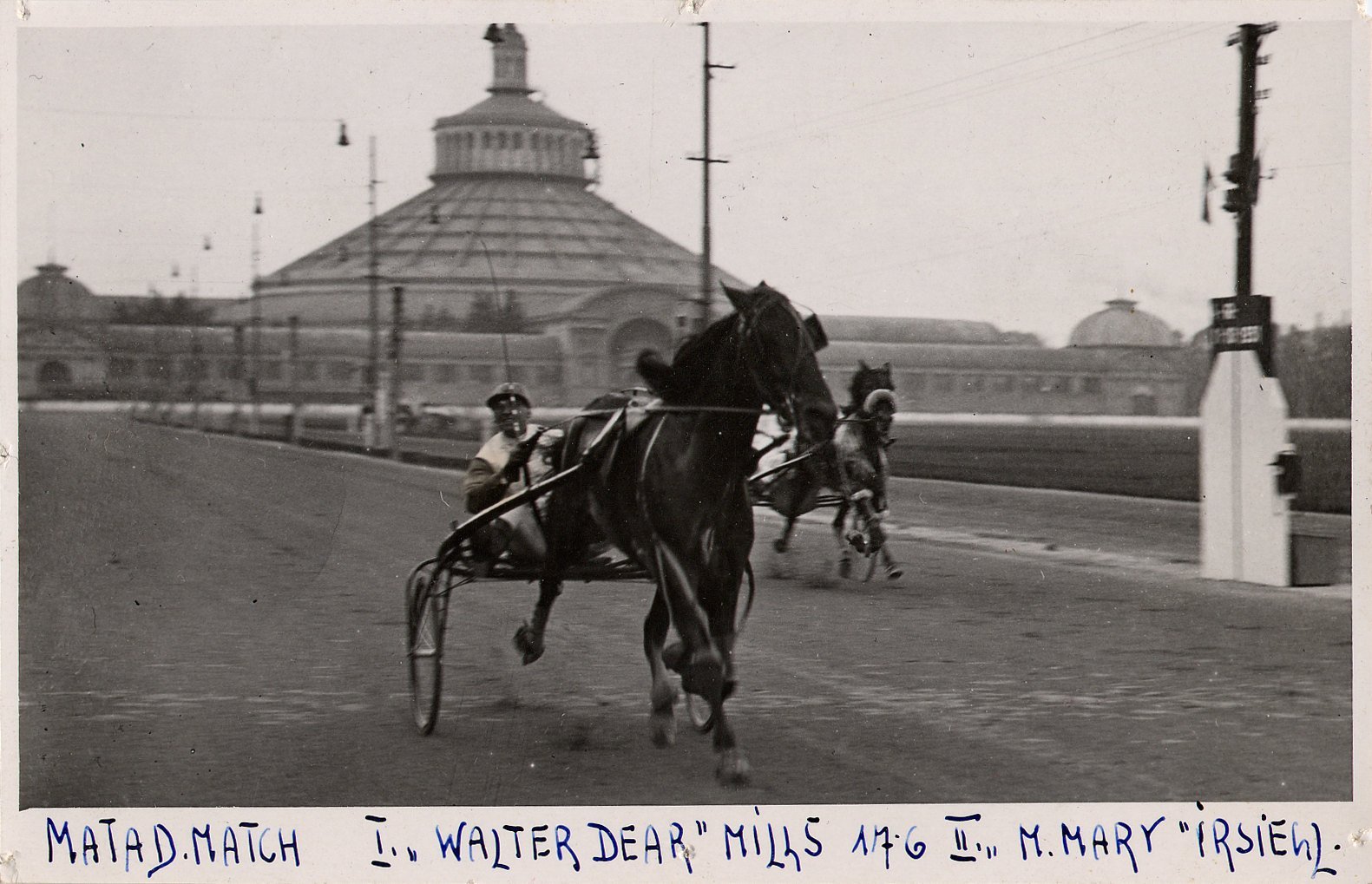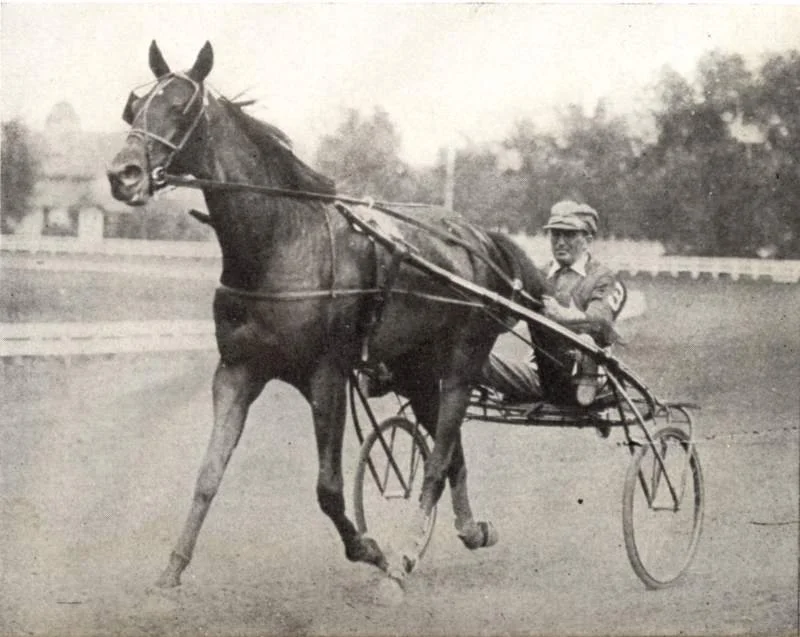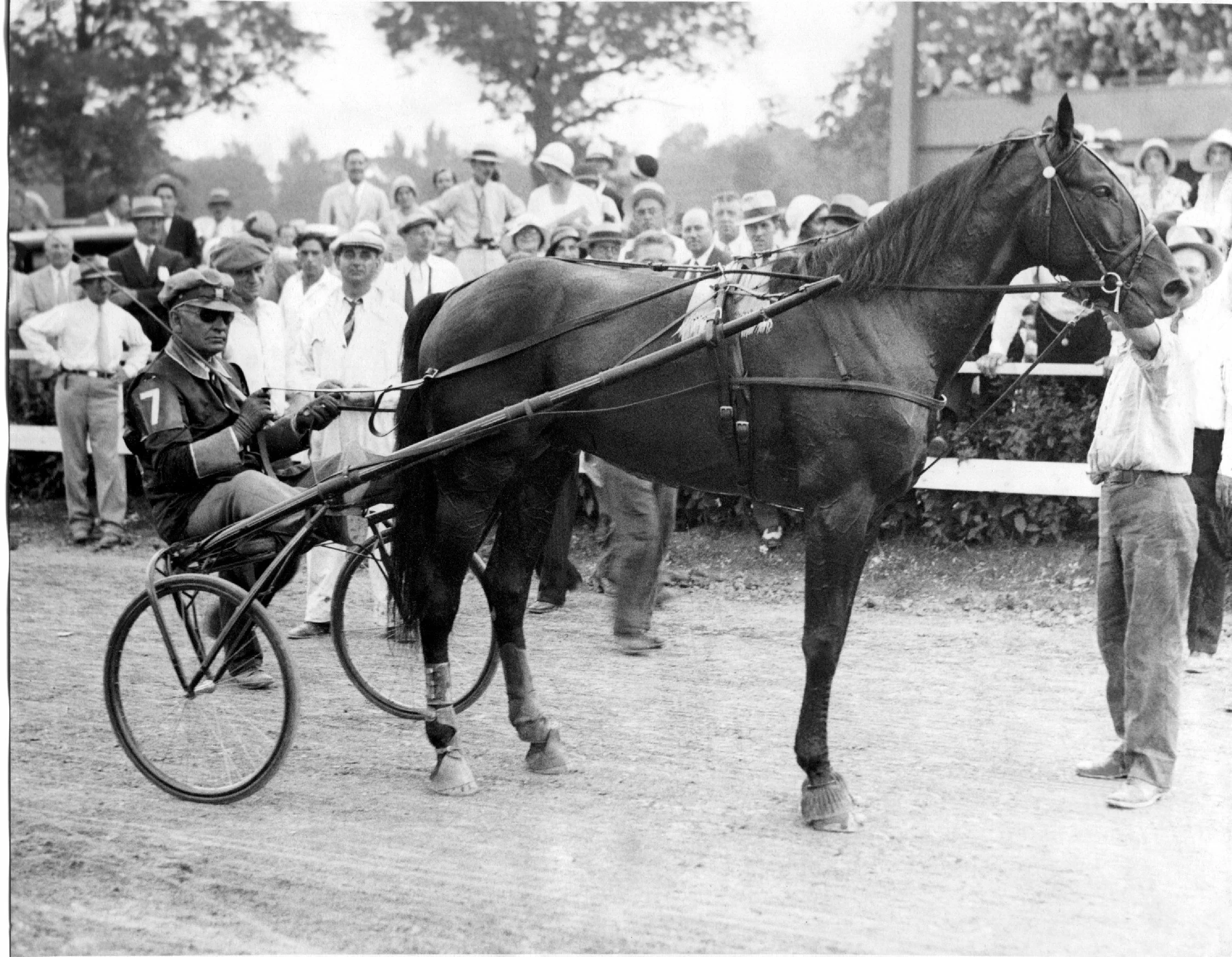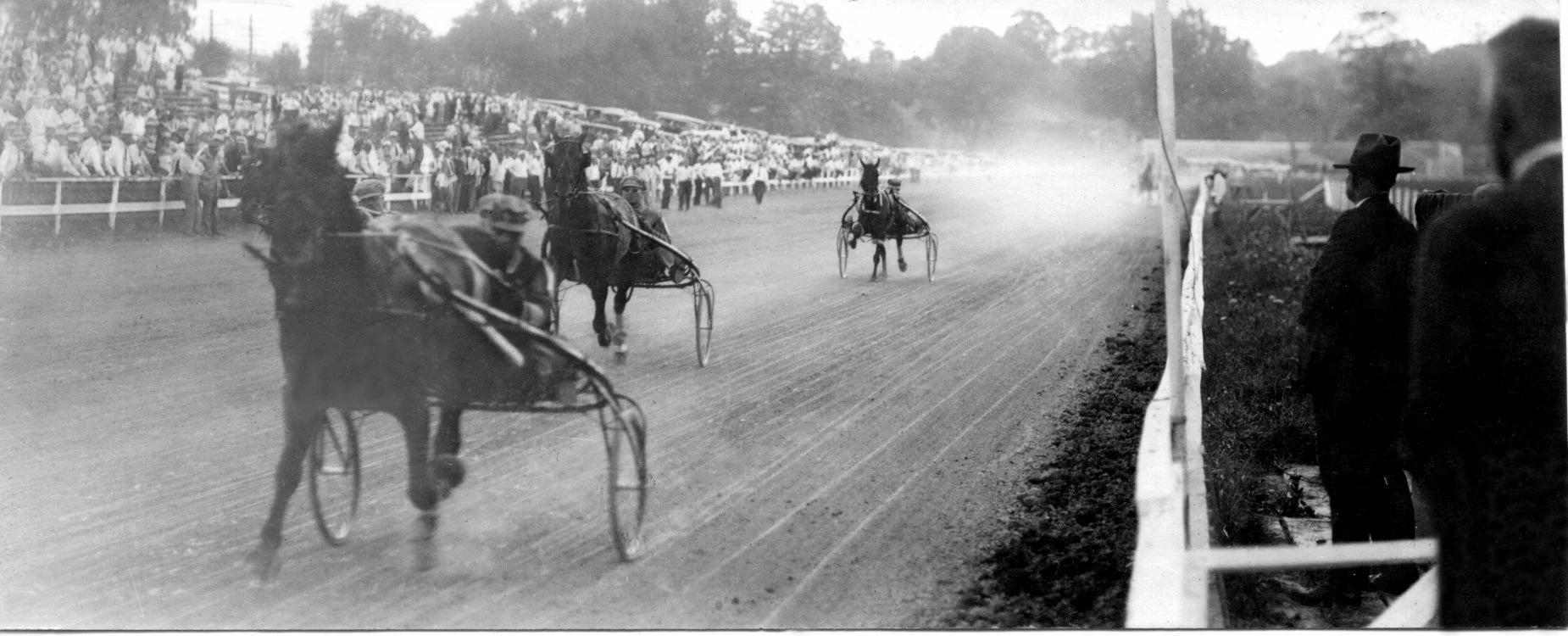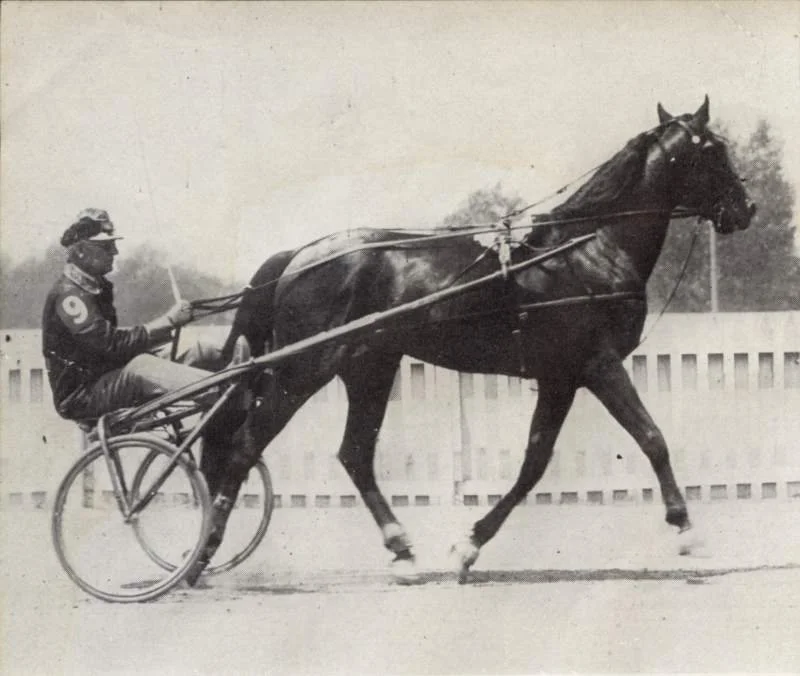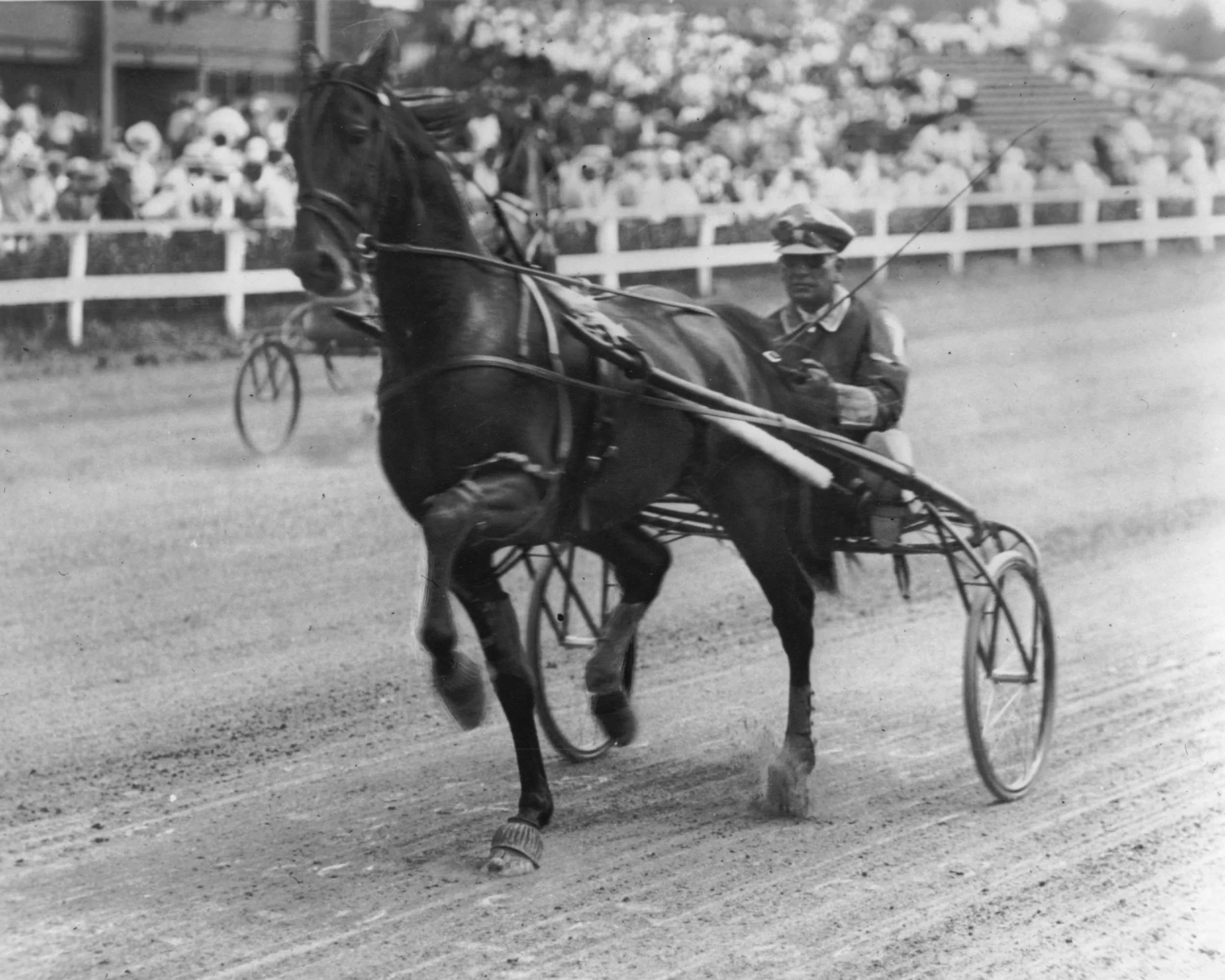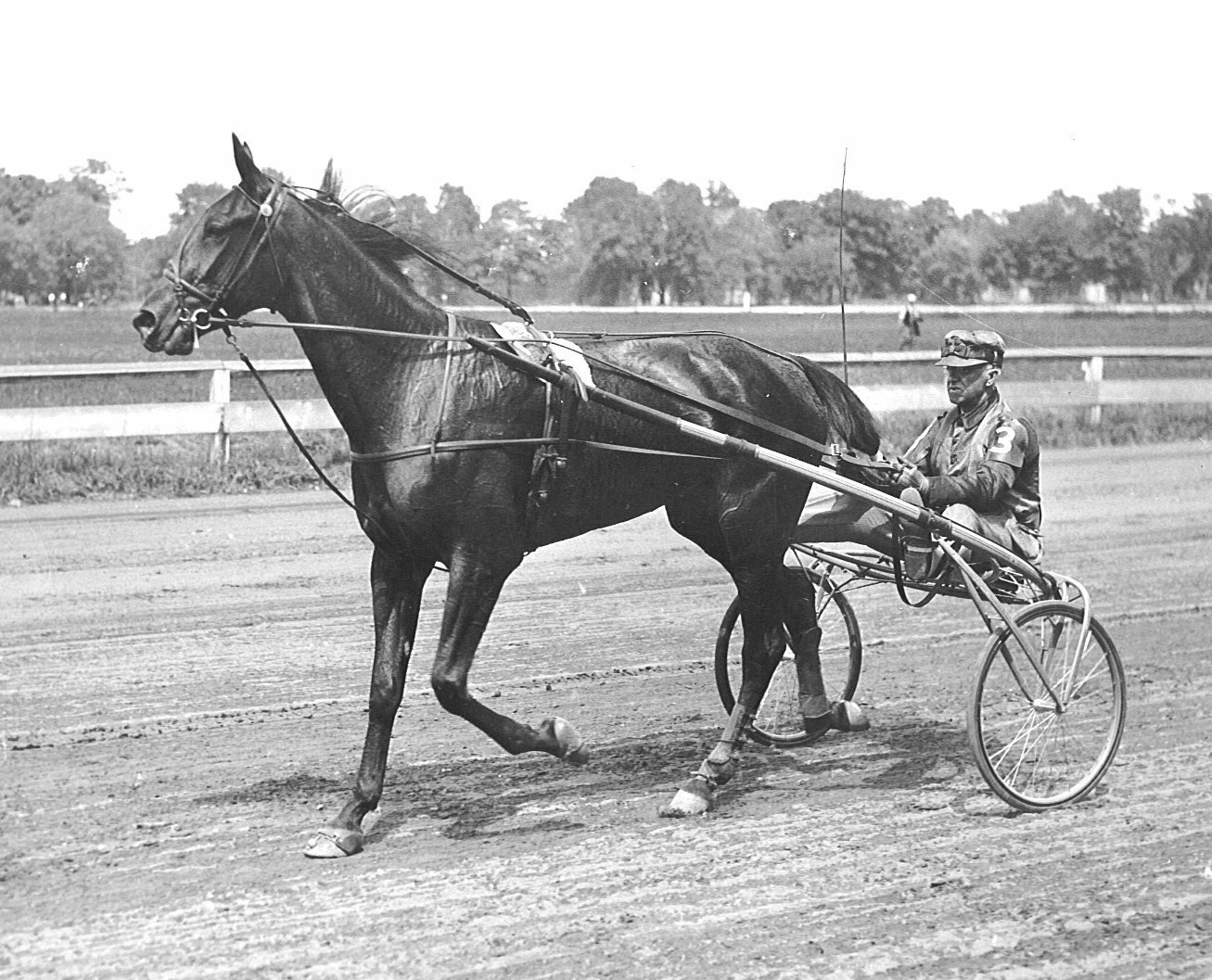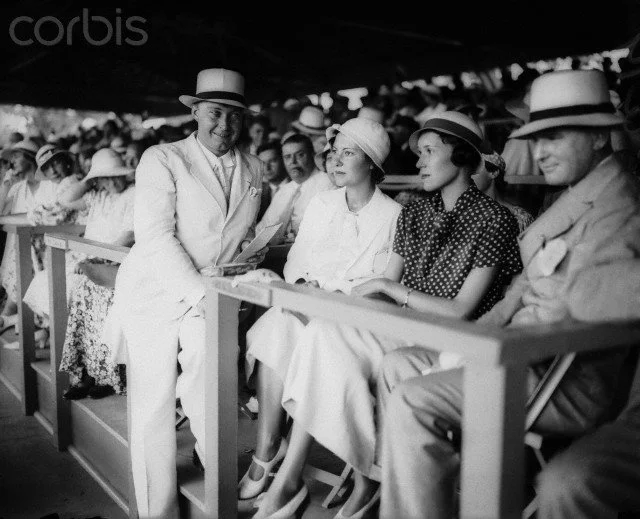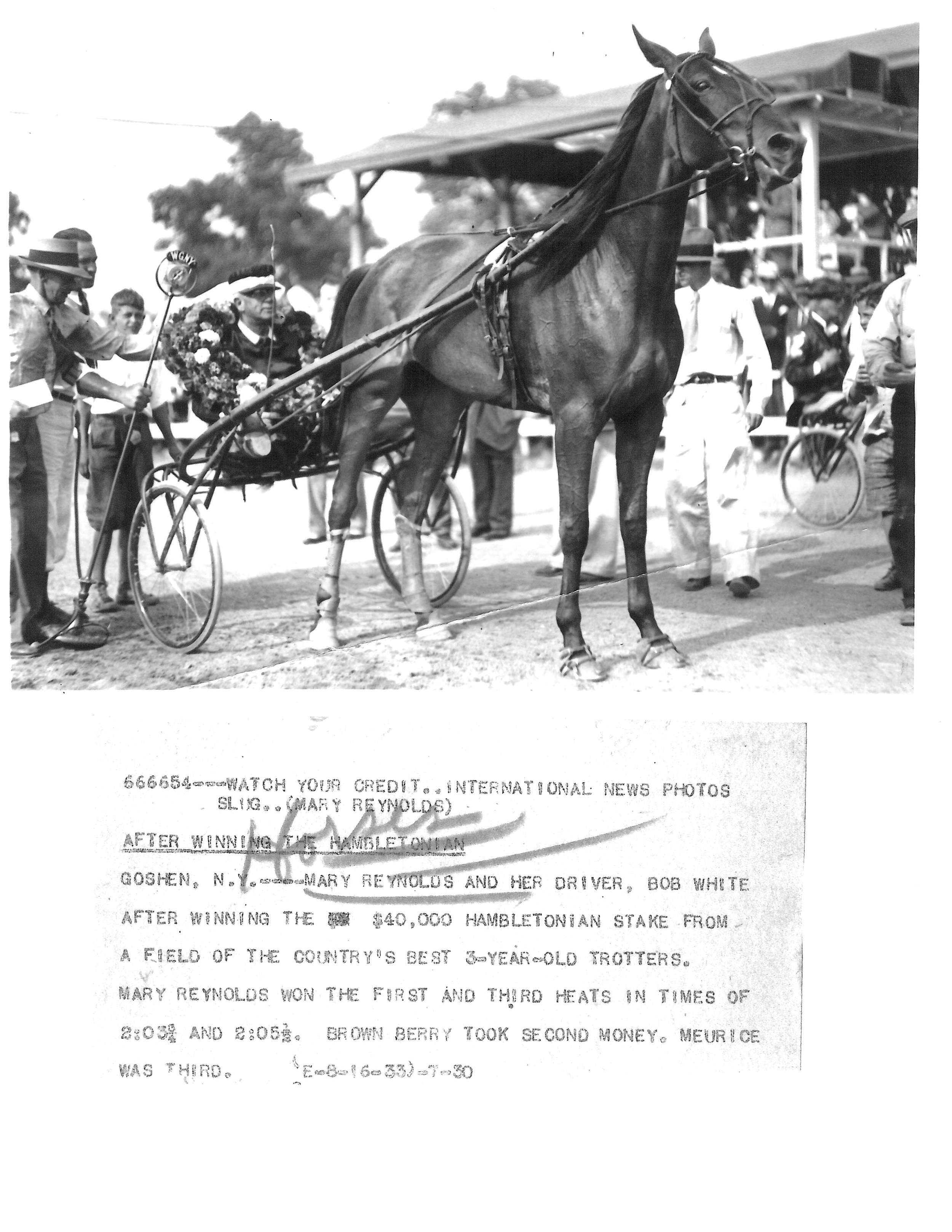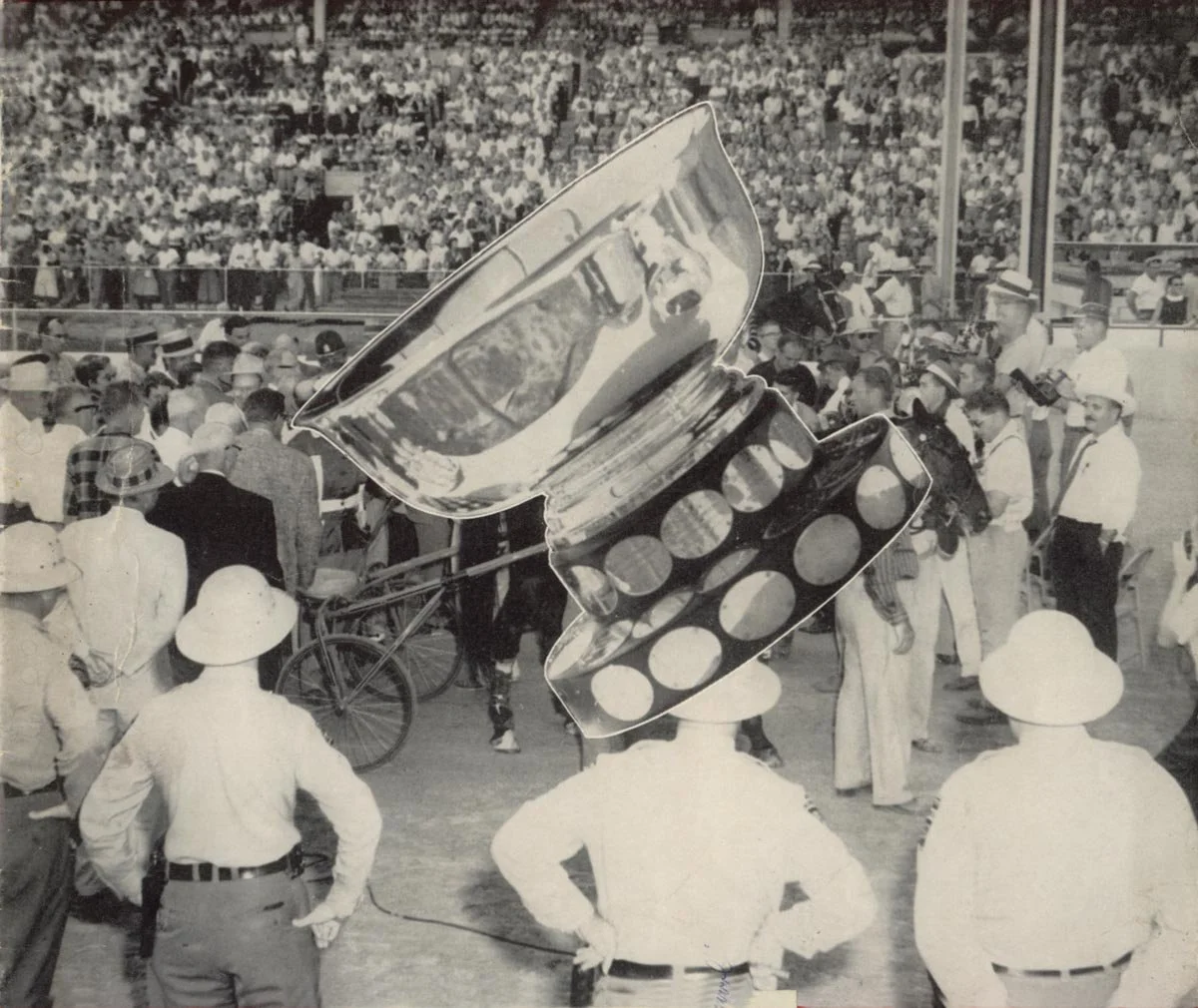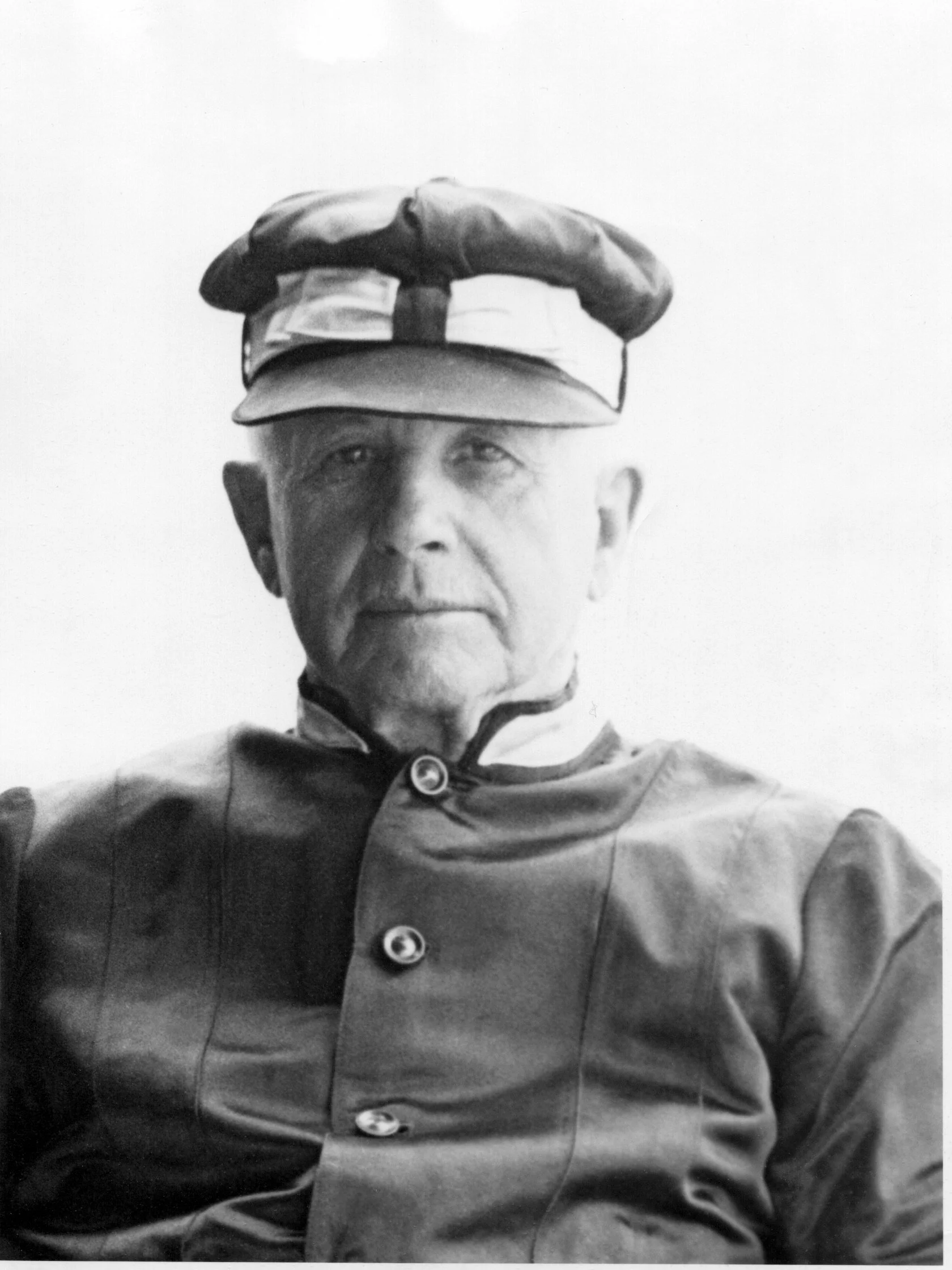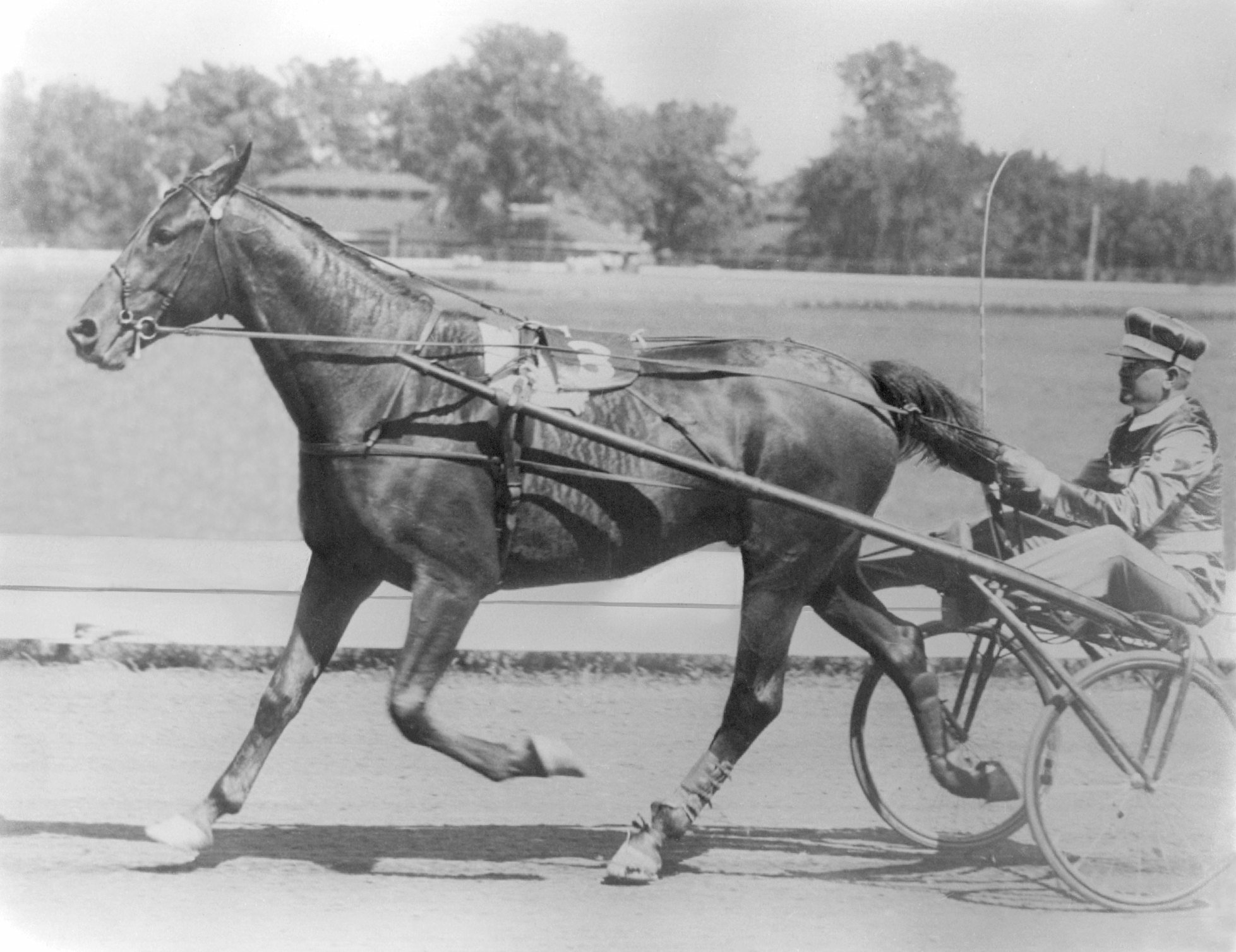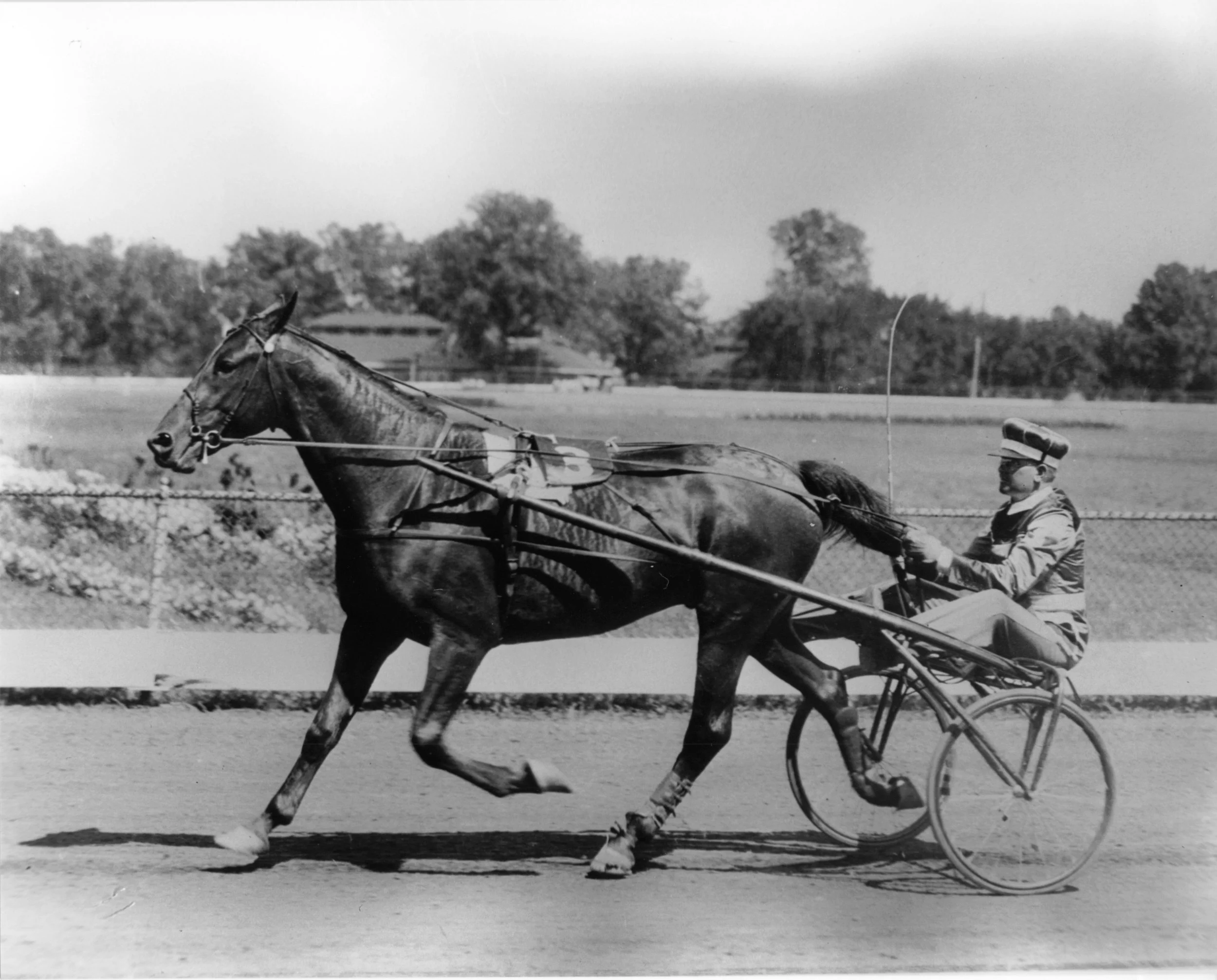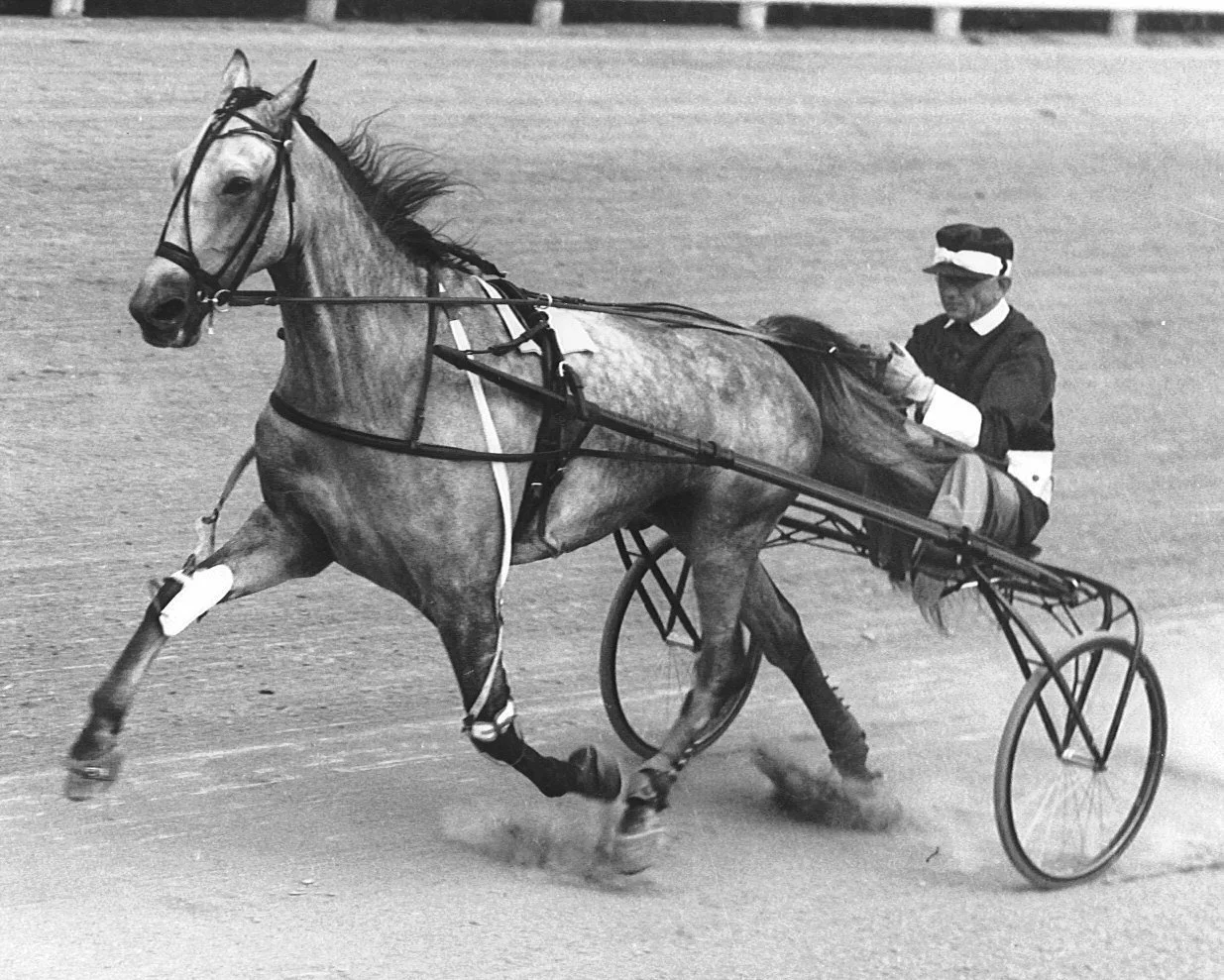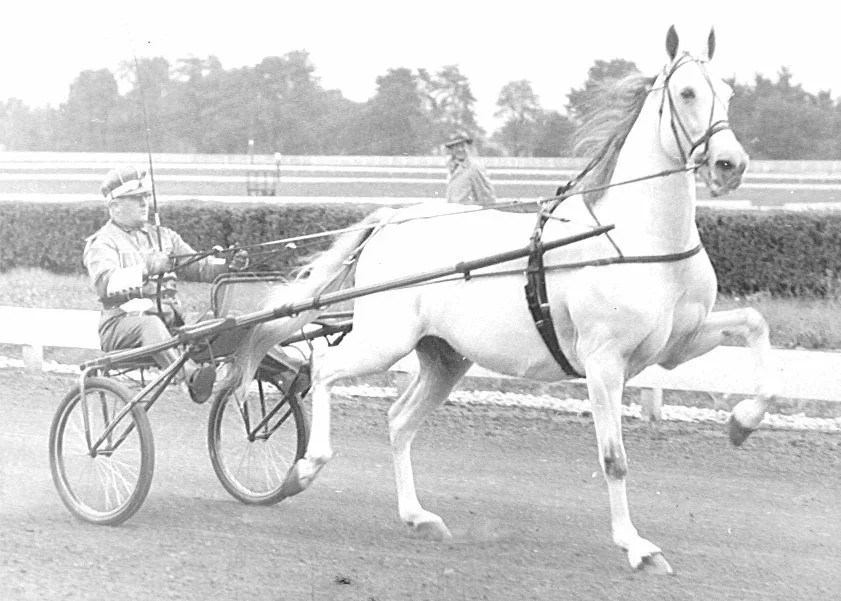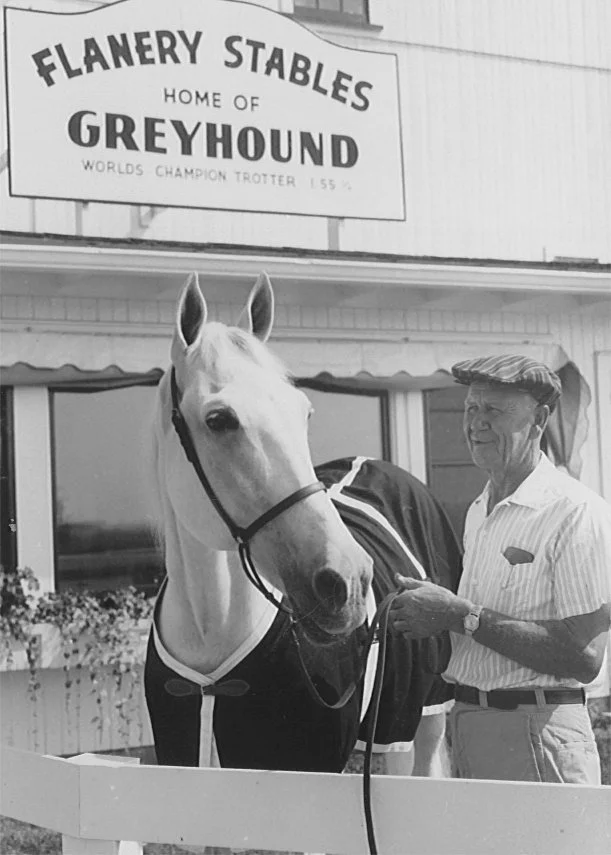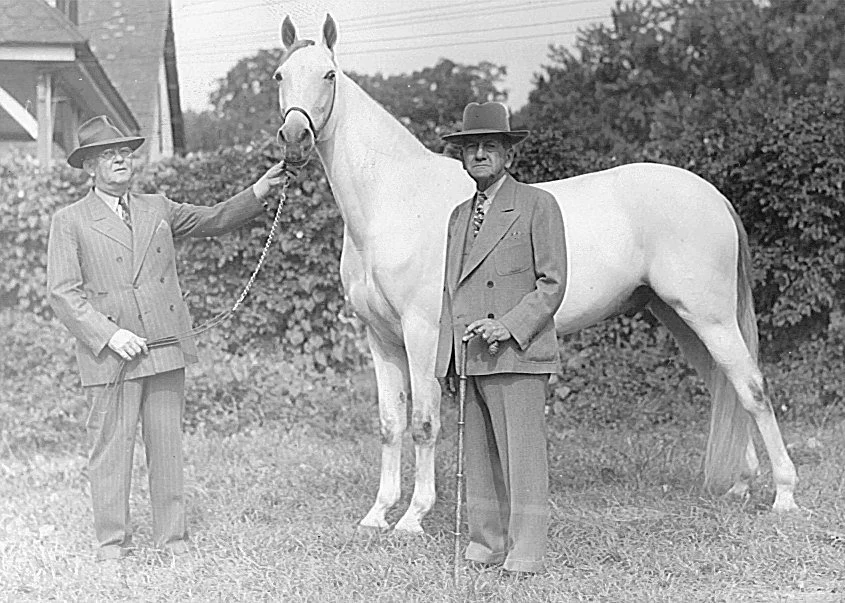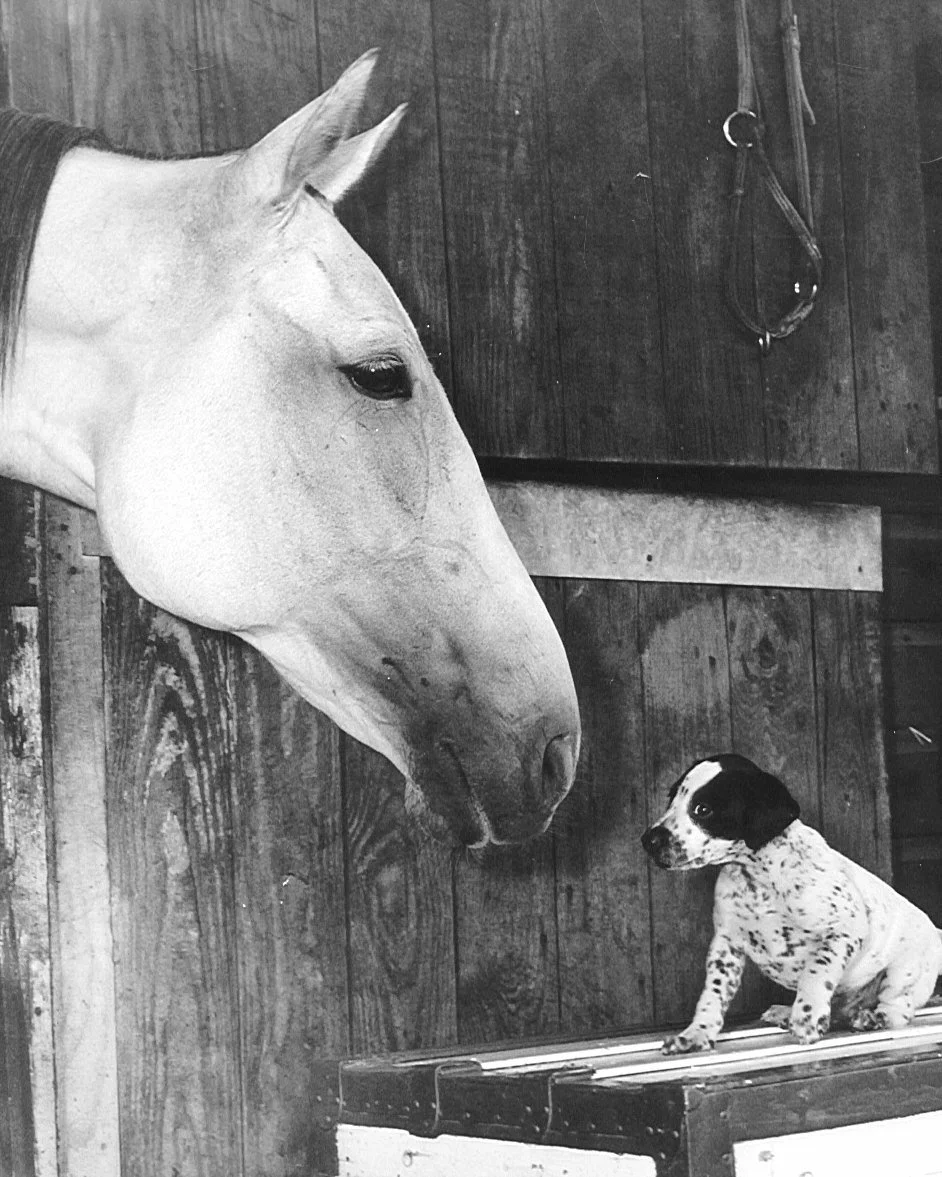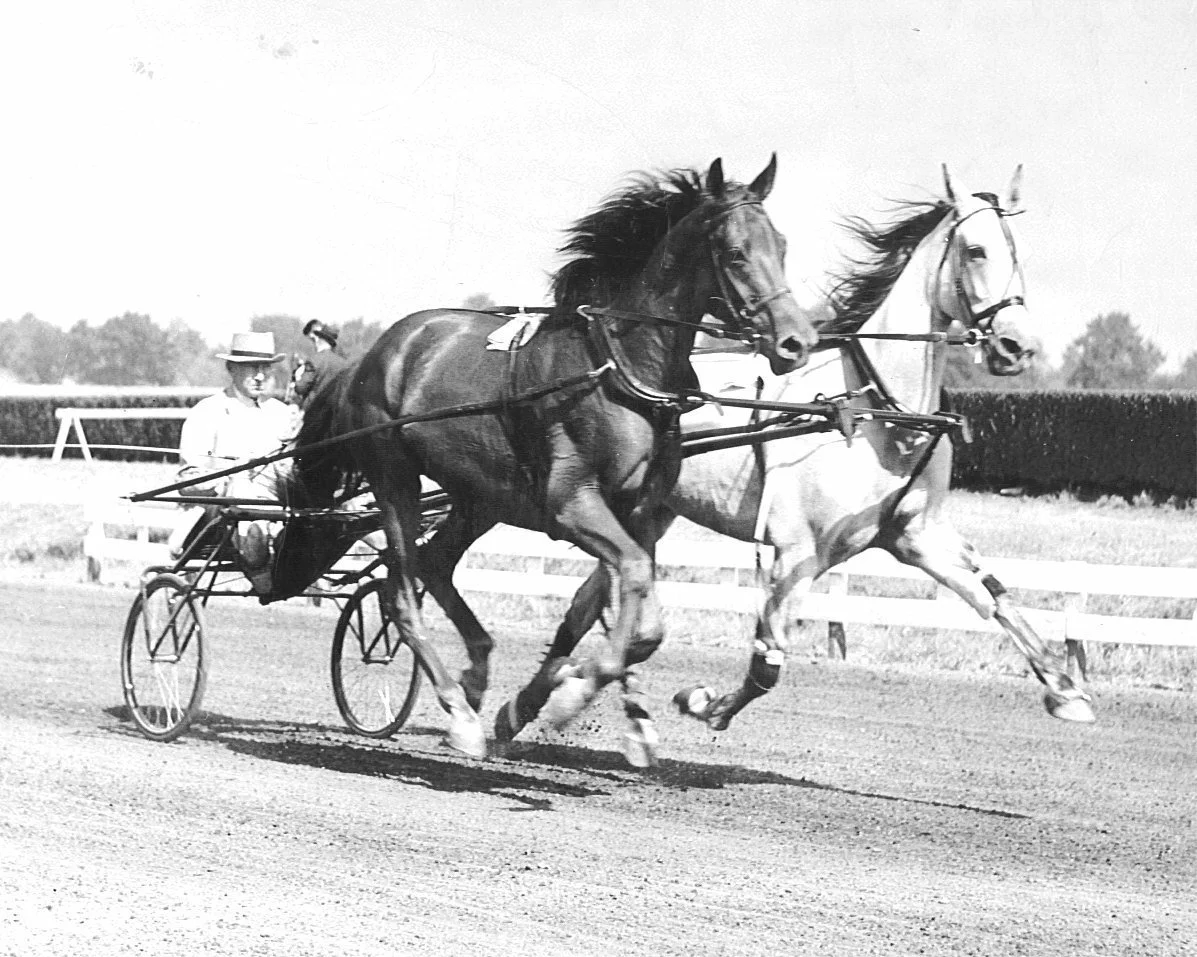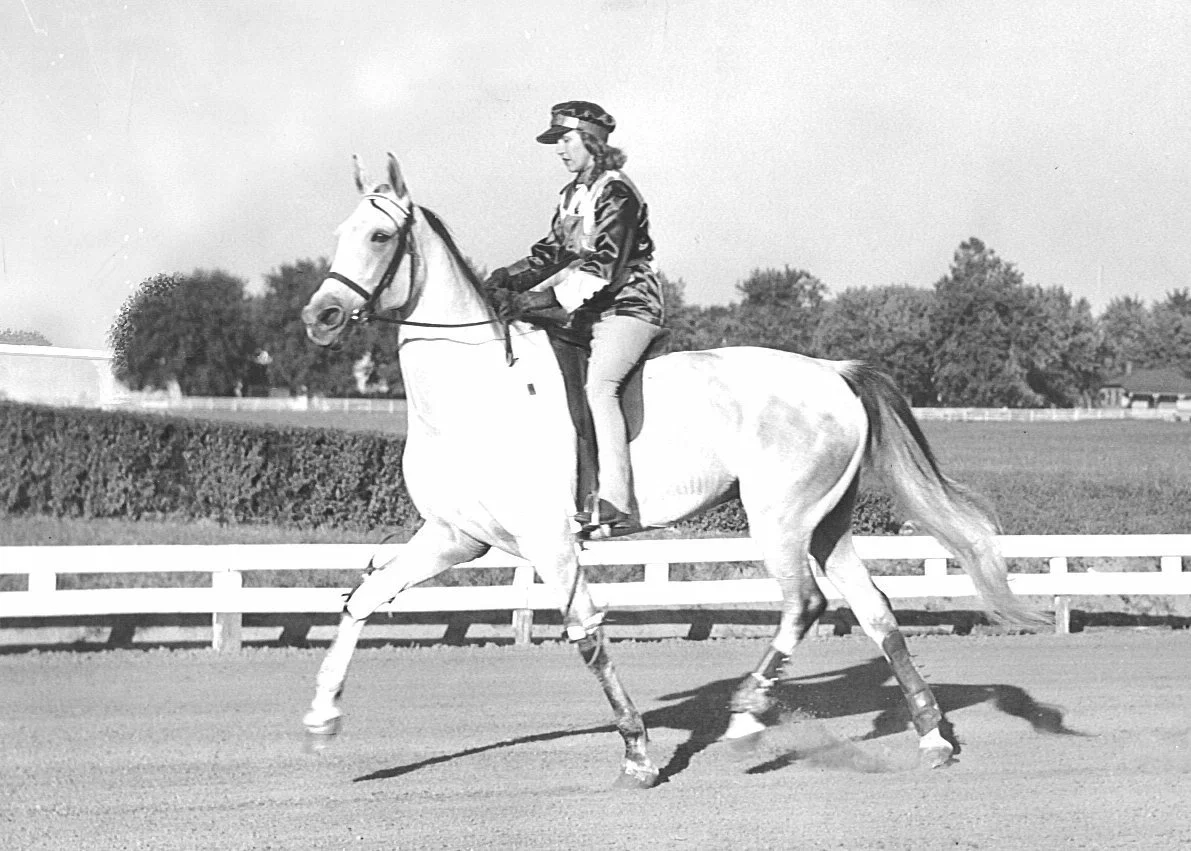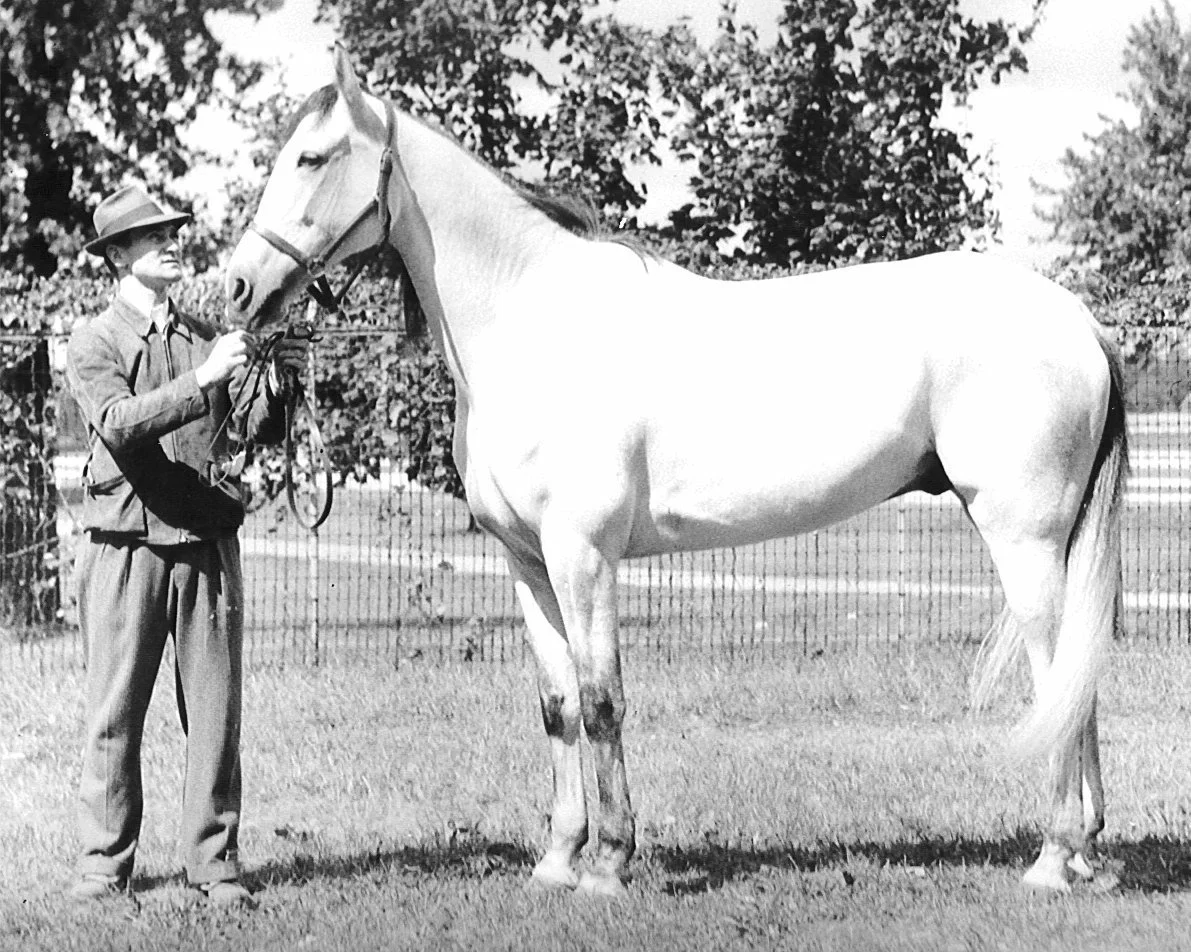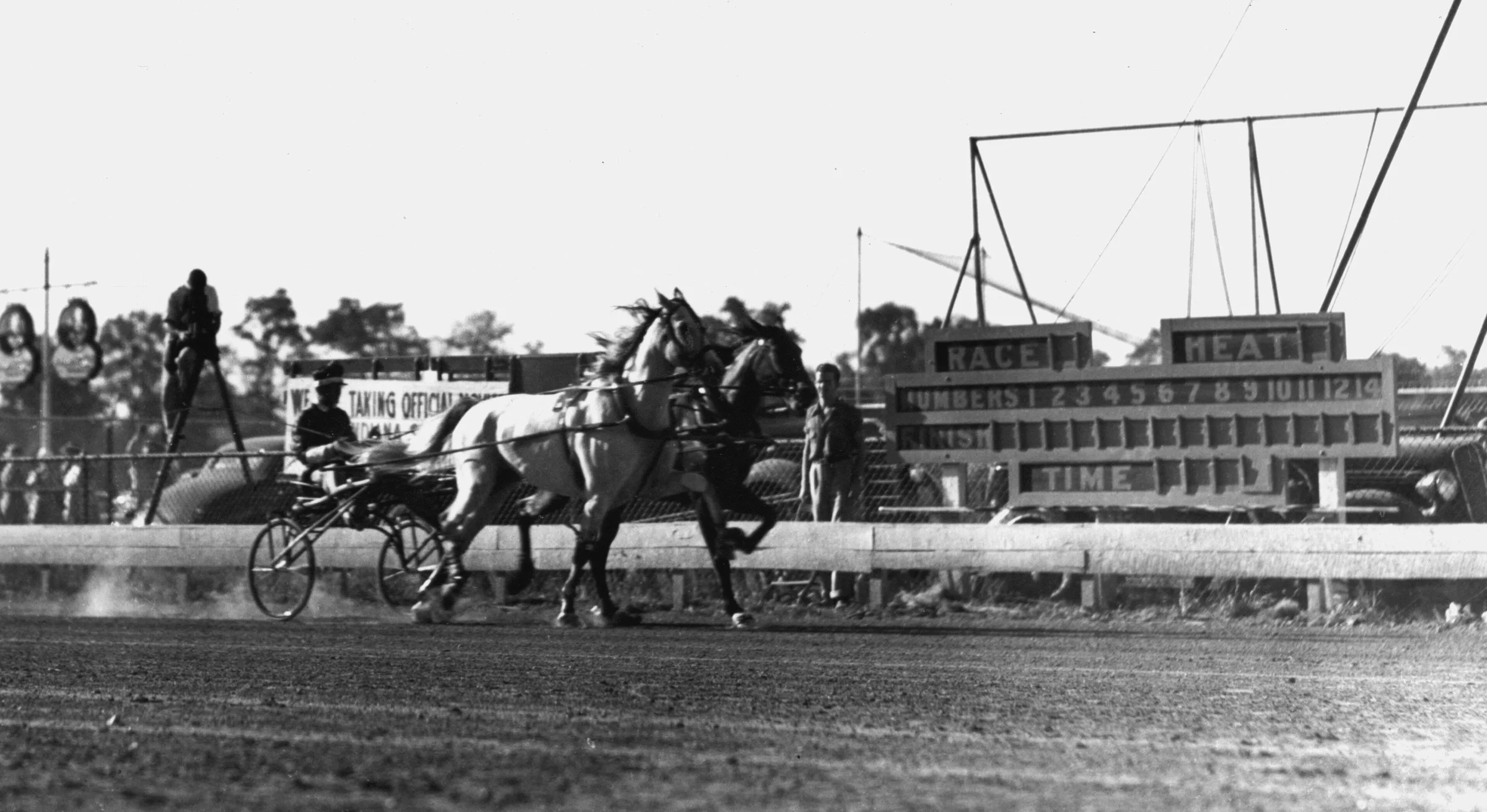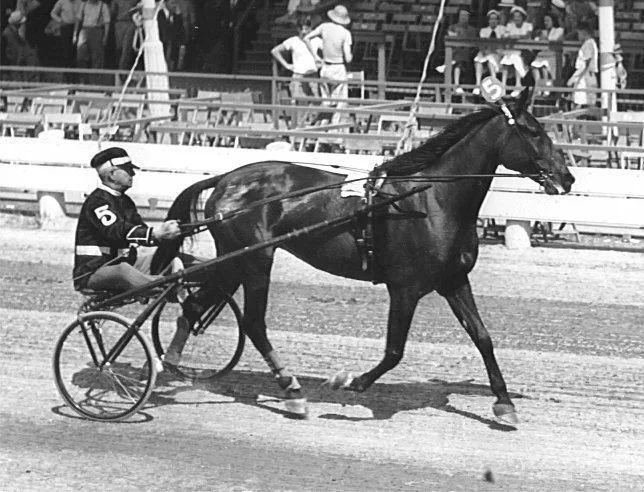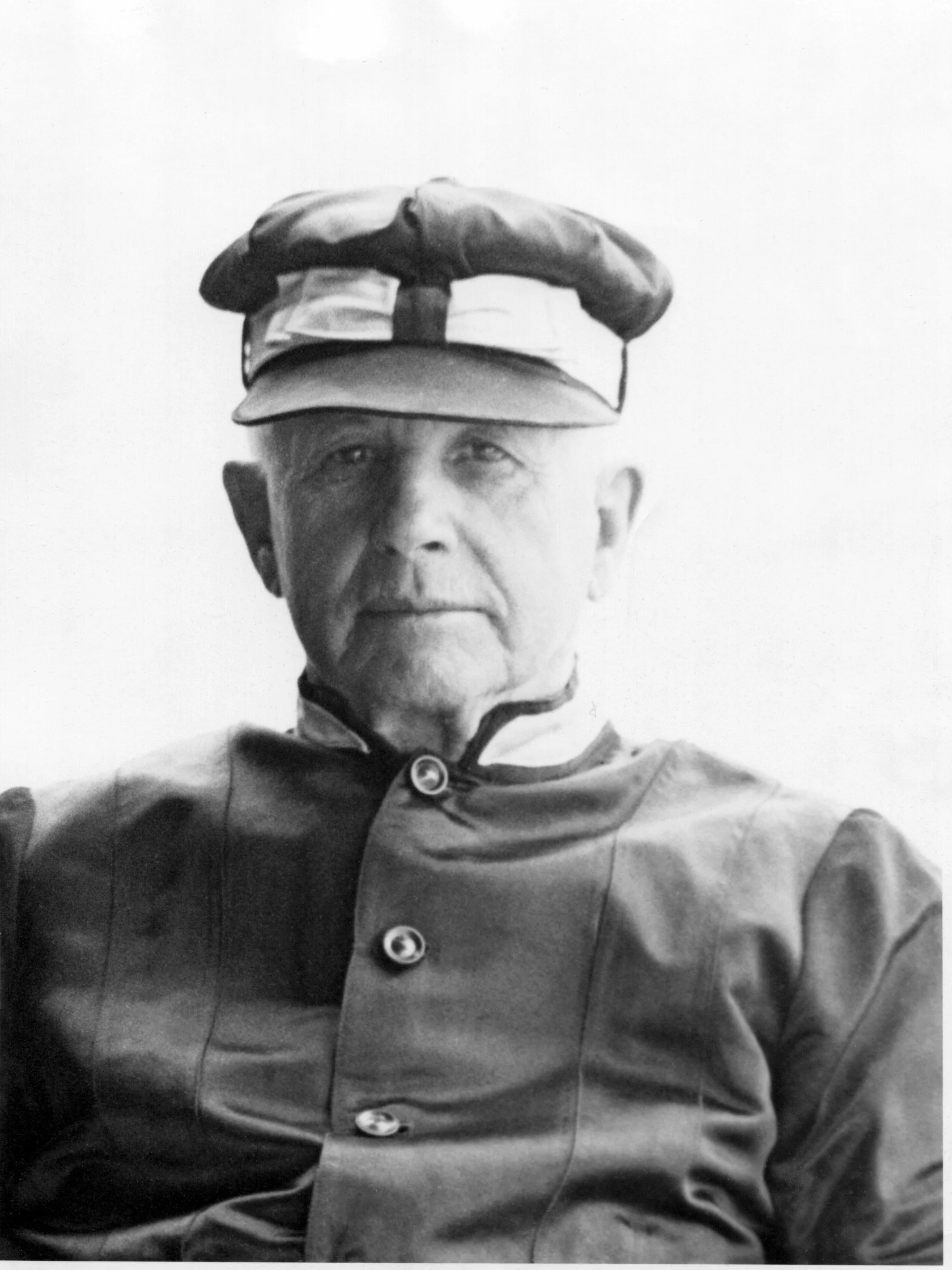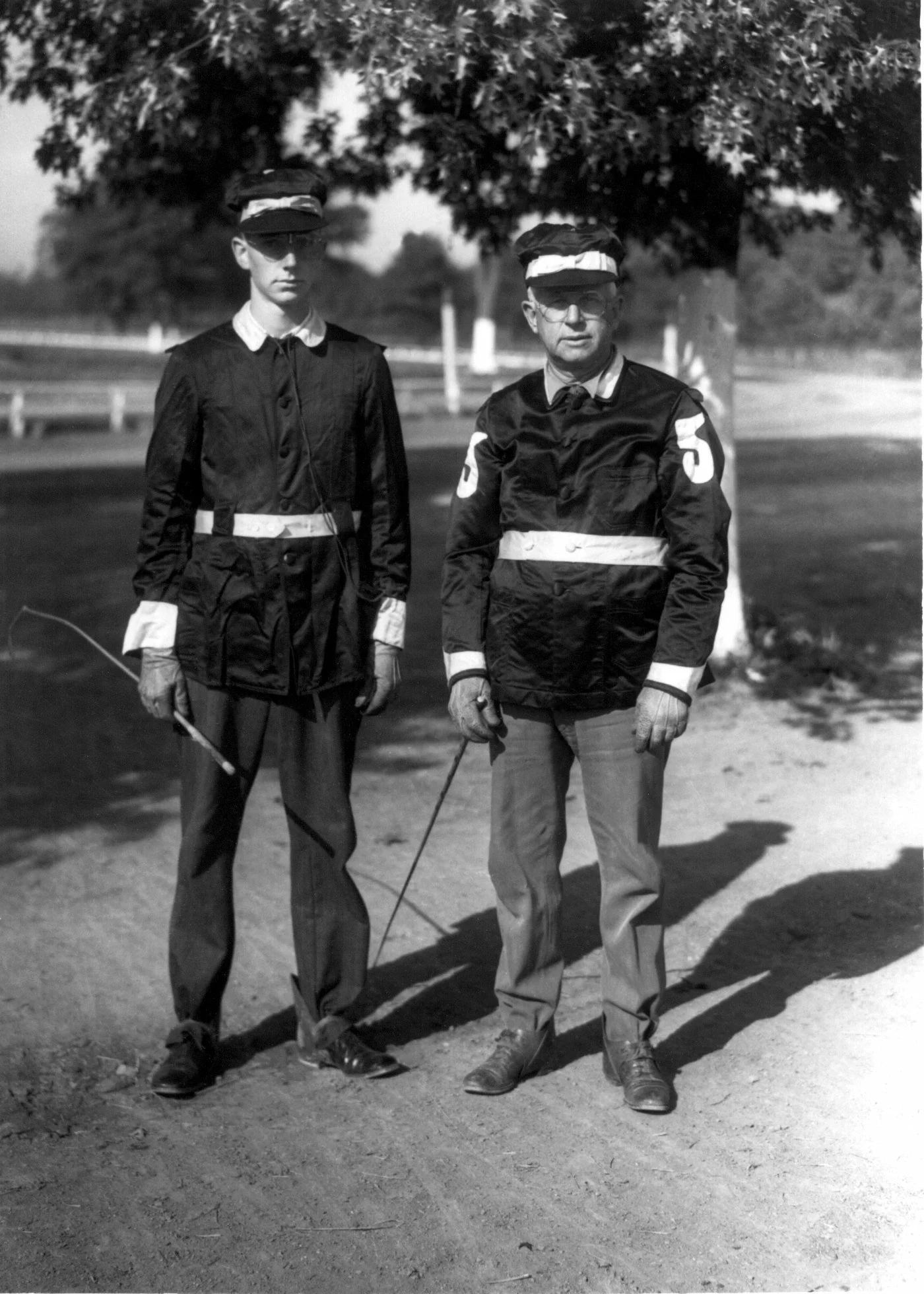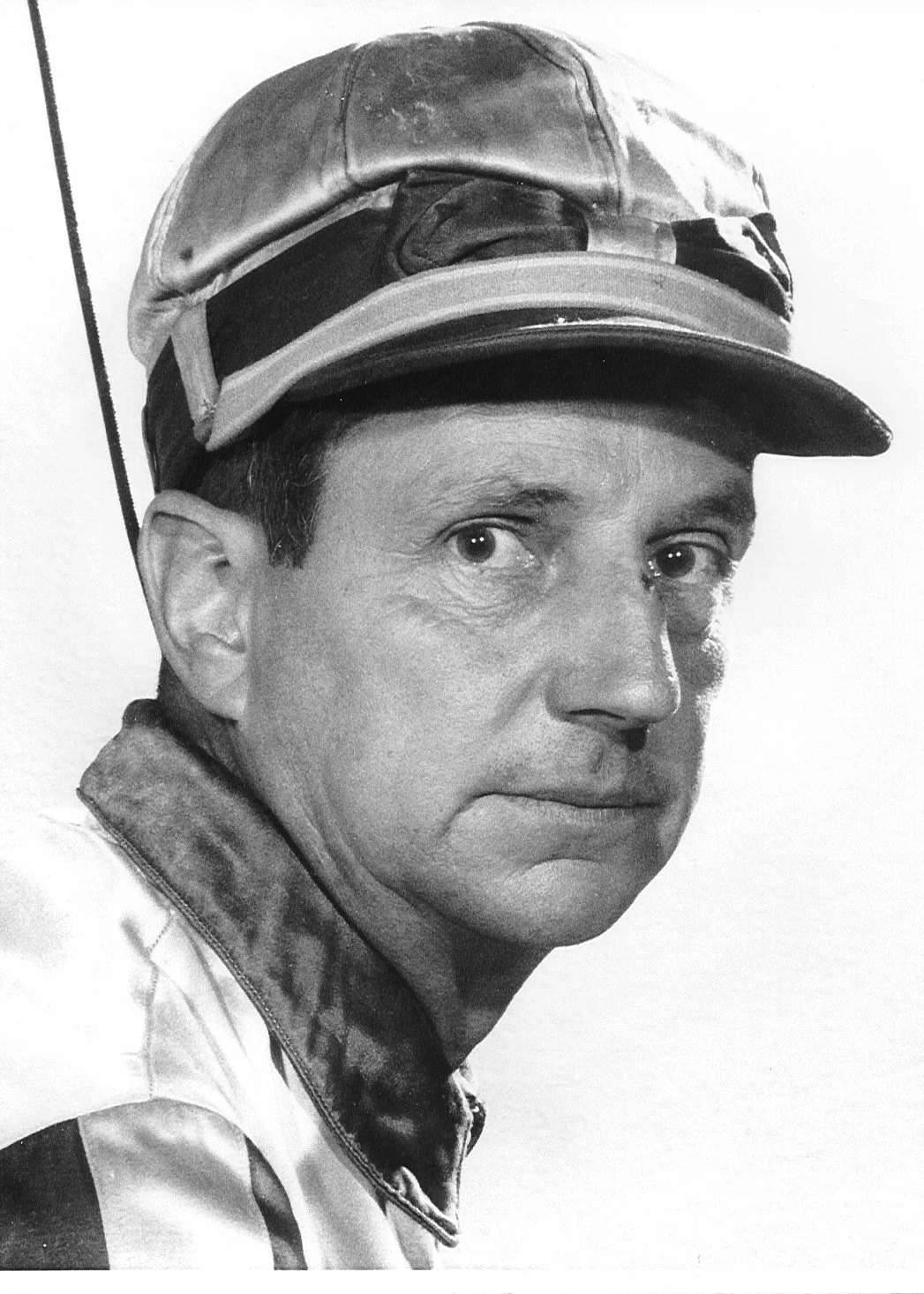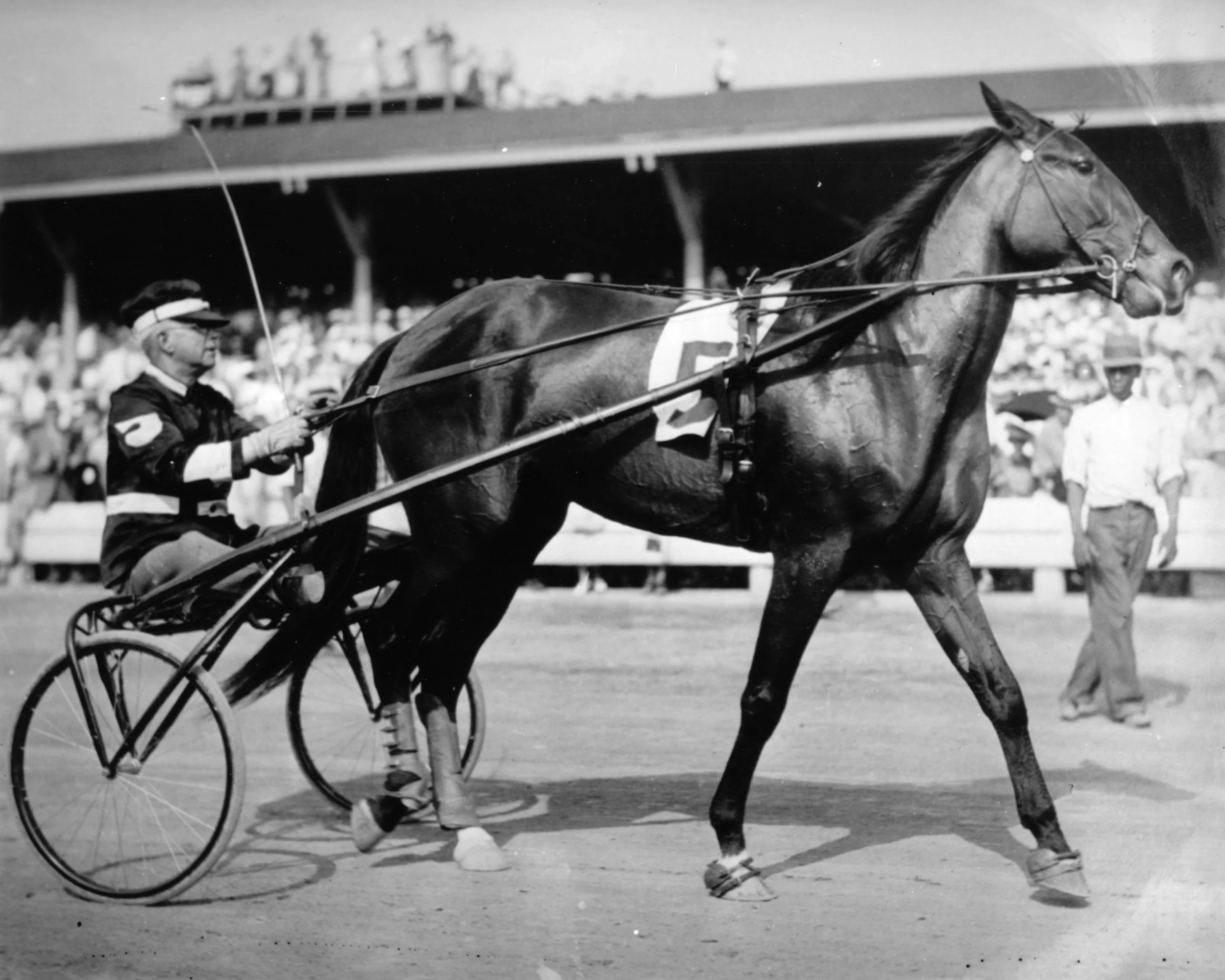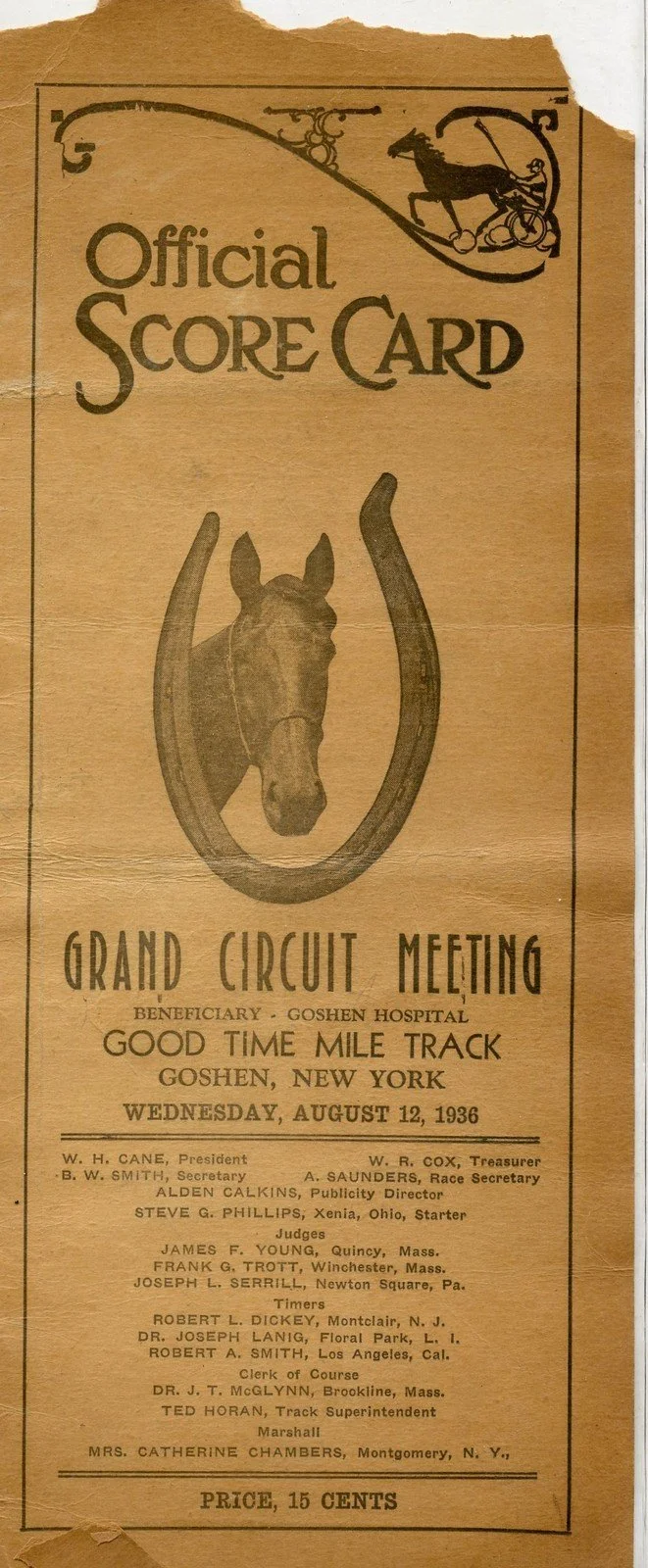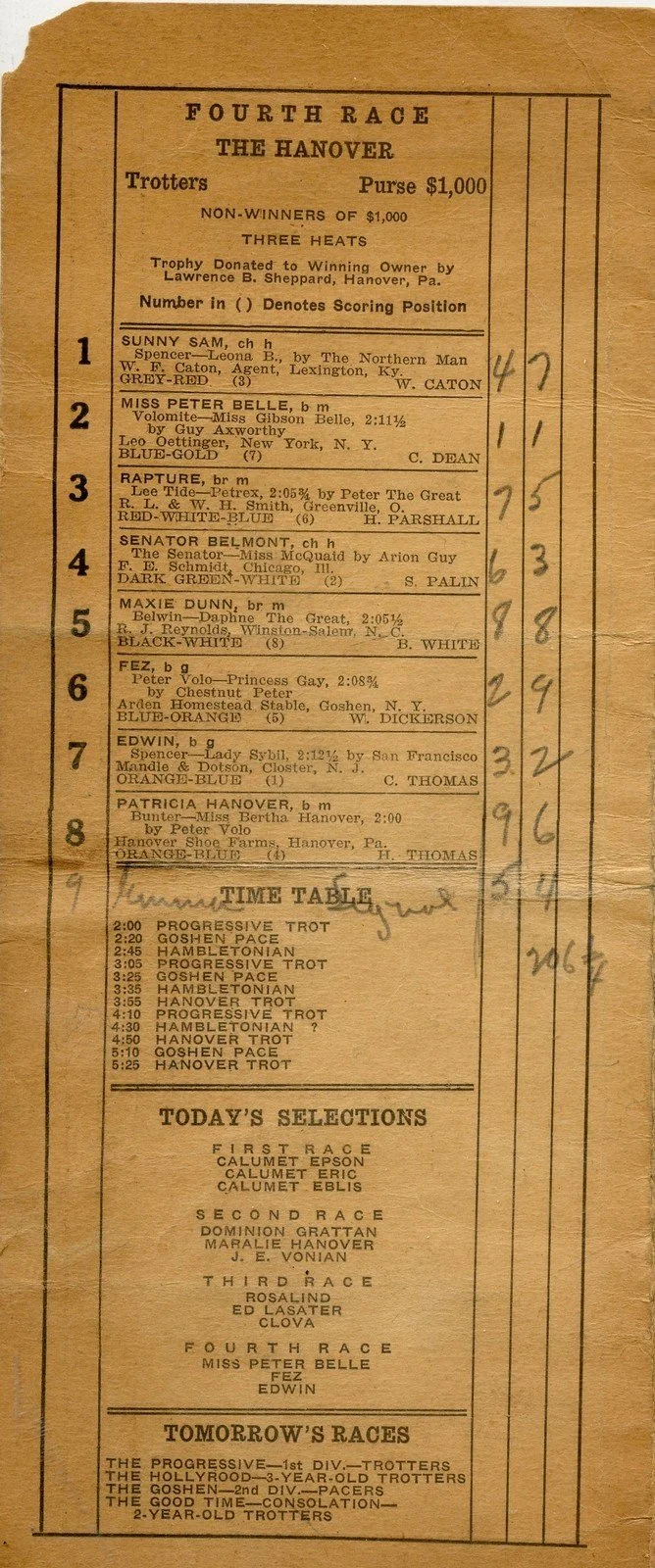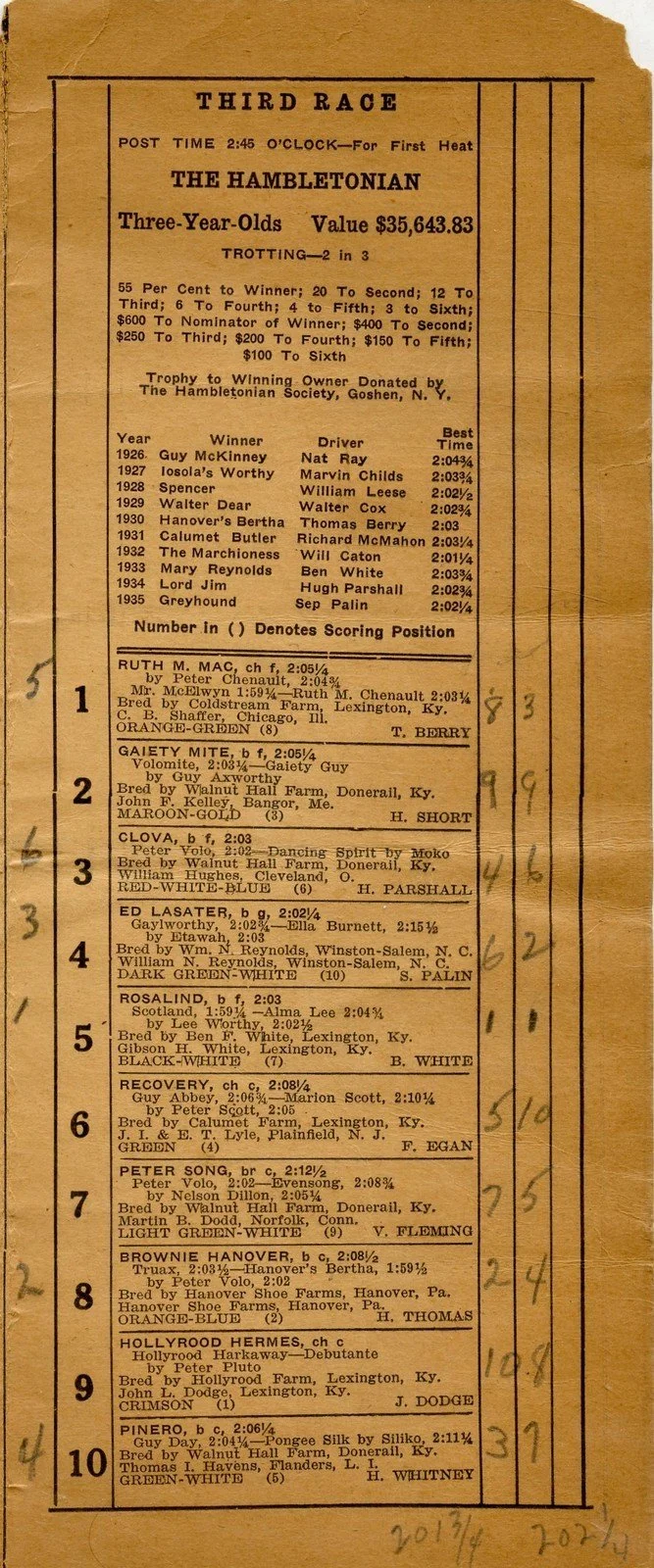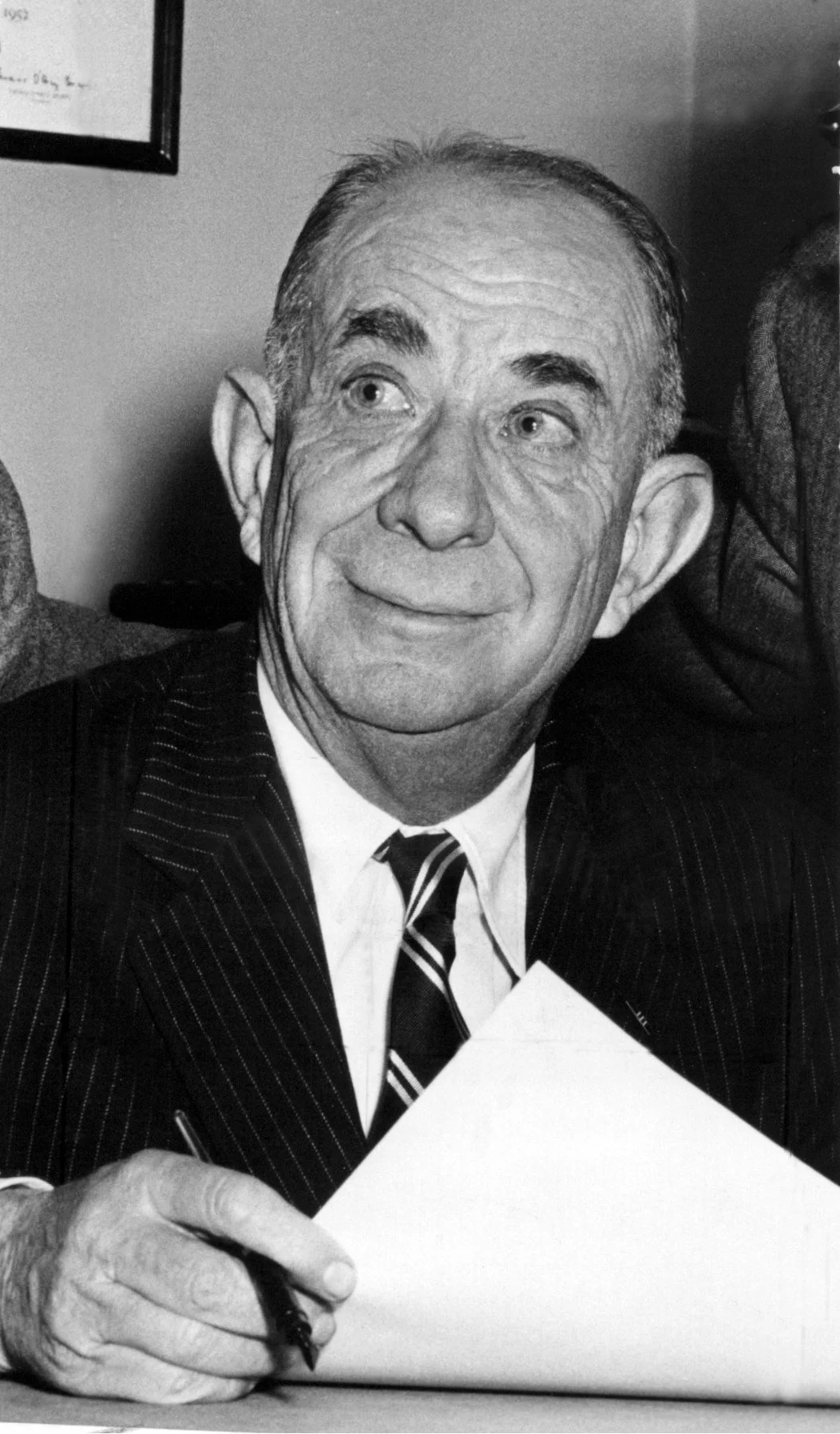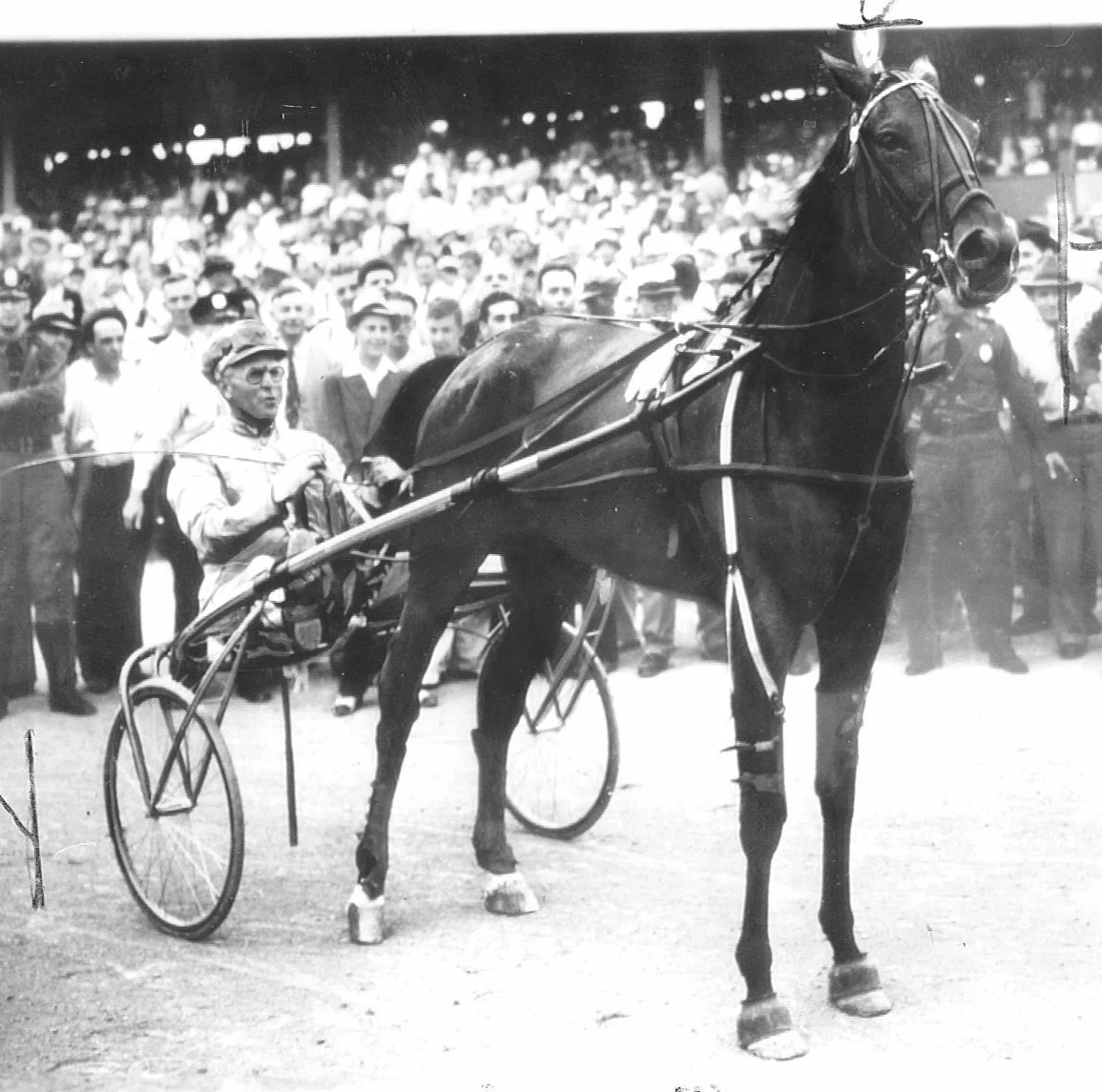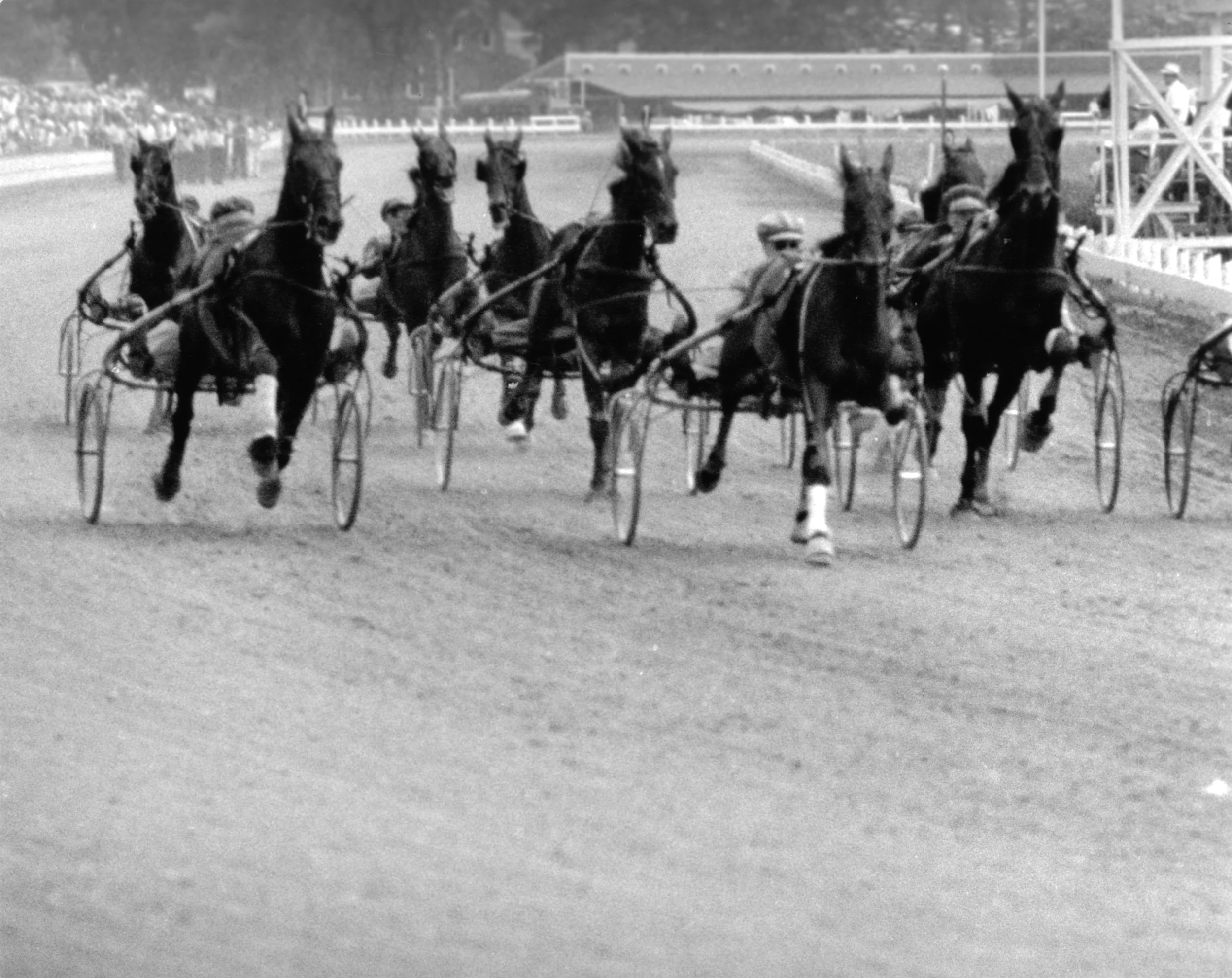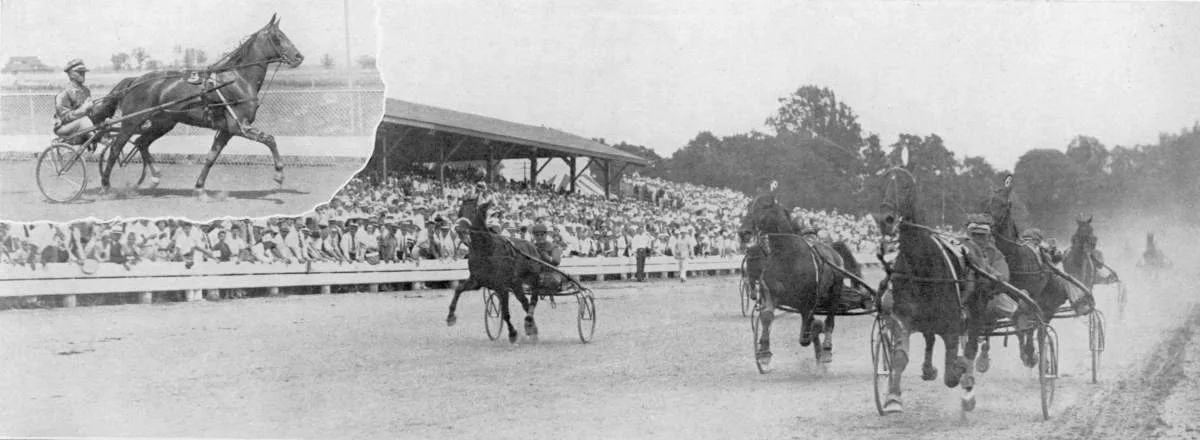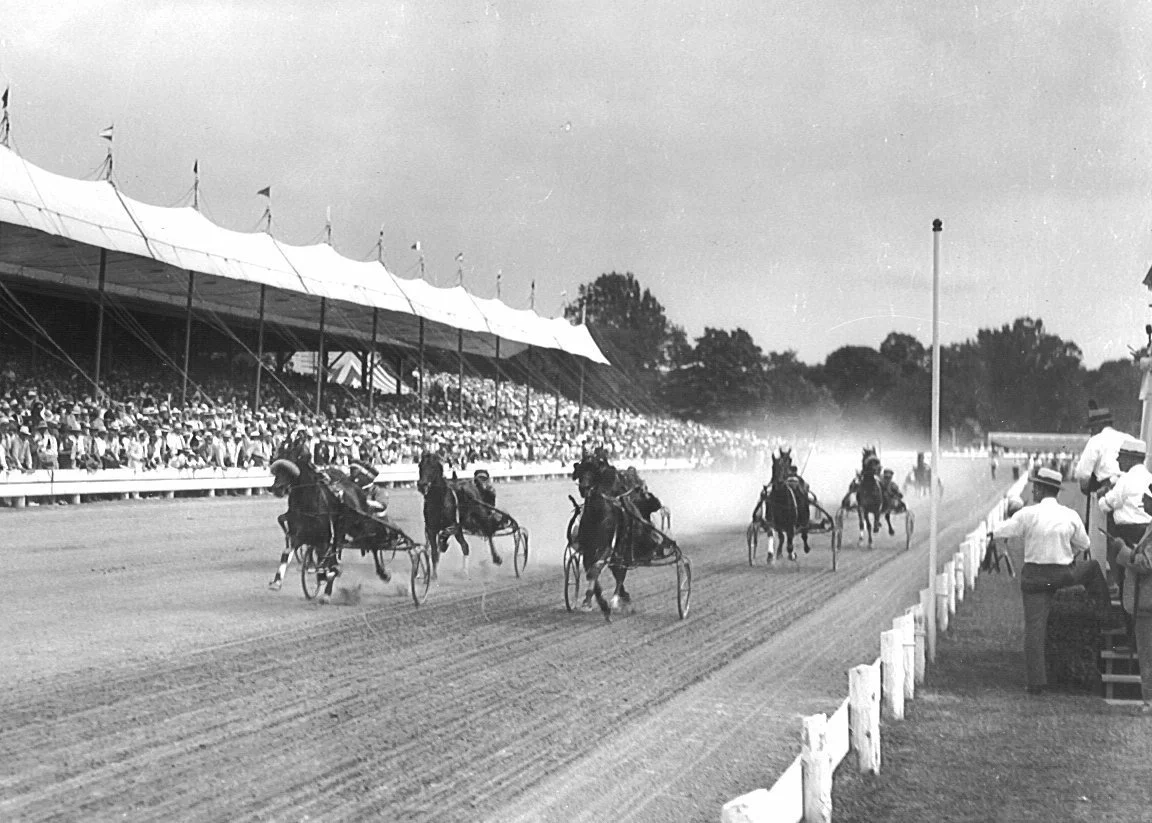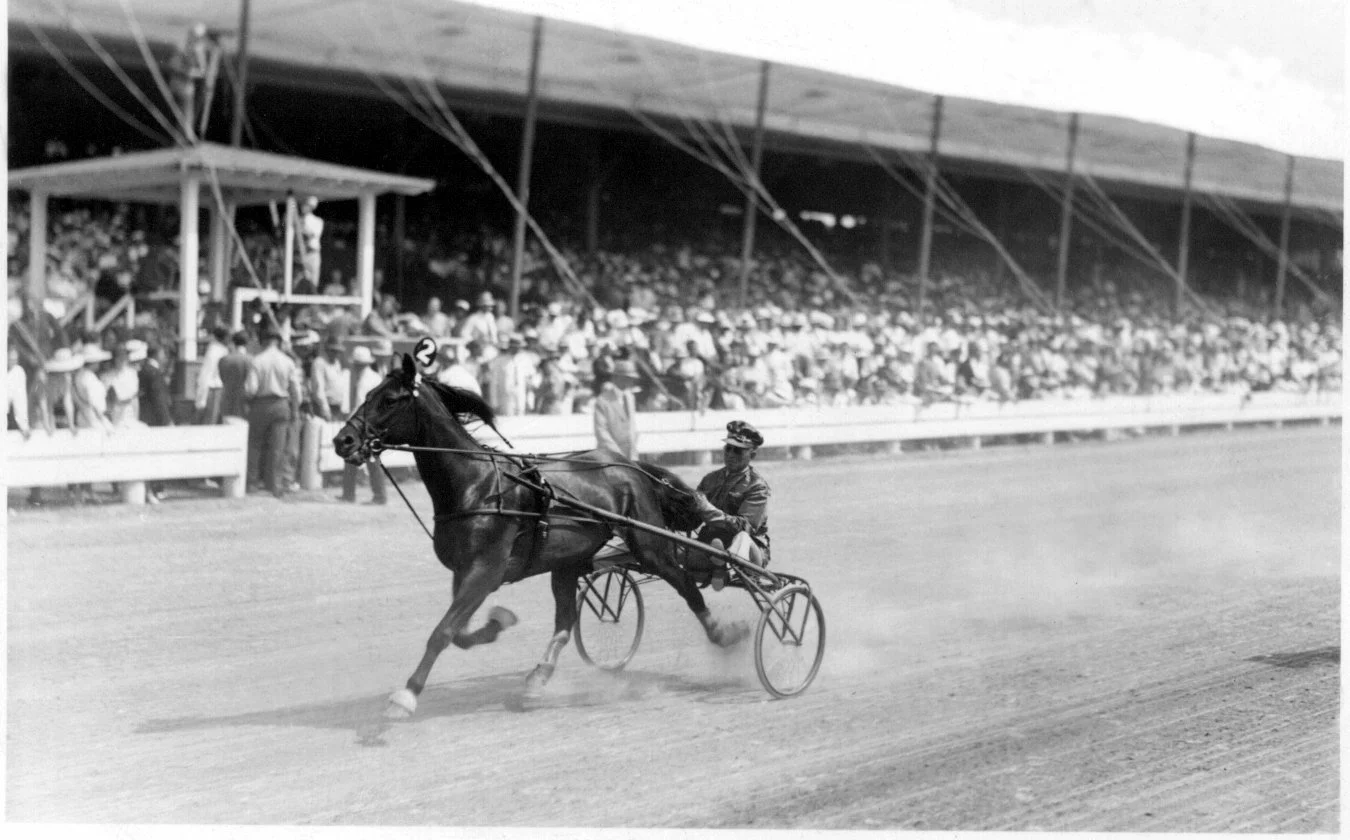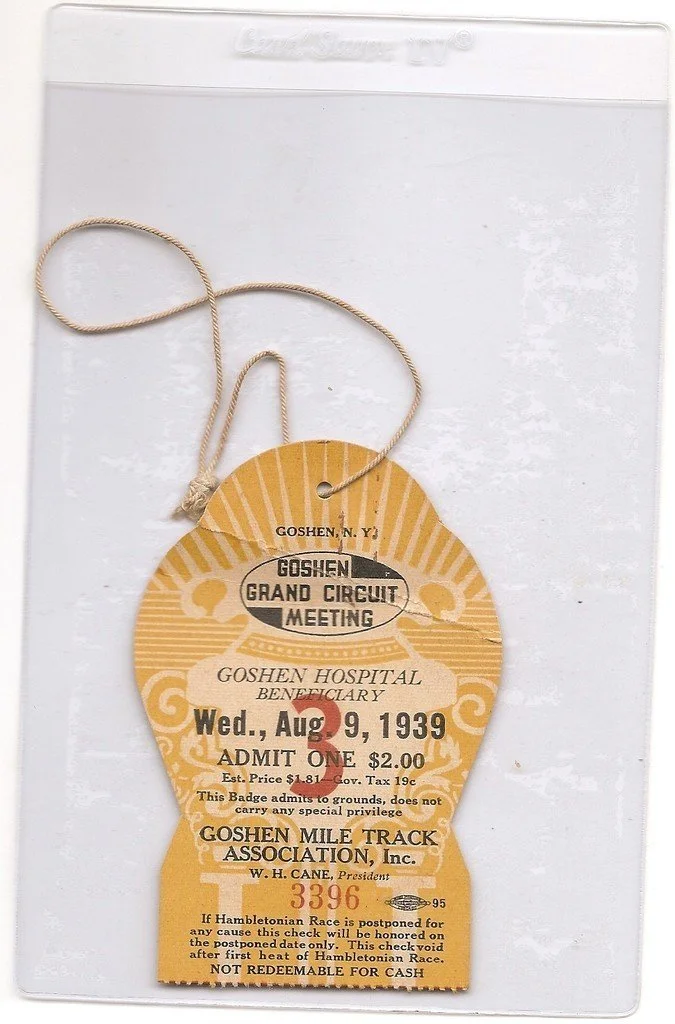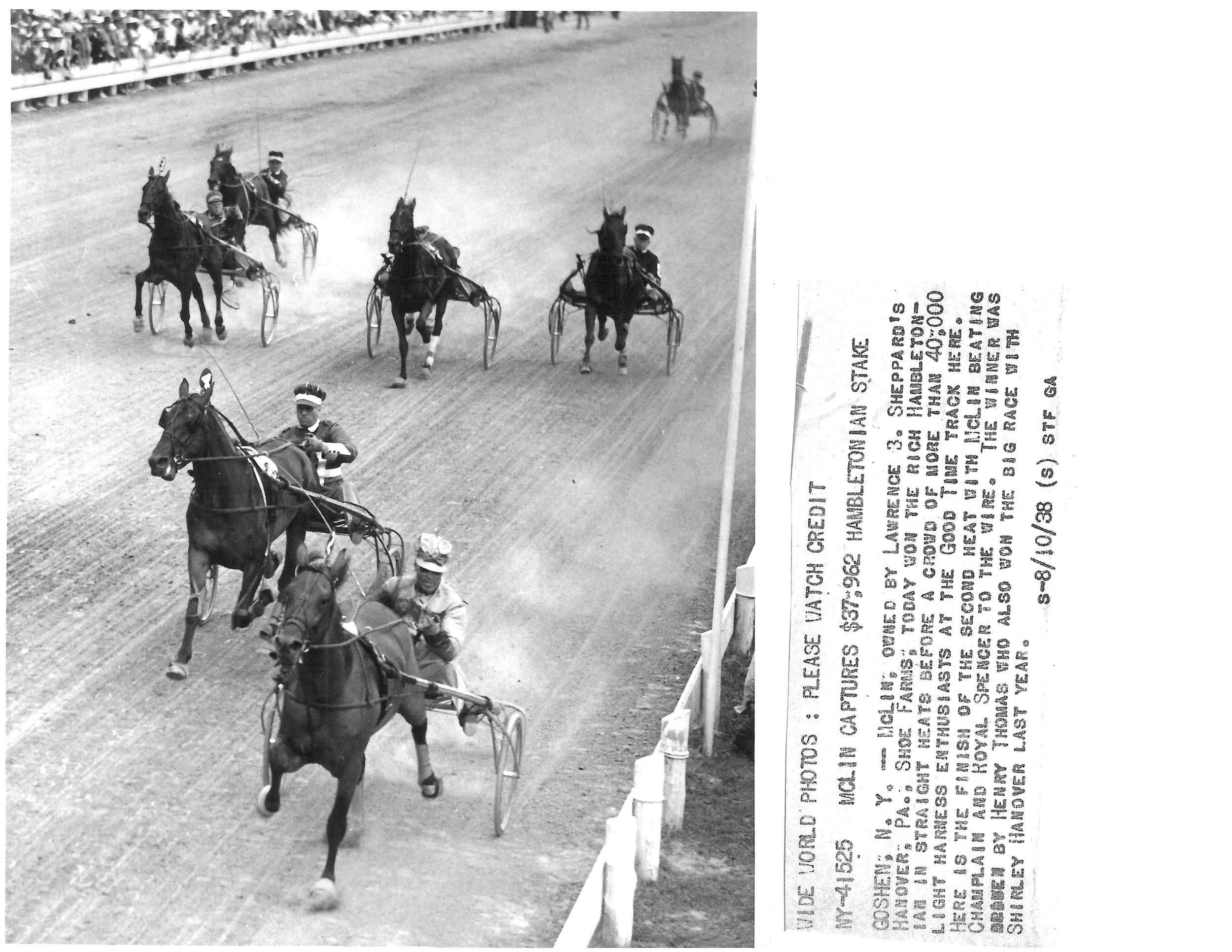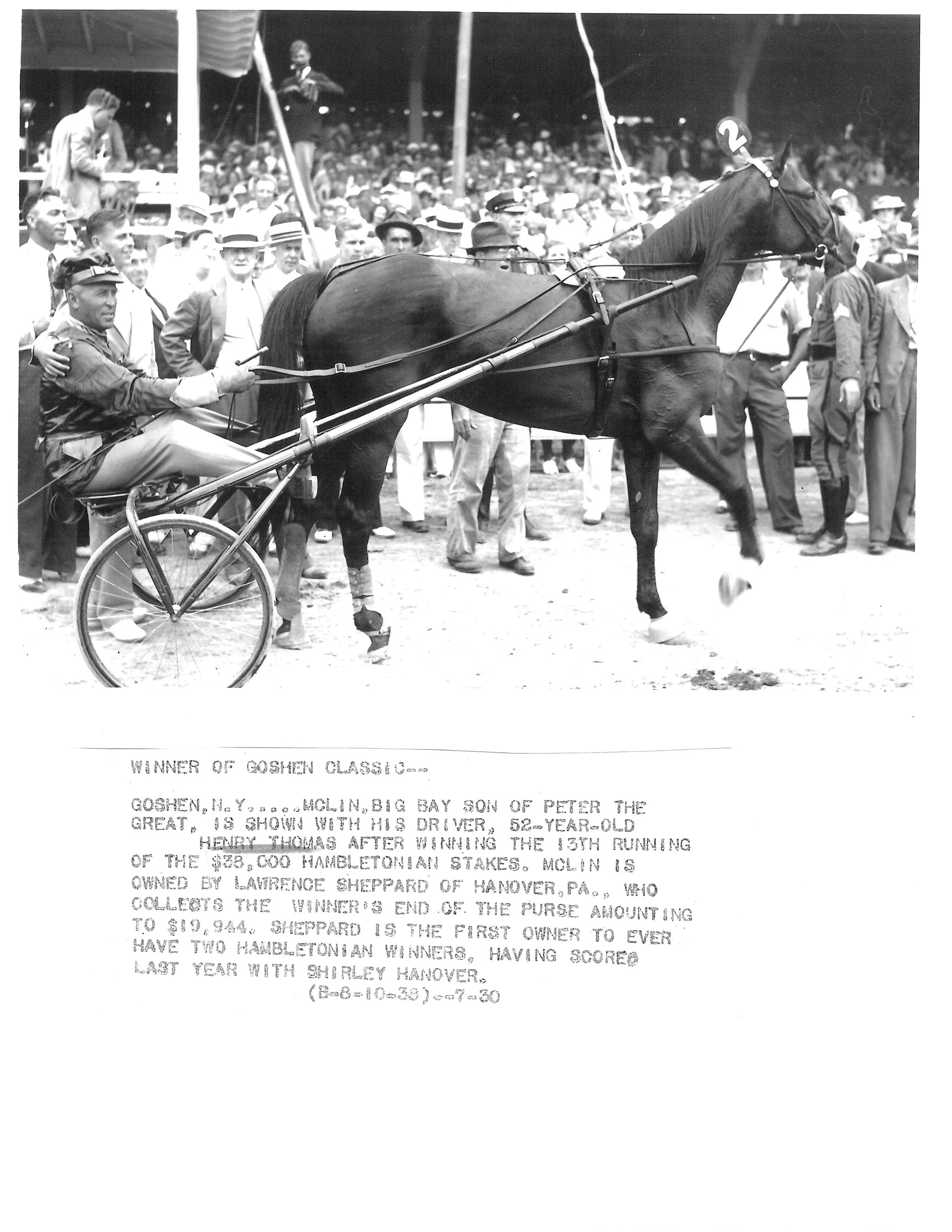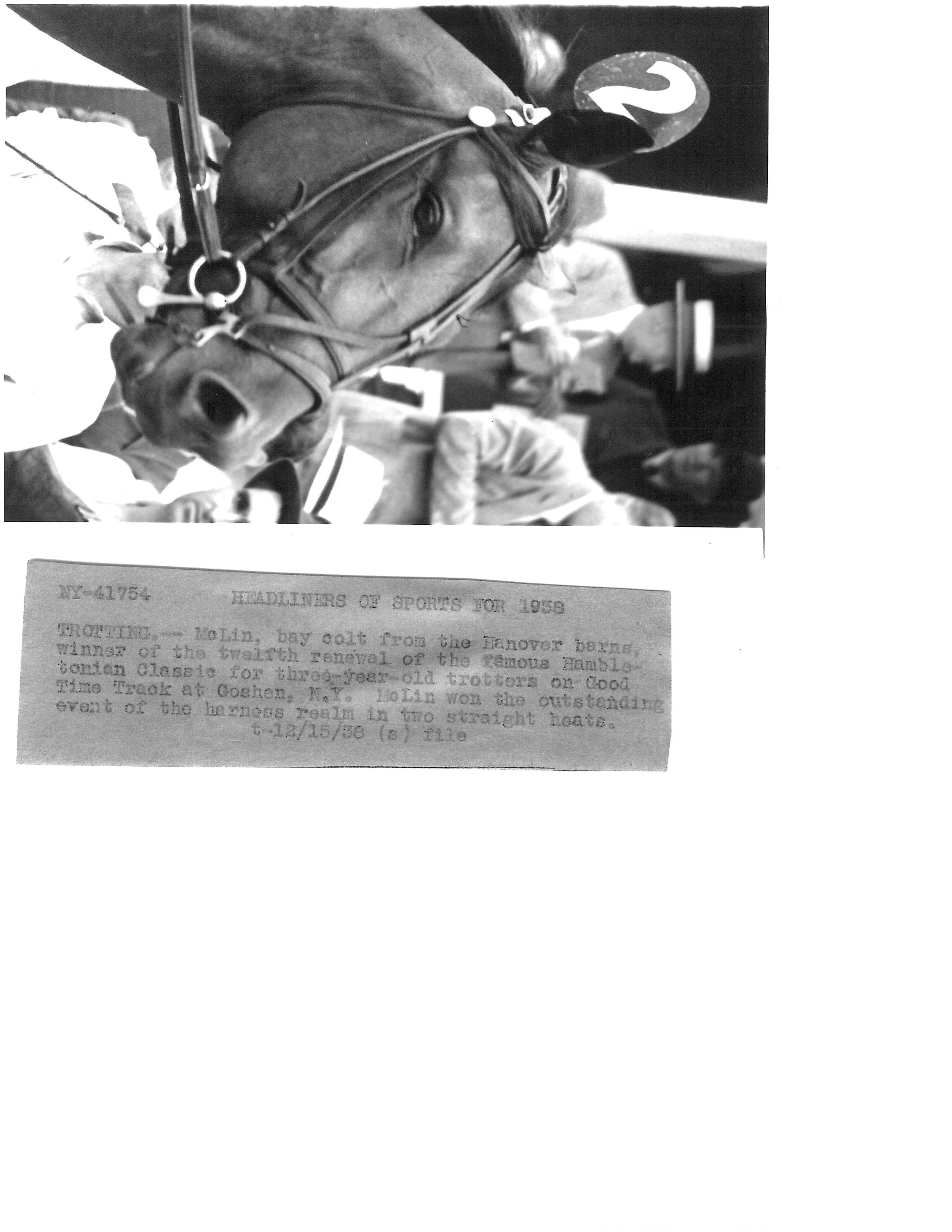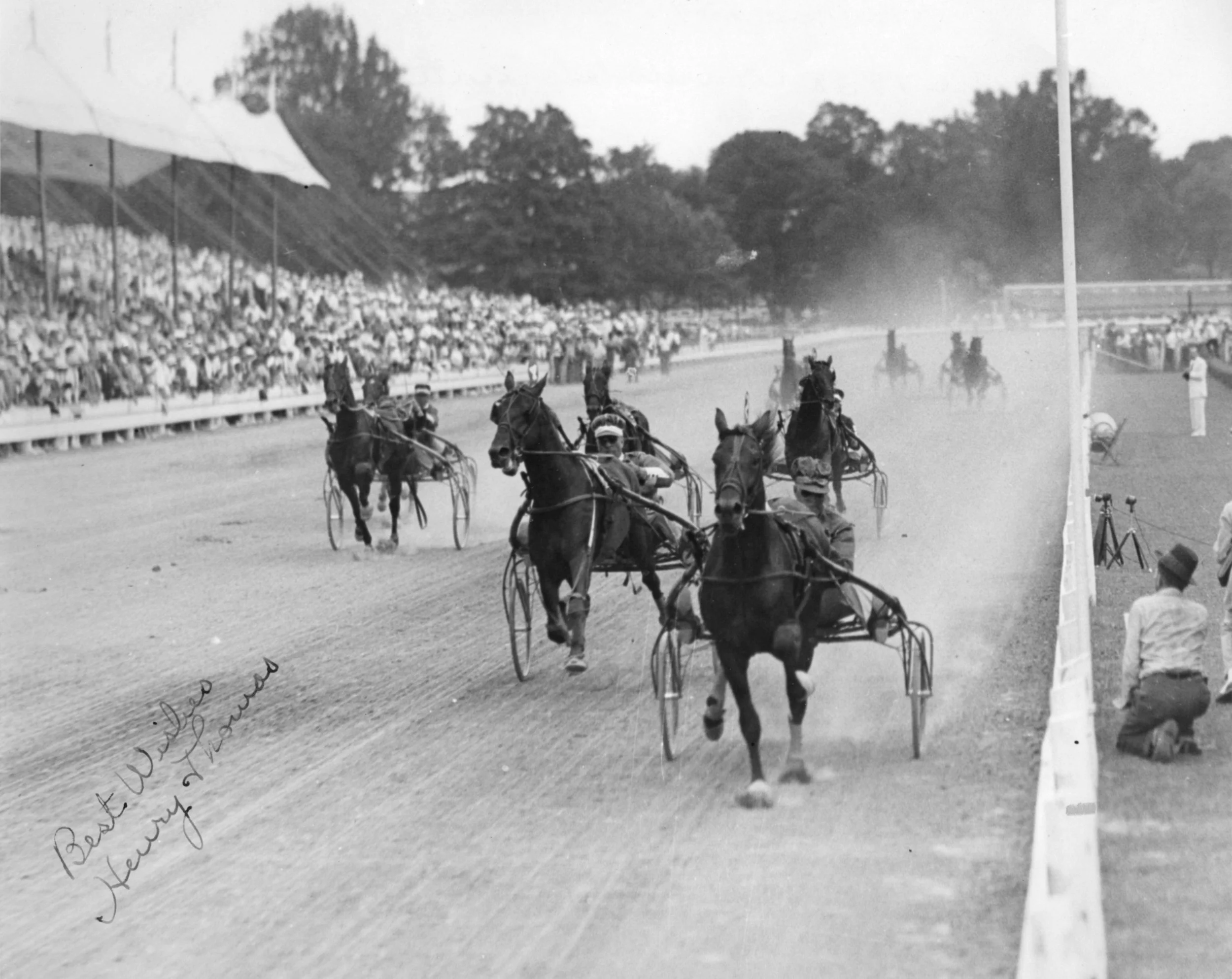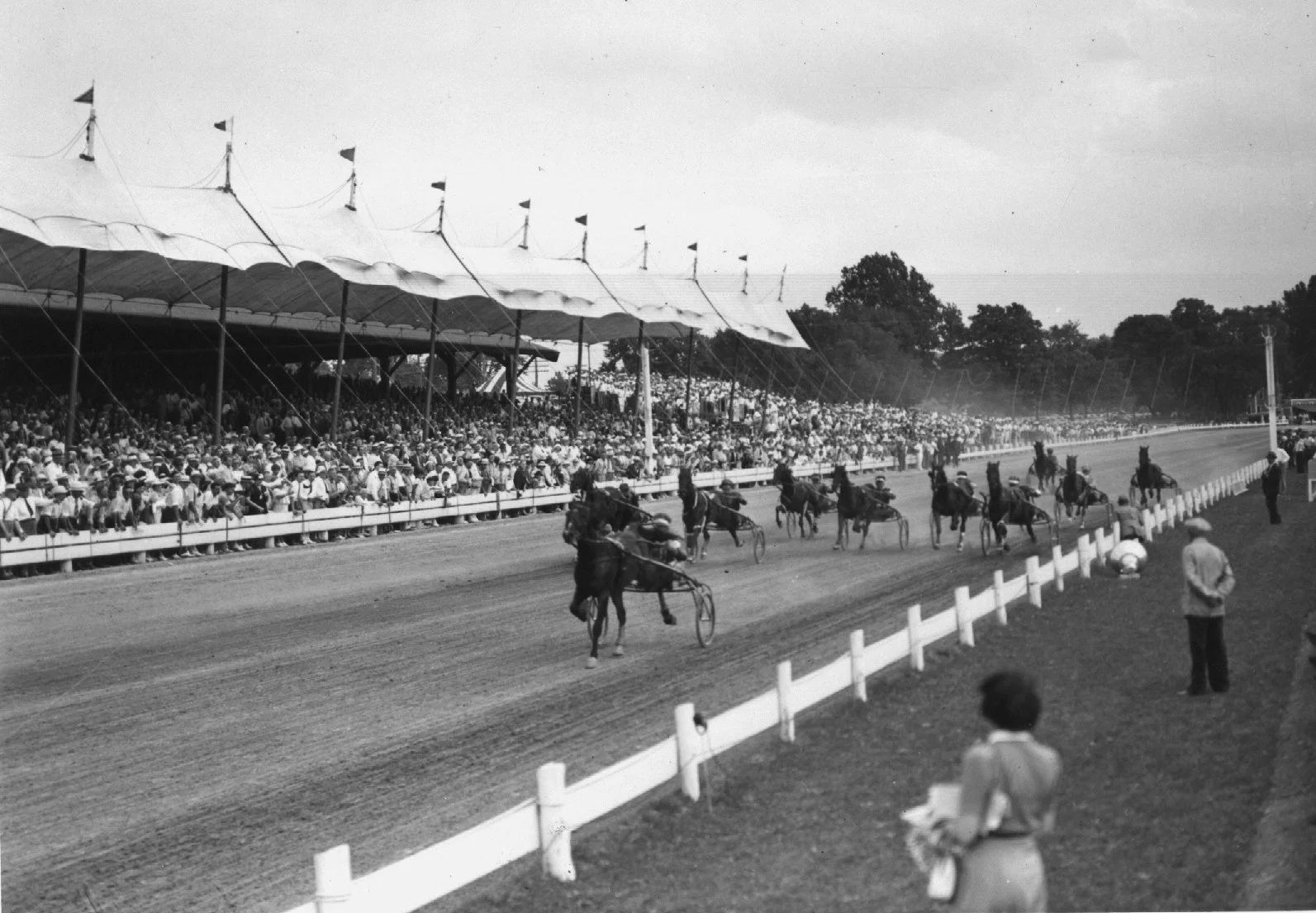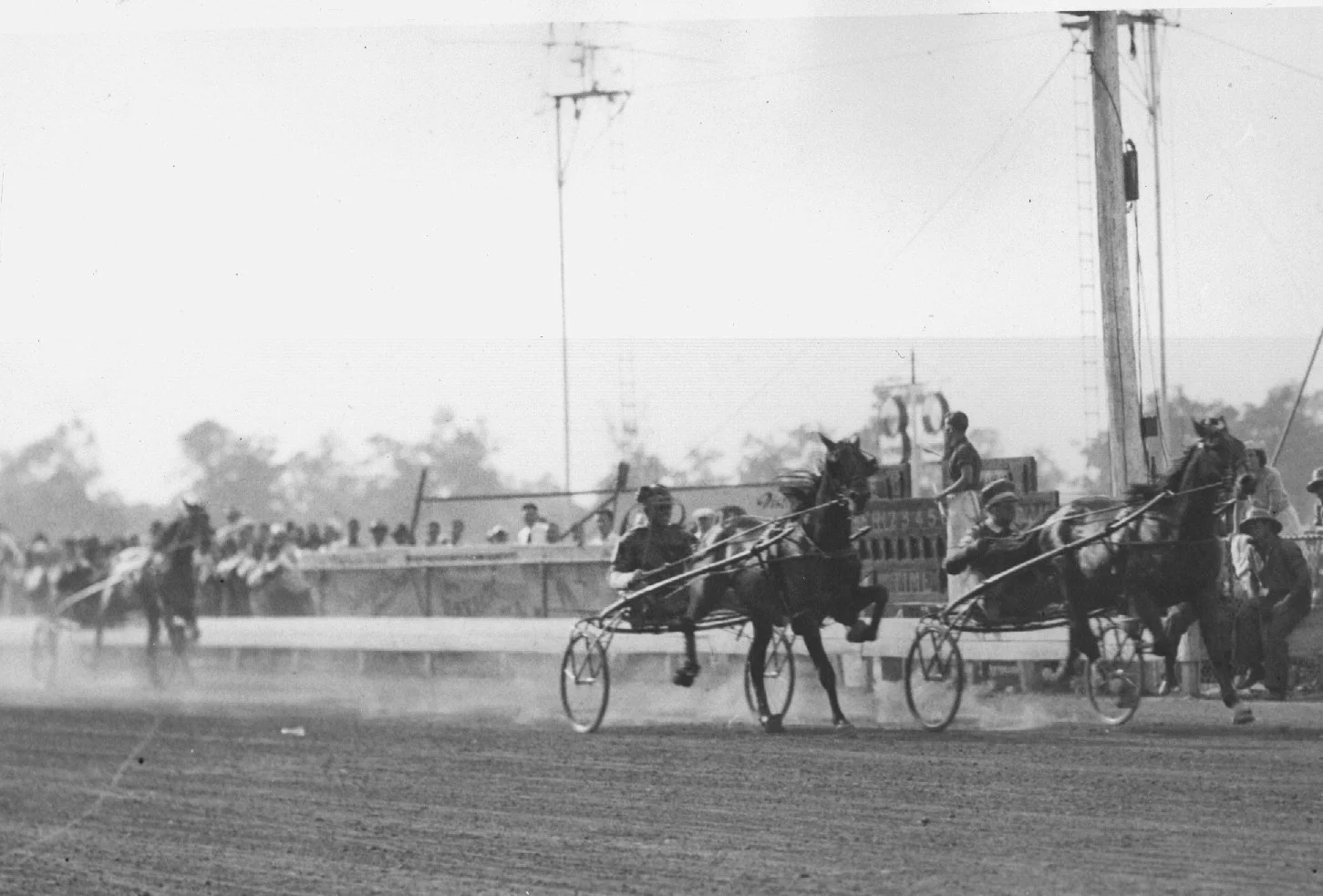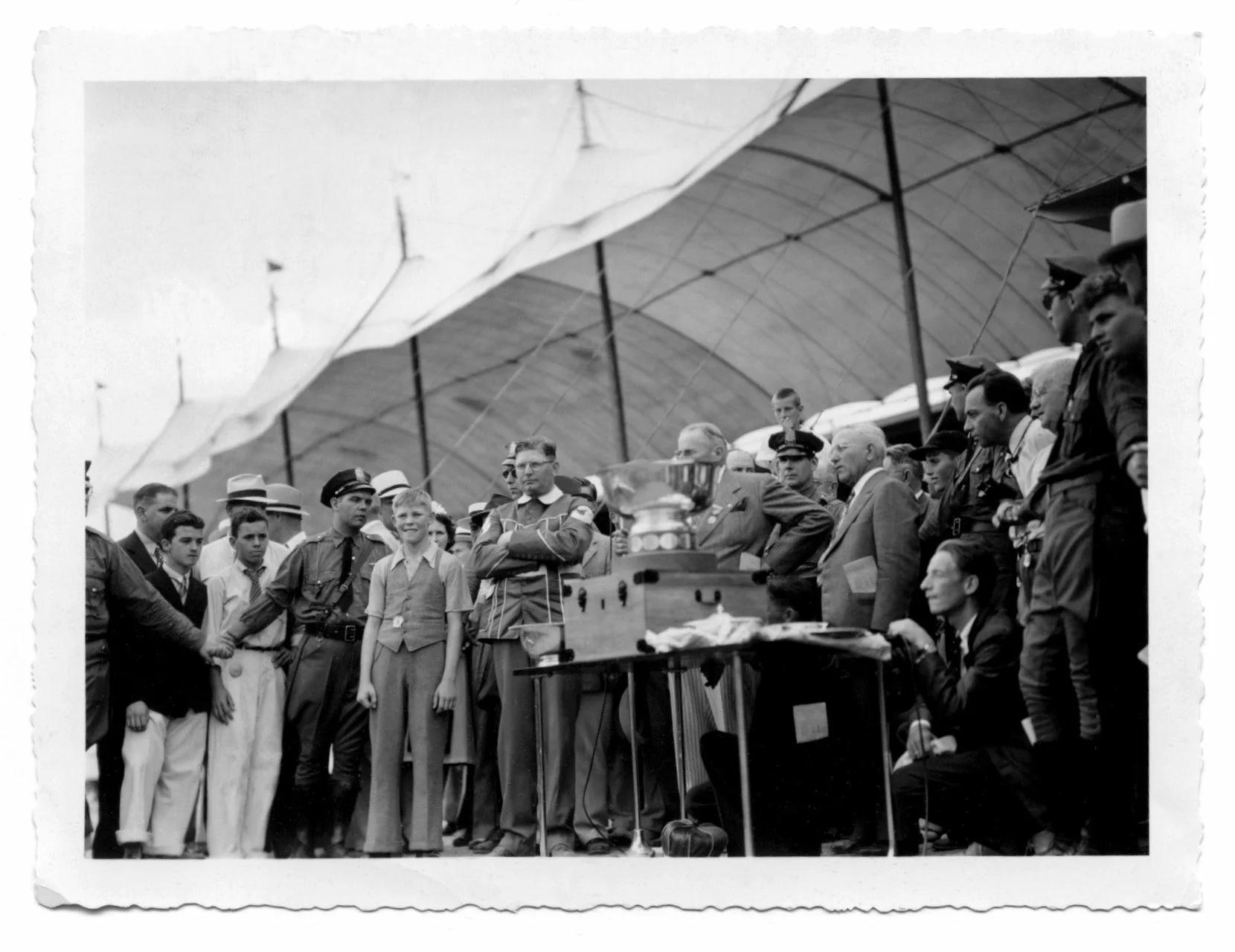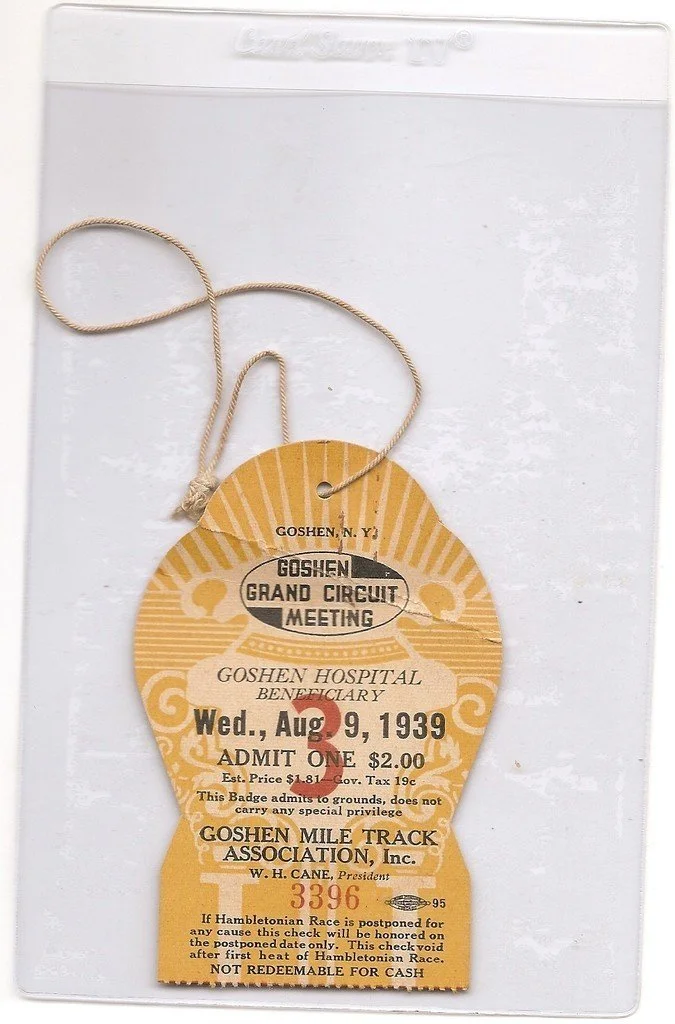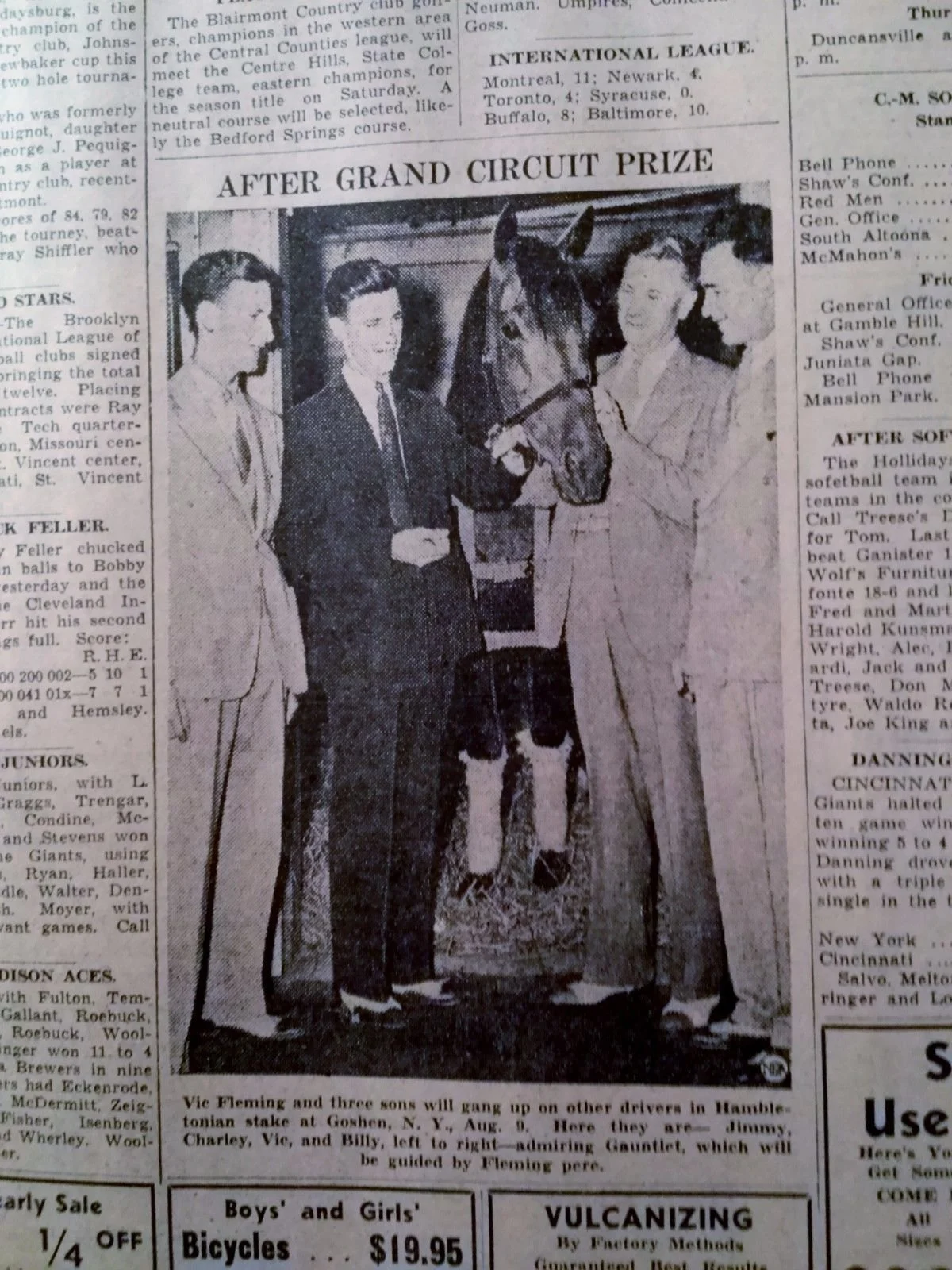Champions |1926-1939
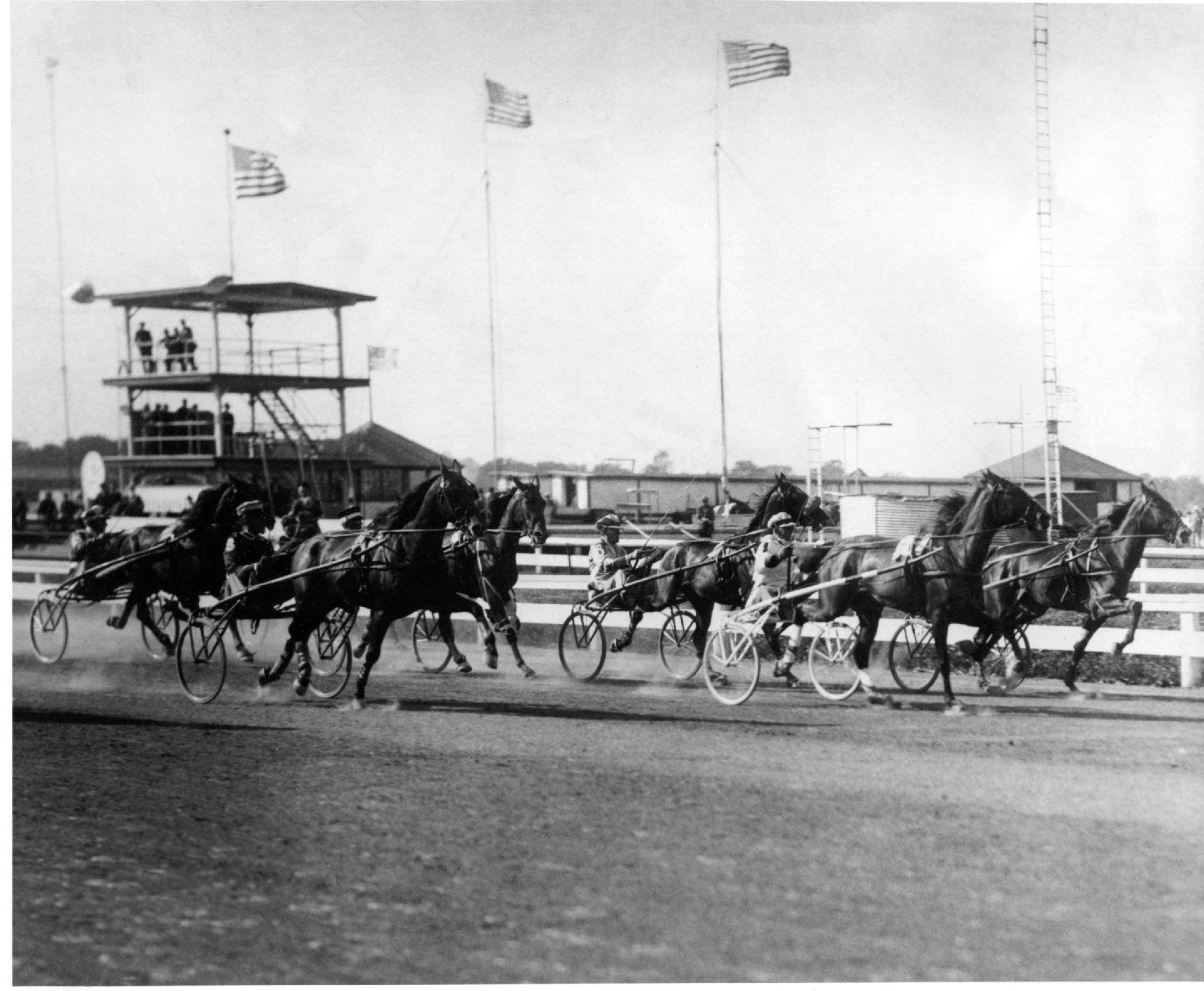
the last shall be first
August 30, 1926
syracuse, ny
ny state fairgrounds
Purse $73,541.32
Horse owners are renowned for their optimism and in the case of Guy McKinney, it was owner Harry B. Rea’s optimism that carved him a unique niche in the annals of harness racing, that of the very first horse to win the Hambletonian. A $925 yearling, Guy McKinney developed a critical illness shortly after his purchase. He recovered and trained for a two-year-old career with only three starts in which he never figured. Harry B. Rea ignored the colt’s past futility on the racetrack and made the January 1, 1926 nominating payment. The colt responded to this show of faith with flair — he put together an unbeaten string of wins to carry him to the Hambo. On Hambletonian Day, Guy McKinney continued that skein with a straight heat victory. From there, he won several other stakes, including the Kentucky Futurity, amassing $68,742 in single season earnings, a mark that stood until 1949. Guy McKinney changed hands at auction in the fall of 1926, with the fledgling Hanover Shoe Farm the winning bidder at $12,000. He was turned over to trainer Tom Berry for the specific purpose of breaking the 1:59½ record. On Thanksgiving Day in 1930, Guy McKinney set a new standard of 1:58¾ in Phoenix, Arizona, which stood until 1938.
By offering to add $8,000 to the purse, Syracuse, New York won the bidding to host the inaugural Hambletonian over Kalamazoo, Michigan and Atlanta, Georgia. Kalamazoo bid $5,000; Atlanta offered $3,000. Winless in five starts as a 2-year-old (40-1 in the winter book), Guy McKinney came into the race undefeated at three and was the post time favorite at 3-2 in the pools. The trophy for the first three years was the Onondaga Hotel Cup. Legendary New York Mayor Jimmy Walker presented the cup for the inaugural race, and noting Ray's green jacket said, "Well, you've got the right colors anyway." The purse for Hambletonian No. 1 was $73,451.32, equivalent to $668,114 in 1999 dollars. That was a record purse until 1950. The Meadowlands added $569,987 to the 1998 Hambletonian. The total individual payments for the first Hambletonian were $960 including a starting fee of $500; the total fees for the 1999 Hambletonian Open are $16,925 of which $15,000 is the starting fee.
Media
Champions |1926-1939
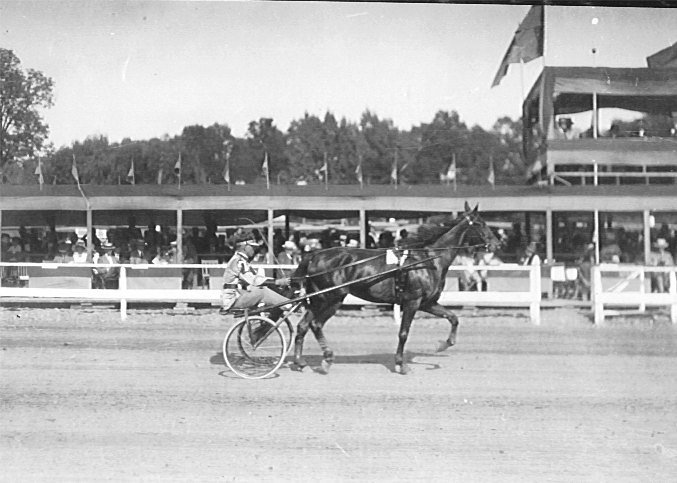
The Speed Fountain
September 27, 1927
lexington, ky
the red mile
Purse $54,694
Hambletonian lore is rife with tales of horses that enter the race in anonymity and are bedded down that night as immortals. Iosola's Worthy is a mare of just that description. A June foal, Iosola's Worthy was brought along slowly by Ben White as a two-year-old. Her lone victory came in a small stake at the Lexington Trots. She was sold over that winter by her breeder Fred Field of Brockton, Massachussetts, to E.J. Merkle of Columbus, Ohio. Spring came, and with it, steady improvement by Iosola's Worthy, who placed progressively better in each race she entered. She outlasted all the contenders in a four heat Horse Review Futurity and several other races leading up to the Hambo. The first filly to win the Hambletonian, Iosola's Worthy handled that task in straight heats and her $56,538 in career earnings made her the leading female money earner until 1930. Sold that fall to Walnut Farm for $10,700, she became the sole mare of her era to produce 2:00 performers by three different stallions.
After five days of rain at Syracuse, Hambletonian No. 2, which was originally scheduled for August 29, was moved to Lexington and raced the second week of the Grand Circuit meeting on September 27. Iosola’s Worthy was the first of 13 fillies to win the Hambletonian. Six fillies won the Hambletonian in the first twelve editions. New stake record in the second and final heat of 2:03 3/4. Childs drove the winner for trainer Ben White. White drove the filly Kashmir, probably the favorite had the race been contested at Syracuse as scheduled. A month later, when the race was staged at The Red Mile she was not a factor because of "bad manners," finishing last in the placing (7-7). White would have to wait six more years to win his first of four Hambletonians, a milestone he shares with Bill Haughton and Stanley Dancer. In the initial two years of the Hambletonian, the Walnut Hall stallion Guy Axworthy sired the first two money winners in the summary (as well as third money winner in 1927). The brother of the winning driver Marvin Childs, Frank Childs trained the winner of the 1959 Kentucky winner, Tomy Lee. The trophy for the 1927 race, a 3-foot tall urn, was among $70,000 worth of silver stolen in a burglary in 1979 in Granville, Ohio. A few months later the stolen silver was recovered in the Ohio River. The trophy is now in the collection of Merkle’s grandchildren. Heavy rain in Syracuse forced the organizers to move the event to Lexington.
Media
Champions |1926-1939
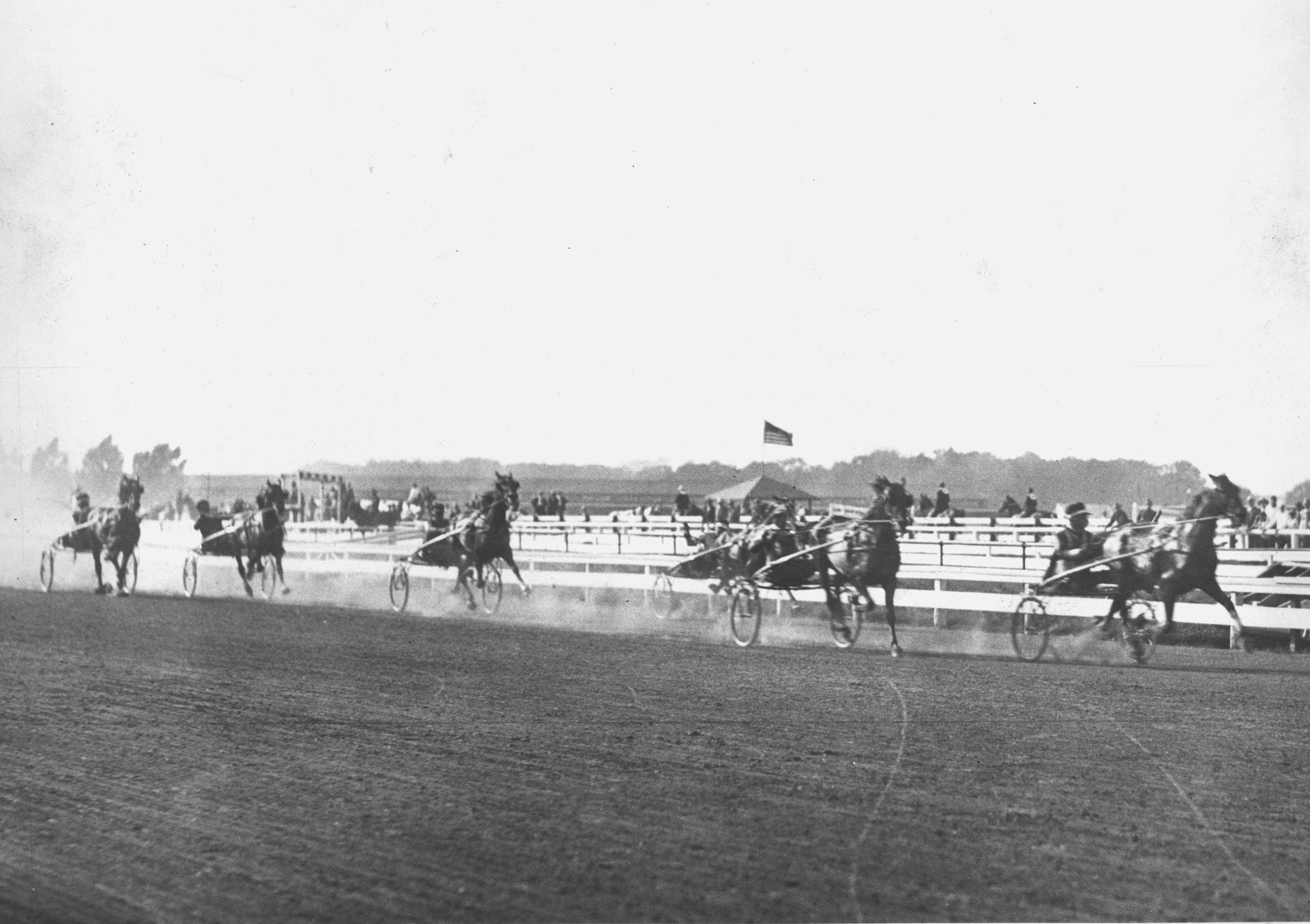
Lord Of Castleton
August 27, 1928
syracuse, ny
ny state fairgrounds
Purse $87,637
The year 1928 marked the first year that the name Castleton Farm appeared in the Hambletonian annals. The farm, outside Lexington, Kentucky, was owned by David Look at the time, and it would go on to become a leading breeder and owner of Hambletonian winners. The bay colt Spencer chased the best as a two-year-old; while he won a few stakes, it was Fireglow who was the top trotter among the juveniles. As three-year-olds, the two were again frequent foes until a frightful pile-up was caused by Fireglow in a race near Cleveland, Ohio. While Spencer quickly recovered from his injuries, Fireglow died two days afterward. Spencer prepped for the Hambletonian with a win and a second place finish in the Horse Review Stakes at Goshen before heading upstate to Syracuse for the big test. It was to be the high-headed, pure gaited Spencer’s shining day as he took both heats of the Hambletonian in stakes winning time. Spencer lived out his days as the premier stallion at Castleton Farm.
First of four Hambletonian winners owned by Castleton Farm. Castleton-owned fillies have also won the Oakes four times, including three of the first four years (1971, 1973, 1974). David Look, owner of Castleton, became the first breeder to raise and own a Hambletonian winner. New stake record in the opening heat of 2:02 1/2. Fireglow, pronounced by Walter Cox the greatest trotter he had ever trained, had been all but conceded the trophy when he died two weeks before the race from a mysterious poisoning following the frightful spill at North Randall Park outside of Cleveland. Some observers held Cox responsible for the accident in that race and suspected retribution for it was behind the horse's death. Spencer, a champion two-year-old of 1927, struggled in his return to the races the following year. His first start was the aforementioned Rainy Day Stake, which ended in a wreck. Though he won a heat of the Review at Goshen, he went into the Hambletonian winless in his sophomore year. Also sidelined due to injuries in that spill at North Randall was Spencer's trainer/driver Lon MacDonald, who engaged Bill Leese to drive the eventual winner. With only one start (1929) to his credit, MacDonald would never drive in another Hambletonian. He died two years later.
Media
Champions |1926-1939

Goshen’s Pride
October 8, 1929
Lexington, ky
The Red Mile
Purse $56,859.54
With a head of steam built up during a championship two-year-old season, the Hambletonian was all but conceded to Walter Dear in 1929. He won all six of his starts leading up to the big day in Lexington, the second year in which the Hambletonian was held a the historic oval. In two trips to the post on Hambletonian Day, Walter Dear was the best both times, and thus the coveted trophy was his. Walter Dear's owner, William Cane, also owned the fourth place finishing filly, Miss Woerner. After the Hambo, Walter Dear was sold at a big price to stand in Germany. He won the 1934 Prix D'Amerique and later disappeared when the Russian Army swept through Germany during World War II. Ther is no definitive word on what became of Walter Dear, though popular theories include him being smuggled back to the Soviet Union to improve the breeding stock. Others think the horse was secreted away to protect him, and may have died before the war was over. None of the theories have ever been proven.
The Hambletonian was postponed because of weather for the second time in three years and relocated to Lexington. The race date of October 8 is the latest the race has ever been contested. In an unparalleled accomplishment, horses prepared by Walter Cox (but dispersed to other barns because of the rules of the Lexington meeting) captured the first four monies in the summary placing: Walter Dear (Cox, 1-1); Volomite (Bill Leese, 2-2); Sir Guy Mac (Will Crozier, 3-7); and Miss Woerner (Harry Stokes, 8-3). The track rule allowed multiple entries from a trainer/driver’s stable to race uncoupled for wagering, but empowered the judges to designate the drivers on the other horses in the entry. Cox obviously wanted to name his own drivers, and the press and the public, from the accounts of the events, clearly understood that they were still Cox’s horses. The prior week, October 1, Cox’s "army" also took three of the first four monies in the Kentucky Futurity: Walter Dear (Cox, 1-1); Miss Woerner (Stokes, 2-2); and Volomite (Leese, 4-4). Walter Dear was the only winner that traced his paternal line to The Laurel Hall, a son of Peter The Great and a great great grandson of Hambletonian 10. He was also the first of the Peter The Great line in an era dominated by the Axworthy.
Media
Champions |1926-1939

A Triumph Of Breeding
august 27, 1930
goshen, ny
good time park
Purse $54,009.84
The foundation for the filly who won the 1930 Hambletonian was laid down at the time of the inaugural Hambo in 1926. It was that year that Lawrence B. Sheppard and C. N. Meyers purchased the entire horse population and farm that made up Hanover Shoe Farm in South Central Pennsylvania from Alexander B. Coxe. One of the mares that changed hands in that transaction was Miss Bertha Dillon. In 1927, Miss Bertha Dillon foaled the little bay filly named Hanover’s Bertha that terrorized the trotting ranks in 1929 and 1930. Already a champion at two, Hanover’s Bertha and her trainer Tom Berry were unbeatable at three until a team effort by competing horsemen forced her into a break in the first heat of the Hambo. She romped in the two remaining heats, leaving no doubt of her prowess over colts and fillies. Her feat is even more amazing because without a mobile starting gate, it took 16 attempts to get her winning second heat under way. With her daughter, Shirley Hanover, winning the 1937 Hambo, Hanover’s Bertha became the first winner, regardless of gender to produce another winner of that race.
The Hambletonian moved to William H. Cane’s three-cornered track, Good Time Park in Goshen New York. That remained its home until 1956. The race went three heats for the first time. The infamous start of the second heat was delayed 43 minutes with 26 recalls, as drivers employed a common tactic of the day, purposely scoring ahead of the "pole horse" (post position #1) to intentionally cause a recall and unsettle the other trotters, or get the advantage on the field at the start. Because of the delay, the Columbia Broadcasting Company could only do the second heat on their radio broadcast and were off the air by the time the horses came out for the third and final heat. The Geers Stake, named for Edward "Pop" Geers, one of the sport’s great horsemen, began as the 3-year-old pacing division of the Hambletonian with a guaranteed purse of $5,000. According to a booklet of eligibles published by the Hambletonian Society, "It was recognized that regardless of how highly they may be bred, nature has failed to endow a percentage of colts and fillies with real futurity trotting ability." Horses paid up on January 1, 1929 to the 1930 Hambletonian were eligible to compete in either race. The 1930 winner was Guy Britton (driven by Nat Ray), who also won the 3-year-old pacing division of the Kentucky Futurity. Today, though still owned by the Society but no longer a part of the Hambletonian, the Geers consists of four separate divisions for both colt and filly pacers as two and three-year-olds and, along with the Tompkins Memorials for trotters, is raced on the Grand Circuit at Scioto Downs.
Media
Champions |1926-1939
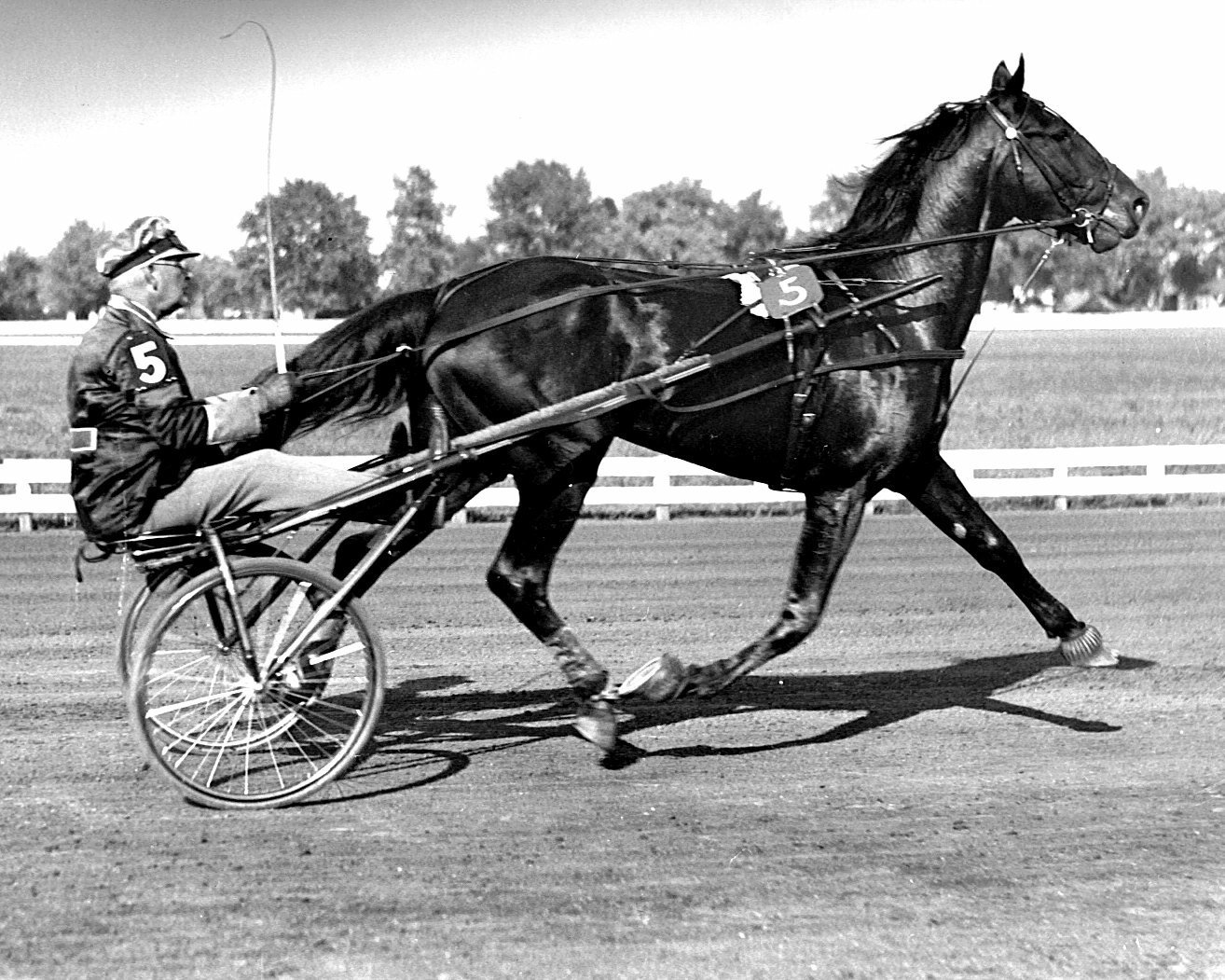
The Irony Of Fate
august 14, 1931
goshen, ny
good time park
Purse $48,071.39
The storied Calumet Farm is recognized as one of the premier thoroughbred breeding farms of modern times. However, it started as a standardbred nursery when it was founded by baking powder magnate William M. Wright. Mr. Wright’s homebred Calumet Butler was an unremarkable two-year-old, going the year without a single win. Sadly, over that winter, Mr. Wright suffered a stroke and slipped into a coma, never to see his horses race again. At three, Calumet Butler, with a pair of heat victories after a third place finish in the first heat, became the first maiden ever to win the Hambletonian. Mr. Wright died later that year, never knowing the glory of a Hambletonian win. His son and heir, Warren Wright, converted the farm to a thoroughbred nursery.
In an emotional victory for trainer and farm manager Dick McMahon and the Wright family, the Calumet hombred won as owner & farm founder William Monroe Wright lay in a coma on his deathbed. Wright was one of th founding driectors of the Hambletonian Society, and one of its first presidents (1926-1931). The smallest field (6) in Hambletonian history. The first of two maidens ever to win the Hambletonian, and those two heats remained the only victories of his career. McLin (1938) won a heat, but never a race prior to the Hambletonian. Calumet is one of only three farms to breed both a Hambletonian winner and a Kentucky Derby winner; the Lexington, KY. farm has bred nine Derby winners, itself a record. In addition, Almahurst and Stoner Creek [Stud], or their owners, have bred winners of both classics. Nedda Guy, the favorite owned by William H. Cane, was fifth the first heat and second the next. When scratched before the third heat, her backers in the auction pools objected so strongly that the filly had to be led out in front of the stands to prove her lameness. Her contribution to the sport came later as the granddam of the world champion pacer Good Time.
Media
Champions |1926-1939
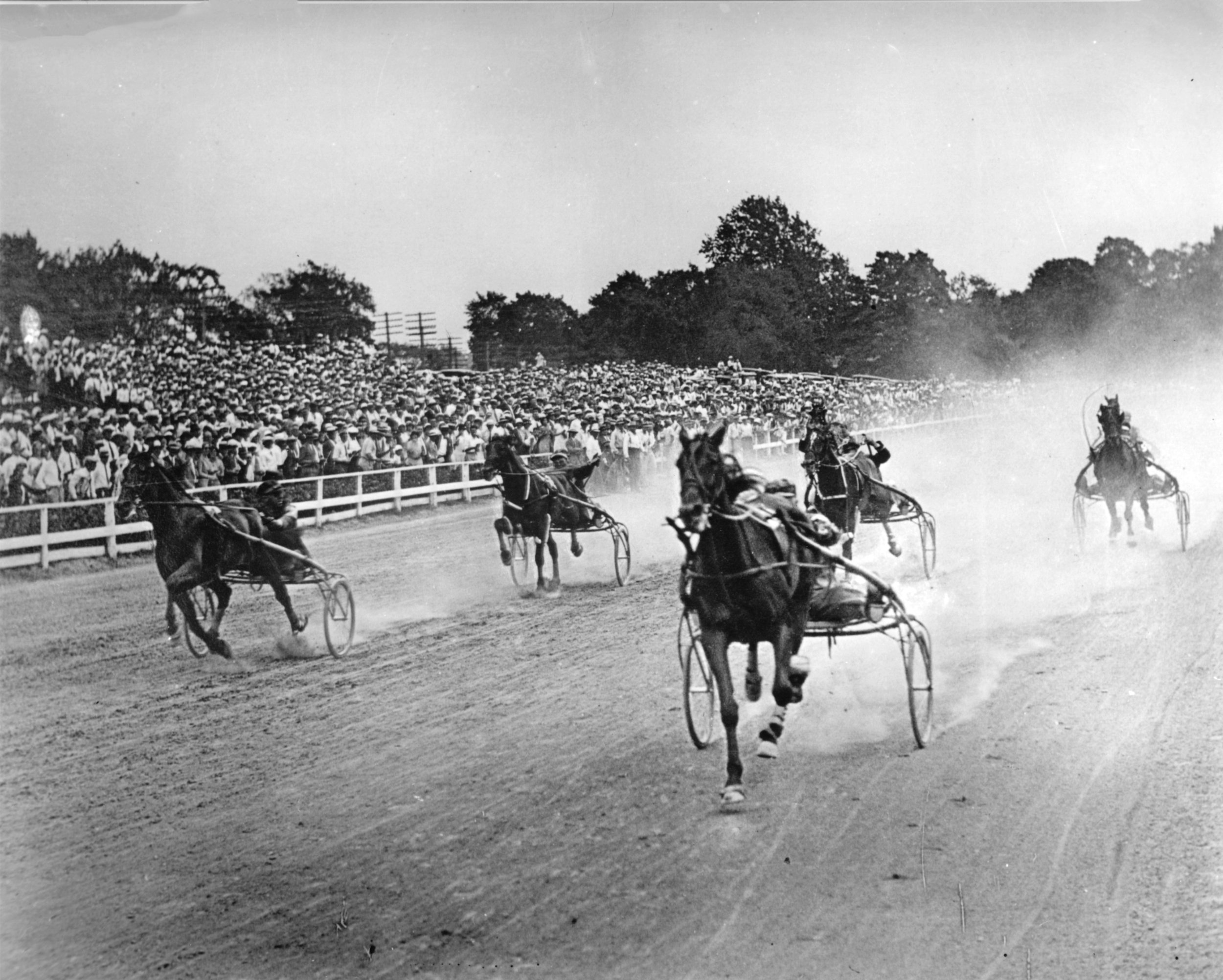
The Sister’s Revenge
august 14, 1932
goshen, ny
good time park
Purse $45,489.26
Will Caton, the trainer of 1932 Hambletonian winner The Marchioness, first came to prominence as a trainer and driver in Czarist Russia. For many years prior to World War I and the 1917 Bolshevik revolution, Caton was the tops on that scene. However, his life’s work was swept away in the revolution and he returned to his native United States to ply his trade. Caton had great success in the early thirties with the trotter Protector, he won virtually every stake but the Hambletonian, as he had not been kept eligible. He promptly set about a course to win the 1932 Hambletonian with Protector’s full sister, The Marchioness, who was kept eligible to the big race. A top filly from the start of her career, The Marchioness, given the chance her brother never had, won a four heat struggle to take the Hambletonian trophy. Purchased that fall by Count Orsi Mangelli of Italy, she never produced a foal that could duplicate her speed or stamina.
First race-off in which the three different heat winners had to contest a fourth heat to determine a winner. Although he did not win the day, Hollyrood Dennis (Will Crozier) won the second heat in a new stake record of 2:01 1/4. That record would stand for 15 years. Prior to the Russian revolution, Caton had been the leading trainer and driver of the Czarist empire. His American methods and imports of American horses completely changed the Russian trotting scene. As a charitable endeavor, the 1932 Grand Circuit meeting at Good Time Park benefited the Goshen Hospital.
Media
Champions |1926-1939
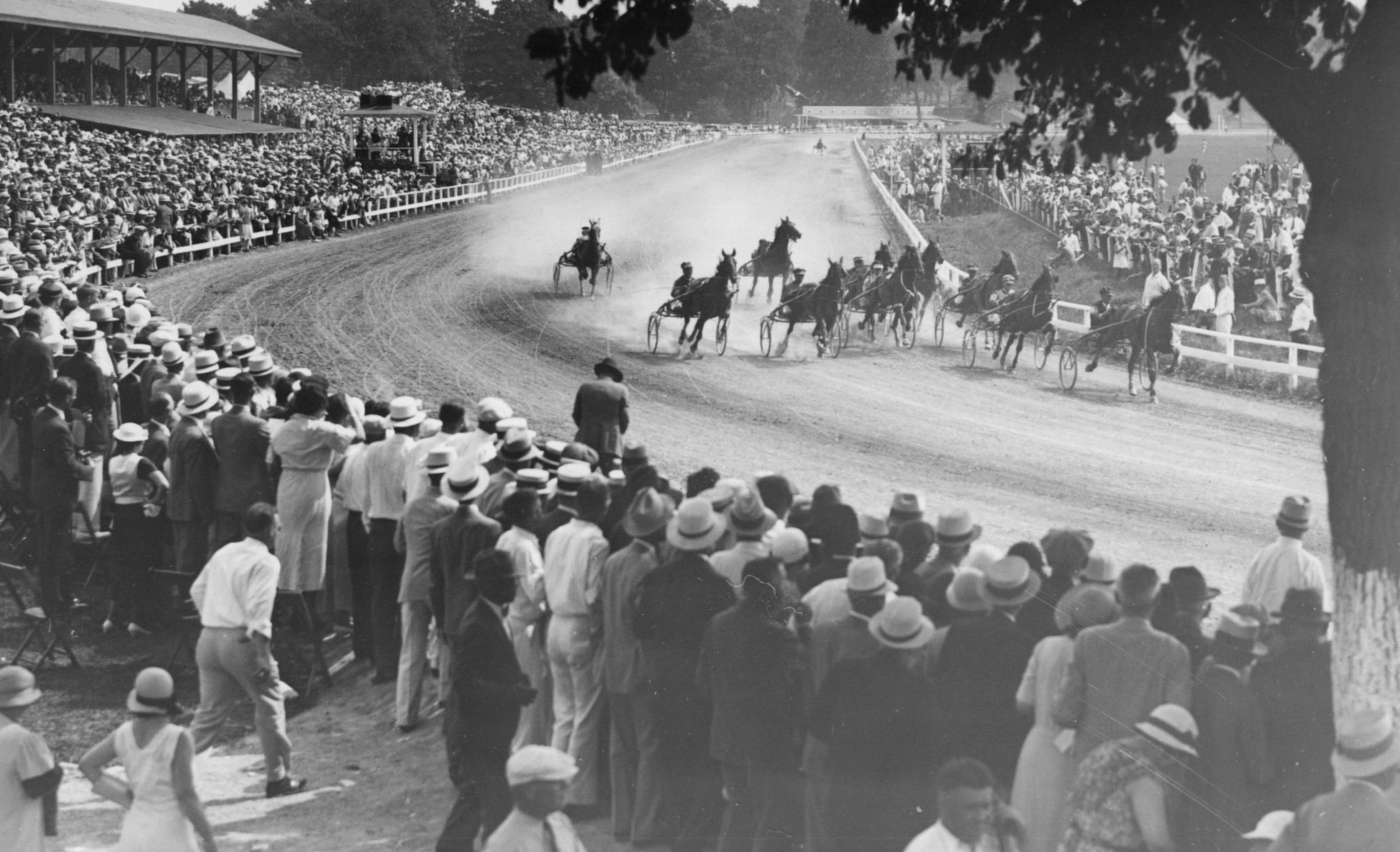
keep on rollin’
august 16, 1933
goshen, ny
good time park
Purse $37,612
William N. Reynolds of Winston-Salem, North Carolina, was one of the leading breeders and owners in harness racing until his death in 1951. Chairman of the Board of Reynolds Tobacco, Reynolds sent his homebred filly Mary Reynolds to the care of trainer Ben White as a yearling. The filly was campaigned lightly at two and wound up the year by winning a heat of the Kentucky Futurity, which was then a two-year-old event. Her three-year-old season set her up as a contender for the Hambo, with several stakes wins and placings to her credit. With a pair of wins and a second on Hambletonian Day, she became the third filly in just eight years to take that classic. Mary Reynolds was unraced at four, but came back to race as a five-year-old before beginning her broodmare career. She was the dam of several stakes winners before she was exported to Europe.
Brown Berry, winner of the second heat and favorite in the final heat, was in the lead and fell to his knees just yards from the finish line. The turf journals of the day recounted it as the "$25,000 stumble." Fred Egan, the trainer/driver of Brown Berry was unseated, but managed to straddle the sulky, his elbow over one shaft, his knees across the other, and finished 11th in the race salvaging second money under the placing system (2-1-11). Mary Reynolds became the only winner that traces her paternal line to Peter The Brewer, a son of Peter The Great and a great-great-grandson of Hambletonian 10. Possibly the first newsreel coverage of the Hambletonian.
Media
Champions |1926-1939
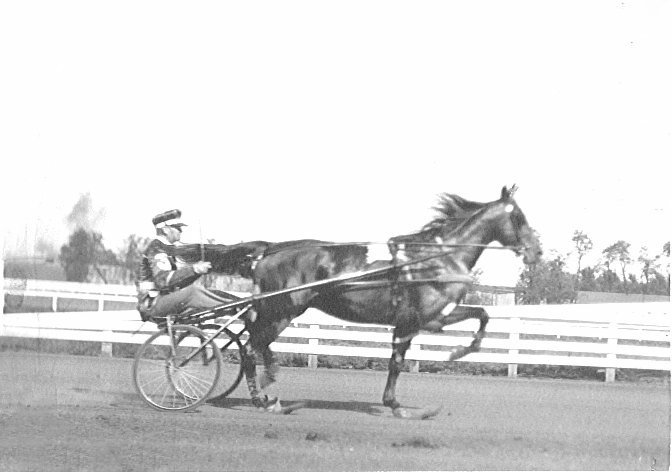
Last Of The Guy Axworthy’s
august 15, 1934
goshen, ny
good time park
Purse $22,994
One of the remarkable attributes of the great progenitors of the standardbred is their ability to sire outstanding performers at an advanced age. The longtime premier of Walnut Hall Farm, Guy Axworthy, outdid them all by siring a Hambletonian winner at the venerable age of twenty-eight. For many years, Guy Axworthy was the undisputed king of stakes sires. Guy Axworthy had started the ball rolling for the Hambletonian by siring both the winner and runner-up in the first two Hambletonians. Thereafter three others of the get of Guy Axworthy had taken down second honors, but the victory of his son Lord Jim, from his final crop, in 1934, put Guy Axworthy again in the lead for winners, not to be surpassed until 1947 when Scotland sent out his fourth winner. Lord Jim was owned by E. L. Mefford of Columbus, Ohio, and the reinsman that brought the Guy Axworthy colt to prominence was the youngest thus far to succeed in winning the coveted classic, Dr. Hugh Parshall of Urbana, Ohio. For a period of a dozen years or so "Doc" Parshall was usually the leading race-winning driver in the United States. Lord Jim was rightly regarded as one of the best juveniles of his season. A winner early, the colt also won at Columbus, Indianapolis and Nashville and wound up by beating Bertha C. Hanover, trotting a final quarter in :29. However, Lord Jim’s Hambletonian rating was not high early in the season; the Guy Axworthy colt raced in aged events, cutting only a slight figure. The first heat of the Hambletonian found Princess Peg whipping the field from well back. The next mile "Doc" Parshall had Lord Jim on edge and the colt held off Princess Peg in 2:02¾. Muscletone, driven by Daryl Parshall, stole off to a long lead in the third and won in 2:04¼. Lord Jim moved from the three-quarters to win the fourth heat from Muscletone in 2:04¼. The colt was later sold back to Walnut Hall to emulate, if possible, the speed-siring feats of his sire. However, though a speedy and game colt trotter, Lord Jim did not make the grade in Kentucky, though siring several fast performers.
The Parshall entry finished "one-two" in a fourth heat race-off (and in the summary placing) for the smallest purse ever ($25,845) in the Hambletonian. The entry earned $17,485. The least expensive yearling ever sold at public auction to win the Hambletonian. At 34, Parshall was the youngest winning trainer/driver of that time in an era when it was commonly thought a horseman needed to be 50 years of age to be considered capable of handling a trotter. The average age of a winning driver prior to the race moving to the Meadowlands was 50. During its 17 years at the Meadowlands, the average age has lowered to 40 years old. Parshall had served notice by finishing second in the final heat in 1933. Lord Jim was the last winner by Guy Axworthy, conceived when the horse was 28-years-old, the oldest stallion ever to sire a Hambletonian winner. The mare Selka was 16 when Lord Jim was foaled. Parshall’s brother, Daryl, finished second with Muscletone in the final (after winning the controversial third heat). Muscletone would later become a great champion in European trotting, winning both the 1935 and 1937 editions of the Prix d’Amerique.
Media
Champions |1926-1939
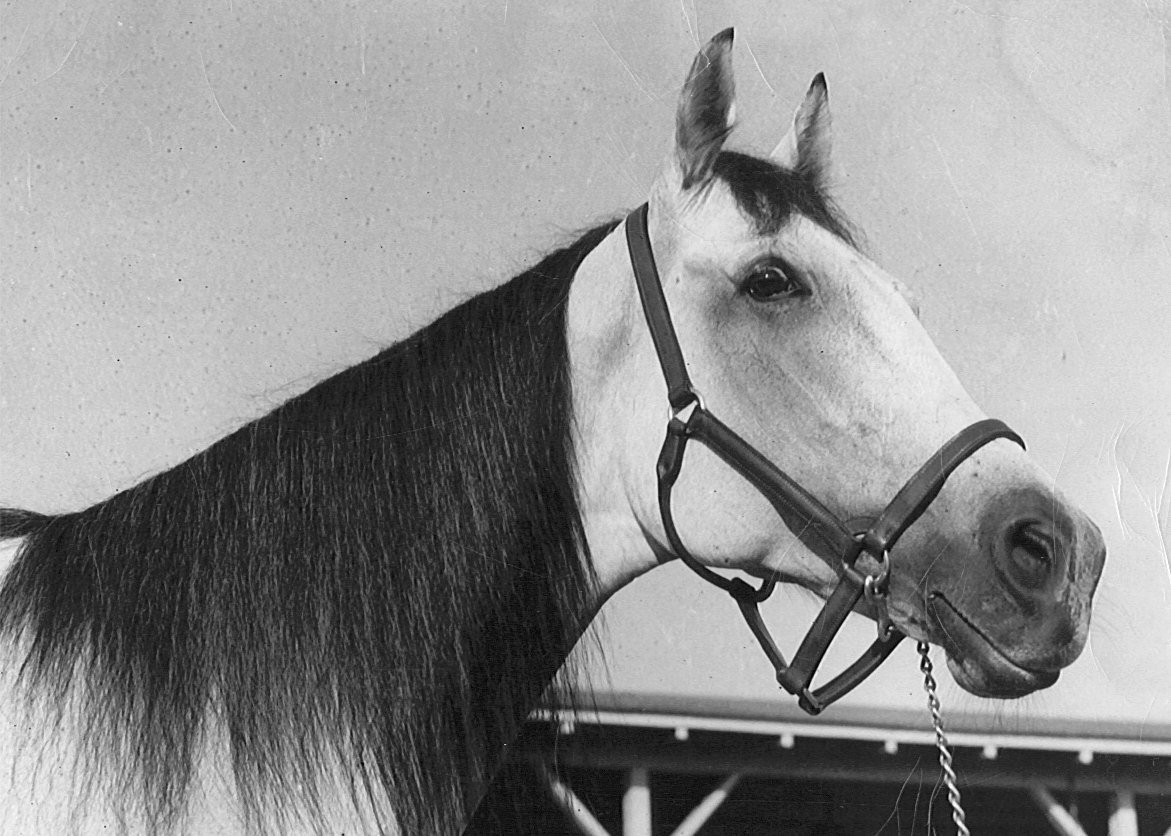
The Trotting King
august 14, 1935
goshen, ny
good time park
Purse $30,471
Most spectacular of Hambletonian winners and the greatest to ever capture the victor’s laurels at Goshen was the majestic grey gelding, Greyhound. Greyhound was the idol of the harness racing crowds during his star-studded campaigns through the Grand Circuit. As Greyhound grew older, his coat became almost pure white, giving further strength to his apt nickname "The Grey Ghost." To list his world records and phenomenal performances would take pages. Bred at Almahurst Farm by Henry Knight, Greyhound was Sep Palin's masterpiece. The tall Hoosier horseman and the leggy, gangling youngster developed into a virtually unbeatable team. The Hambletonian represented his richest triumph. Both miles Palin rated the favorite far back until the five-eighths, then set sail with those tremendous, space-devouring strides to swirl past the field. The first mile in 2:02¼, last half timed better than :59 set a new record for the race, the 2:02¾ second heat making it the fastest race to date. Greyhound was in the headlines steadily from that time on. To many, the most unforgettable feat of Greyhound’s were the team miles he trotted with Rosalind 1:56¾, the World Champion trotting mare and winner of the 1936 Hambletonian. Both victors in America’s most coveted harness classic, the fastest and second fastest trotter in the world combined to trot a marvelous mile in 1:58¼, a mark that many thought would never be surpassed. Greyhound spent his retirement years at the farm of his owner, E.J. Baker in St. Charles, Il.
One of the greatest horses of all time was also the first gelding winner. The only gray to ever win the Hambletonian. A $900 yearling purchase at the Indianapolis Speed Sale; about $11,382 in 1999 dollars. The sale average was only $410. As an older horse Greyhound set a world record for a trotter of 1:55 1/4 that stood for 32 years (1938 to 1969). At one time he held a total of 14 world records including: "under-saddle" (2:01 3/4) and was paired "team-to-pole" with the 1936 Hambletonian winner Rosalind (1:58 1/4). Indicative of the trotting economy of the time, Greyhound earned $38,952 in seven years of racing (1934-1940), earning almost half ($18,804) in the Hambletonian.
Media
Champions |1926-1939
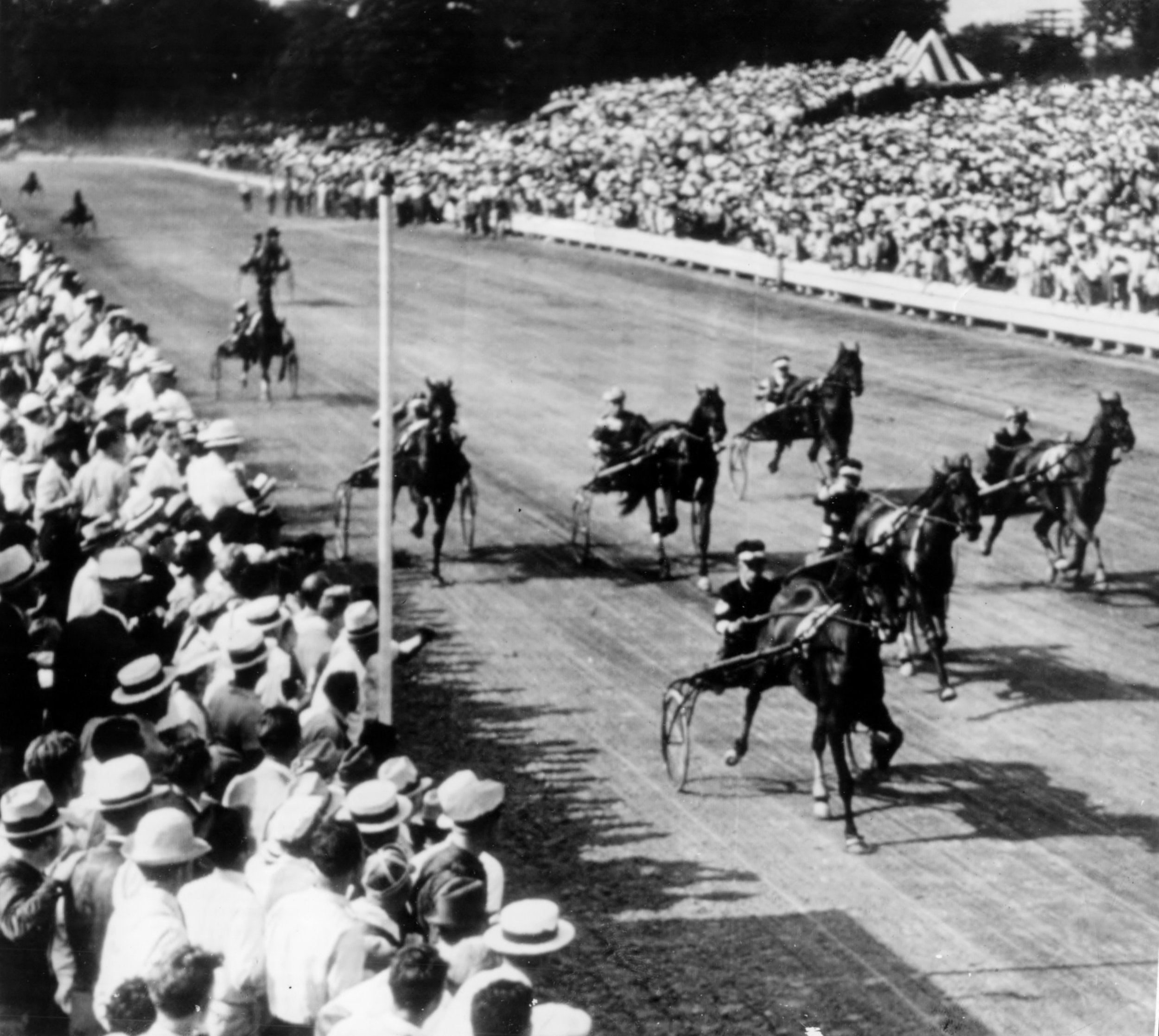
A Family Affair
august 12, 1936
goshen, ny
good time park
Purse $33,943.83
Rosalind, the sturdy daughter of Scotland and Alma Lee, represented the culmination of Ben White’s career as a trainer and driver. The soft-spoken Canadian with the magic feather touch on the reins brought out many champions and scored his second Hambletonian win with Rosalind, making him the first driver to score twice. Not only did Ben White train and drive this fabulous filly, he bred her as well and gave her to his son, Gibson, as an incentive to recover from a serious illness. There is no question that the medicine worked, as Gibson White later became his father’s assistant trainer and a winning driver in Grand Circuit competition. Victorious in six of her 10 starts at two, Rosalind clinched the two-year-old title decisively when she triumphed in the Junior Kentucky Futurity in a sparkling 2:03. The next year Rosalind won seven of her eight stakes engagements, her sole loss being to a stable mate. In the Hambletonian it was strictly a case of Rosalind first, and the rest nowhere, as Ben White moved his son’s filly right to the top and held sway thereafter, the best mile in 2:01¾, a stake mark. Gib White smilingly joined his father in the winner’s circle with the crowd wildly cheering the popular victory. The story of filly’s victory and Gib’s recovery are recounted in the Marguerite Henry classic, Born to Trot.
Ben White became the first and only breeder to also train and drive the winner. Mal Burroughs drove but did not train his homebred Malabar Man in 1997. Stanley Dancer was co-breeder of Egyptian Candor (1965), a horse he trained but did not drive. Trainer/driver Howard Beissinger’s wife, Ann, was the breeder of record on Speedy Crown (1971). Ben White gave the filly to his son "Gib" who was ill with tuberculosis and the boy’s enthusiastic interest in the filly was credited in part with his eventual recovery. The story of Rosalind and her young owner later became the subject of Marguerite Henry’s book Born To Trot. Attendance reported at nearly 45,000 may have been the largest crowd ever for a Hambletonian.
Media
Champions |1926-1939
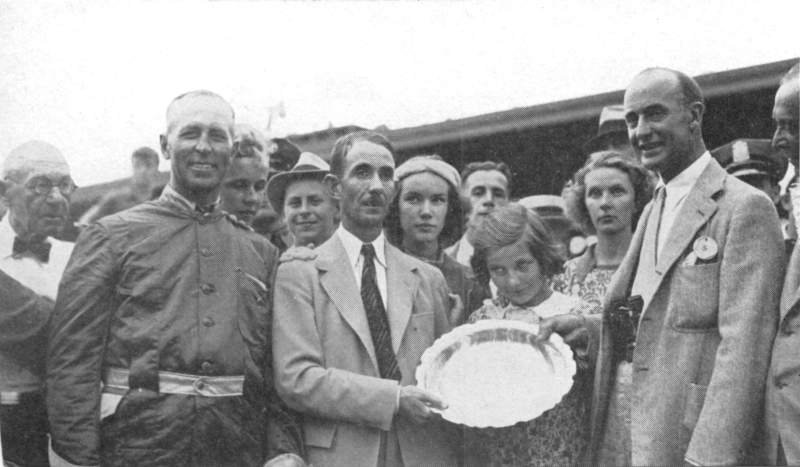
When the Chips Were Down
august 12, 1937
goshen, ny
good time park
Purse $36,212.59
Shirley Hanover was bred to be a champion. Her dam was two-time World Champion Hanover’s Bertha, Hanover Shoe Farms’ first Hambletonian winner, and her sire, Mr. McElwyn, was himself three-time World Champion. She inherited the speed of her parents, but was handicapped throughout her career with bad manners. In the hands of Henry Thomas, Shirley Hanover was one of the fastest youngsters in the Hanover string. Among her victories were the Review and Horseman Futurities. Her manners showed in the American Stake when she reared at the start and went down, knocking her wind out. Carefully schooled for the big stakes at Goshen, Hambletonian Day found Shirley in perfect stakes form and she carried the orange and blue colors to an upset victory in record time. That moment of glory was to be her last start. As a broodmare, Shirley Hanover produced the double-gaited Hava Hanover and Reine Hanover, but never foaled a performer comparable to herself.
The only winner whose dam, Hanover’s Bertha (1930), was also a Hambletonian winner. Shirley Hanover’s granddam was Miss Bertha Dillon, considered the foundation mare of Hanover Shoe Farms. After twenty minutes and six recalls in the first heat, starter Steve Phillips ordered Dunbar Bostwick on Hollyrood Audrey 2nd and H. M. Parshall on Delphia Hanover to replace themselves with other drivers. The violation: scoring ahead of the pole horse. Harry Whitney replaced Bostwick and Charlie Lacey took the place of Parshall, though Lacey was taken off for Leo Fleisch in the second heat. The first heat got away on the tenth score. Eight of the twelve starters, or two-thirds of the field, were fillies, the highest proportion ever in a Hambletonian. Fifty percent or more of the field has been fillies in seven different years; all prior to 1937. A record eight fillies were also entered in the 1949 edition. First post-race saliva test in a Hambletonian.
Media
Champions |1926-1939

Two In A Row
august 10, 1938
goshen, ny
good time park
Purse $36,262.37
Hanover Shoe Farms was back in the winner’s circle again at Goshen in 1938 as the newly purchased McLin Hanover shut out the field in straight heats. He brought honors for the second straight year to his owners, driver Henry Thomas and his sire, Mr. McElwyn, also at Hanover. The 1938 winner was bred by William H. Cane, Master of Good Time Park and was out of Ethelinda, the three-year-old champion of her day. McLin, as he was called before his purchase, proved a bitter disappointment at two, wild breaks putting him far back in his few starts. However, he was kept up in the stakes as he had demonstrated extreme speed. At Agawam, Mass., the colt skyrocketed to prominence in the American Stake. In the second heat over a slow track he came from far back at a speedy clip, swept past the favored Long Key only to make a break with victory in his grasp. The final mile Carl Dill handled McLin with kid gloves, bringing him out in the middle of the track to sprint home. Lawrence Sheppard then stepped in and bought the colt for $25,000 from Mr. Cane, having already been impressed by his remarkable speed flights in training. The same schooling process that had been employed with Shirley Hanover was next used on McLin at Goshen. The colt learned to take off like a bullet and keep his feet on the sprint for the first turn. Though his supporters were nervous, the Hambletonian proved anti-climactic. Henry Thomas used the unbeatable formula of getting away on top and improving his position and the colt was never threatened, winning both heats by open lengths. McLin Hanover was sold to Italy that fall and proved to be an oustanding sire.
Hanover Shoe Farms (Lawrence B. Sheppard et al) won back-to-back Hambletonians, becoming the first ownership to do so. Sheppard purchased McLin (later renamed McLin Hanover) a week before the race from William H. Cane for a reported $20,000, (his earnings for the day: $19,944.30) with an additional $5,000 due if the colt won the Hambletonian Stake. During that era of heat racing McLin had won only one heat in his career, and had yet to win a race. Henry Thomas was also the first trainer/driver to win two consecutive Hambletonians. McLin was the fifth and last winner sired by a Calumet stallion. The Dutchess, owned by Italian Count Paolo Mangelli (the father of Orsi Mangelli) and driven by Will Caton, became the first European-owned horse to start in the Hambletonian. She finished 4-10 in the two heats. Post time for the second and final heat was moved forward to accommodate the National Broadcasting Company nation-wide radio hookup, with Clem McCarthy providing the call and the commentary as he had in previous years.
Media
Champions |1926-1939
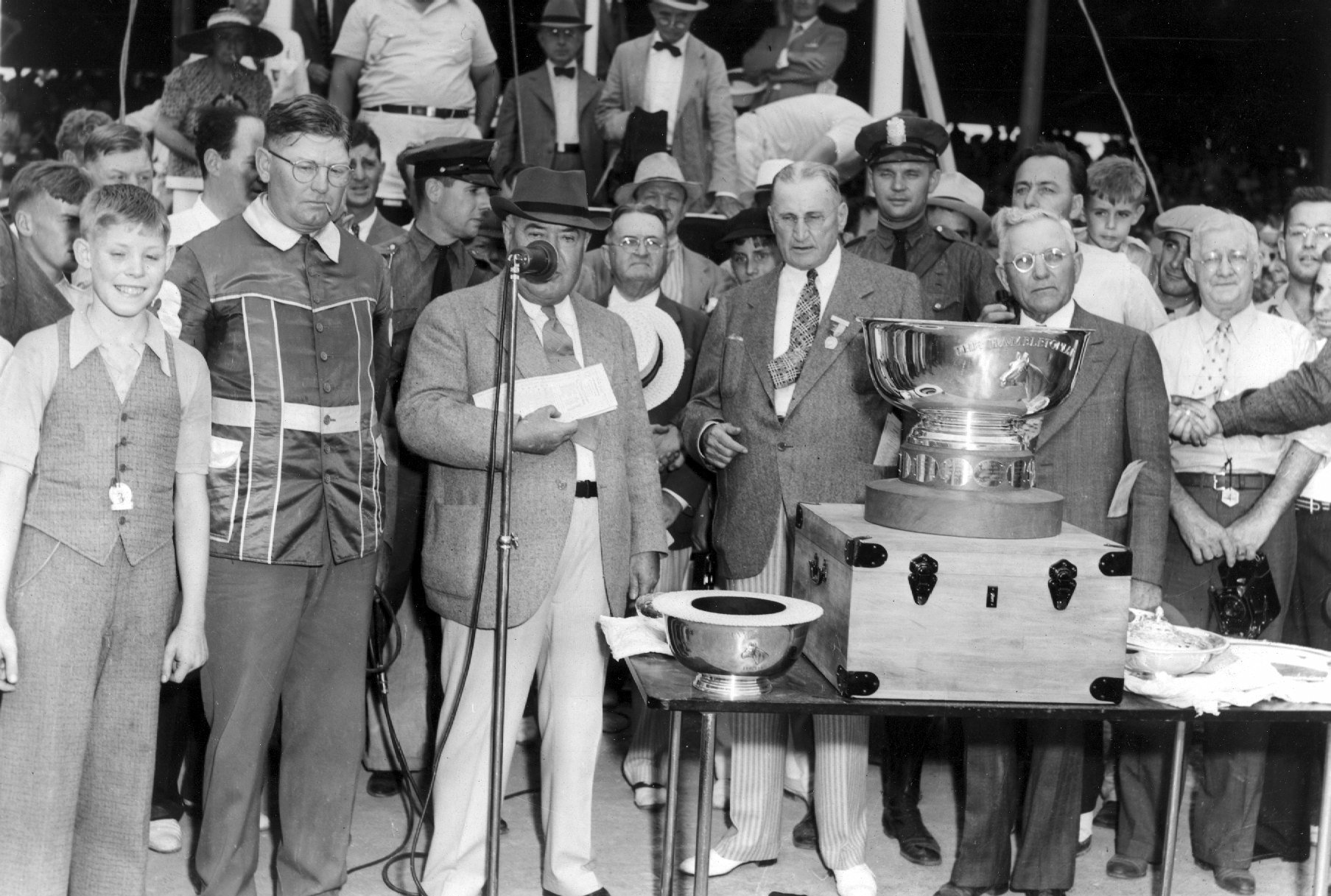
The Doctor’s Dream
august 9, 1938
goshen, ny
good time park
Purse $38,802.46
Dr. L. M. Guilinger of Andover, Ohio, owner of the 1939 Hambletonian winner, was a country doctor who, in the early years of his practice, always had a fast-stepping road horse to carry him to the bedside of the suffering. Even with the advent of the automobile Dr. Guilinger kept his horses, but when the automobile became a real necessity switched his interest to owning harness horses for the track. He entrusted a couple to "Doc" Parshall and the doctor decided to take a flyer in the stakes field, though with some misgivings as to what his many patients would think of the wisdom of paying the $3,250 that Peter Astra cost as a yearling. As it turned out he need not have worried. Peter Astra had a veritable victory parade at three. With Nibble Hanover sidelined by sickness, the Peter Volo colt turned on his sweeping long stride whenever needed to win every engagement. The Hambletonian was won with complete ease, much to the pleasure of his owner. The colt then won at Springfield, Syracuse, and Lexington, winning more Grand Circuit stakes than any other three-year-old had ever done. Retired to stud at Gainesway Farm, Peter Astra sired 2:05 performers at both gaits, but never came close to sending out his successor for the classic contests.
Peter Astra’s margin of victory in the deciding heat was reported to be a Hambletonian record of "a half dozen lengths" in an era before the photo finish and official charting. Prior to 1939 individual trophies were presented. The present Hambletonian trophy, a 19-inch Revere Bowl on a tiered pedestal, was created in 1939 by the Park Avenue (New York) firm of Warren D. Perry. The trophy used to go to the winning owner for the year (see 1954), but because of its value (last appraised at approximately $60,000) and high insurance costs, the trophy now stays in the trophy case on the clubhouse level of the Meadowlands. It is displayed during the Hambletonian festivities. Replicas are provided for the winning connections by the racetrack. Upon the $3,250 purchase of Peter Astra, Dr. Gullinger made a special request to the correspondent from The Harness Horse, "I just bought a colt and I wish you would keep my name out of The Harness Horse as owner until I advise you otherwise. If the people back home would know what I paid, they would conclude that I was either out of my mind or had saved up enough money that I did not need any more, consequently some of my patients might think it unnecessary to pay for services rendered." The product of a May-December equine mating, Peter Astra was from the 21st and last full crop of foals of the 24-year-old stallion Peter Volo. The cross of the venerable Walnut Hall patriarch Peter Volo and three-year-old Astra produced a Hambletonian winner.
Media
Champions |1926-1939

